Quick filters:
Meiji palace Stock Photos and Images
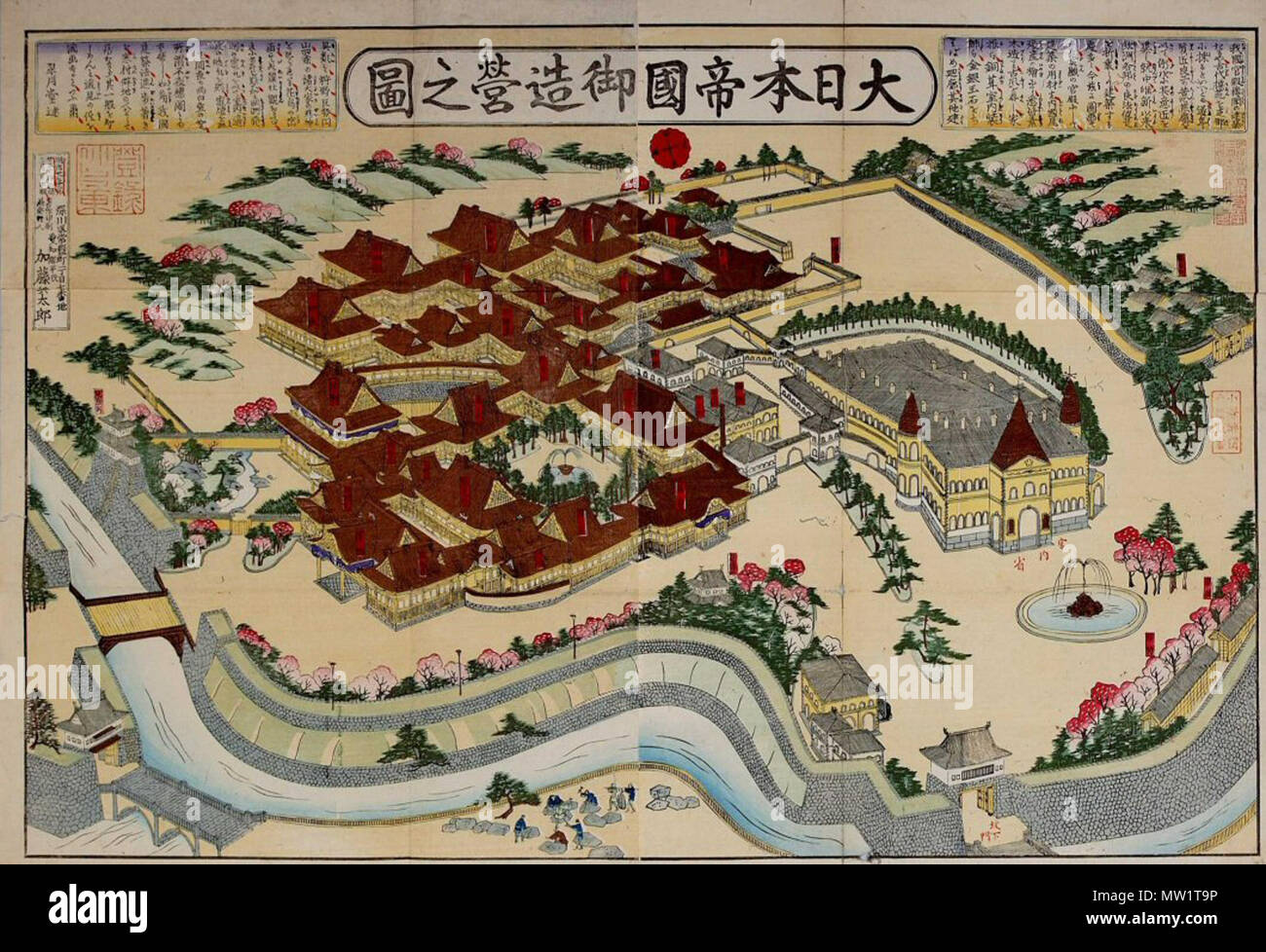 . English: Bird's-eye view of the Meiji palace which was completed in October 1888. 日本語: 大日本帝国御造営之図 加藤兵太郎著 翠月堂詞書 明治21(1888)刊 加藤兵太郎 請求記号:加2087 . 19th century. Ukiyo-e artist 609 Tokyo Imperial Palace pic 08 Stock Photohttps://www.alamy.com/image-license-details/?v=1https://www.alamy.com/english-birds-eye-view-of-the-meiji-palace-which-was-completed-in-october-1888-211888-2087-19th-century-ukiyo-e-artist-609-tokyo-imperial-palace-pic-08-image187511122.html
. English: Bird's-eye view of the Meiji palace which was completed in October 1888. 日本語: 大日本帝国御造営之図 加藤兵太郎著 翠月堂詞書 明治21(1888)刊 加藤兵太郎 請求記号:加2087 . 19th century. Ukiyo-e artist 609 Tokyo Imperial Palace pic 08 Stock Photohttps://www.alamy.com/image-license-details/?v=1https://www.alamy.com/english-birds-eye-view-of-the-meiji-palace-which-was-completed-in-october-1888-211888-2087-19th-century-ukiyo-e-artist-609-tokyo-imperial-palace-pic-08-image187511122.htmlRMMW1T9P–. English: Bird's-eye view of the Meiji palace which was completed in October 1888. 日本語: 大日本帝国御造営之図 加藤兵太郎著 翠月堂詞書 明治21(1888)刊 加藤兵太郎 請求記号:加2087 . 19th century. Ukiyo-e artist 609 Tokyo Imperial Palace pic 08
![[ 1900s Japan - Western-style Hotel, Yokohama ] — The Oriental Palace Hotel on Kaigaindori in Yokohama, Kanagawa Prefecture. Located near the French Pier (フランス波止場, Furansu Hatoba), it was opened in 1903 (Meiji 36) and ran until it was destroyed by the Great Kanto Earthquake of September 1, 1923 (Taisho 12). 20th century vintage postcard. Stock Photo [ 1900s Japan - Western-style Hotel, Yokohama ] — The Oriental Palace Hotel on Kaigaindori in Yokohama, Kanagawa Prefecture. Located near the French Pier (フランス波止場, Furansu Hatoba), it was opened in 1903 (Meiji 36) and ran until it was destroyed by the Great Kanto Earthquake of September 1, 1923 (Taisho 12). 20th century vintage postcard. Stock Photo](https://c8.alamy.com/comp/2BKRTMT/1900s-japan-western-style-hotel-yokohama-the-oriental-palace-hotel-on-kaigaindori-in-yokohama-kanagawa-prefecture-located-near-the-french-pier-furansu-hatoba-it-was-opened-in-1903-meiji-36-and-ran-until-it-was-destroyed-by-the-great-kanto-earthquake-of-september-1-1923-taisho-12-20th-century-vintage-postcard-2BKRTMT.jpg) [ 1900s Japan - Western-style Hotel, Yokohama ] — The Oriental Palace Hotel on Kaigaindori in Yokohama, Kanagawa Prefecture. Located near the French Pier (フランス波止場, Furansu Hatoba), it was opened in 1903 (Meiji 36) and ran until it was destroyed by the Great Kanto Earthquake of September 1, 1923 (Taisho 12). 20th century vintage postcard. Stock Photohttps://www.alamy.com/image-license-details/?v=1https://www.alamy.com/1900s-japan-western-style-hotel-yokohama-the-oriental-palace-hotel-on-kaigaindori-in-yokohama-kanagawa-prefecture-located-near-the-french-pier-furansu-hatoba-it-was-opened-in-1903-meiji-36-and-ran-until-it-was-destroyed-by-the-great-kanto-earthquake-of-september-1-1923-taisho-12-20th-century-vintage-postcard-image356410120.html
[ 1900s Japan - Western-style Hotel, Yokohama ] — The Oriental Palace Hotel on Kaigaindori in Yokohama, Kanagawa Prefecture. Located near the French Pier (フランス波止場, Furansu Hatoba), it was opened in 1903 (Meiji 36) and ran until it was destroyed by the Great Kanto Earthquake of September 1, 1923 (Taisho 12). 20th century vintage postcard. Stock Photohttps://www.alamy.com/image-license-details/?v=1https://www.alamy.com/1900s-japan-western-style-hotel-yokohama-the-oriental-palace-hotel-on-kaigaindori-in-yokohama-kanagawa-prefecture-located-near-the-french-pier-furansu-hatoba-it-was-opened-in-1903-meiji-36-and-ran-until-it-was-destroyed-by-the-great-kanto-earthquake-of-september-1-1923-taisho-12-20th-century-vintage-postcard-image356410120.htmlRM2BKRTMT–[ 1900s Japan - Western-style Hotel, Yokohama ] — The Oriental Palace Hotel on Kaigaindori in Yokohama, Kanagawa Prefecture. Located near the French Pier (フランス波止場, Furansu Hatoba), it was opened in 1903 (Meiji 36) and ran until it was destroyed by the Great Kanto Earthquake of September 1, 1923 (Taisho 12). 20th century vintage postcard.
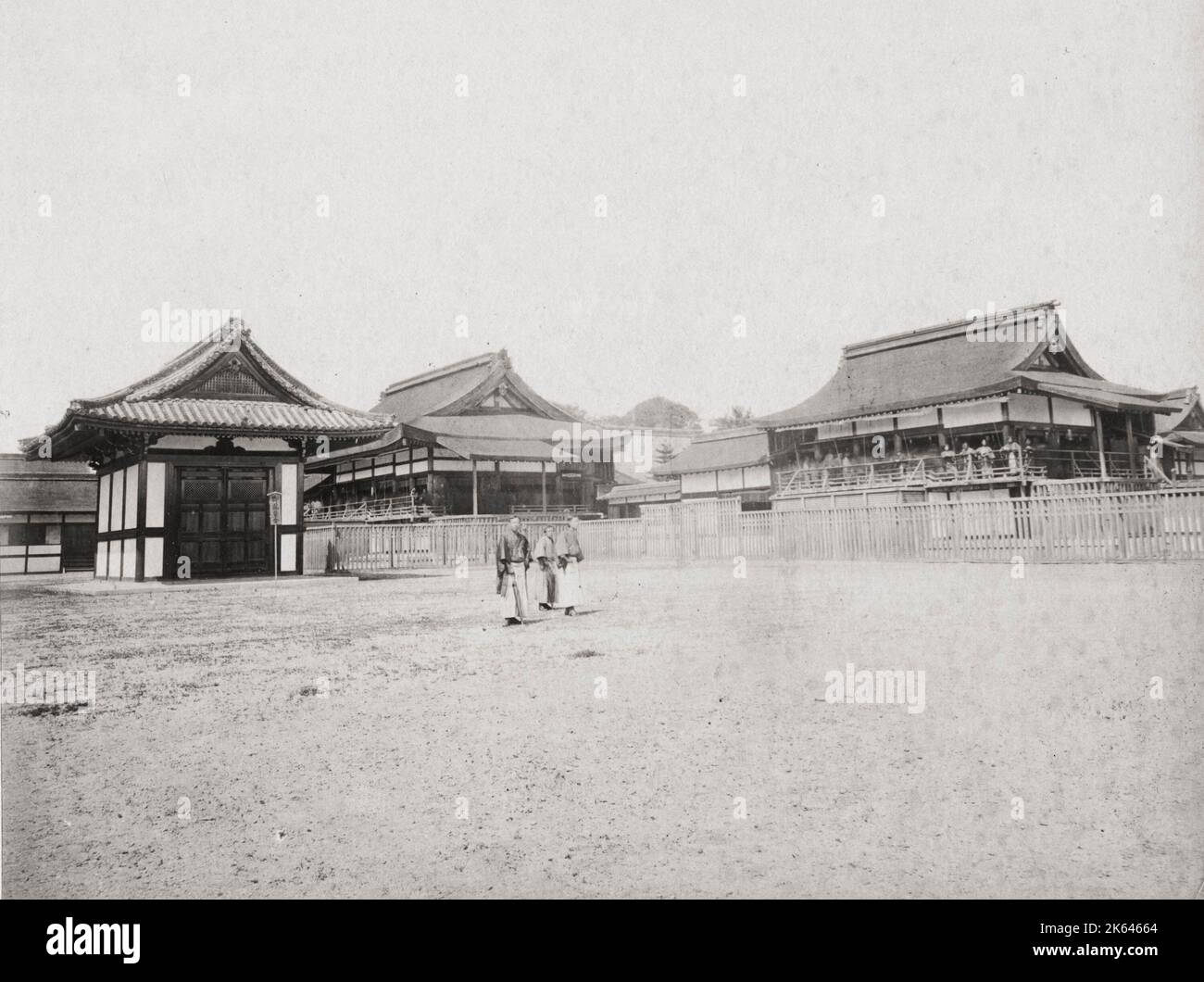 19th century vintage photograph: The Kyoto Imperial Palace is the former ruling palace of the Emperor of Japan. Since the Meiji Restoration in 1869, the Emperors have resided at the Tokyo Imperial Palace, while the preservation of the Kyoto Imperial Palace was ordered in 1877. Stock Photohttps://www.alamy.com/image-license-details/?v=1https://www.alamy.com/19th-century-vintage-photograph-the-kyoto-imperial-palace-is-the-former-ruling-palace-of-the-emperor-of-japan-since-the-meiji-restoration-in-1869-the-emperors-have-resided-at-the-tokyo-imperial-palace-while-the-preservation-of-the-kyoto-imperial-palace-was-ordered-in-1877-image485670924.html
19th century vintage photograph: The Kyoto Imperial Palace is the former ruling palace of the Emperor of Japan. Since the Meiji Restoration in 1869, the Emperors have resided at the Tokyo Imperial Palace, while the preservation of the Kyoto Imperial Palace was ordered in 1877. Stock Photohttps://www.alamy.com/image-license-details/?v=1https://www.alamy.com/19th-century-vintage-photograph-the-kyoto-imperial-palace-is-the-former-ruling-palace-of-the-emperor-of-japan-since-the-meiji-restoration-in-1869-the-emperors-have-resided-at-the-tokyo-imperial-palace-while-the-preservation-of-the-kyoto-imperial-palace-was-ordered-in-1877-image485670924.htmlRM2K64664–19th century vintage photograph: The Kyoto Imperial Palace is the former ruling palace of the Emperor of Japan. Since the Meiji Restoration in 1869, the Emperors have resided at the Tokyo Imperial Palace, while the preservation of the Kyoto Imperial Palace was ordered in 1877.
 Snow in the Garden, from the Chiyoda Inner Palace, Chikanobu, Japanese, Woodblock print, Japan, 1897, Meiji Period, 13 7/8 x 9 1/4 in., 35.2 x 23.5 cm, kimono, ladies, Leisure, Nature, Outdoors, Season, winter Stock Photohttps://www.alamy.com/image-license-details/?v=1https://www.alamy.com/snow-in-the-garden-from-the-chiyoda-inner-palace-chikanobu-japanese-woodblock-print-japan-1897-meiji-period-13-78-x-9-14-in-352-x-235-cm-kimono-ladies-leisure-nature-outdoors-season-winter-image454281430.html
Snow in the Garden, from the Chiyoda Inner Palace, Chikanobu, Japanese, Woodblock print, Japan, 1897, Meiji Period, 13 7/8 x 9 1/4 in., 35.2 x 23.5 cm, kimono, ladies, Leisure, Nature, Outdoors, Season, winter Stock Photohttps://www.alamy.com/image-license-details/?v=1https://www.alamy.com/snow-in-the-garden-from-the-chiyoda-inner-palace-chikanobu-japanese-woodblock-print-japan-1897-meiji-period-13-78-x-9-14-in-352-x-235-cm-kimono-ladies-leisure-nature-outdoors-season-winter-image454281430.htmlRM2HB28GP–Snow in the Garden, from the Chiyoda Inner Palace, Chikanobu, Japanese, Woodblock print, Japan, 1897, Meiji Period, 13 7/8 x 9 1/4 in., 35.2 x 23.5 cm, kimono, ladies, Leisure, Nature, Outdoors, Season, winter
 Inspired by Snow in the Garden, from the Chiyoda Inner Palace, Chikanobu, Japanese, Woodblock print, Japan, 1897, Meiji Period, 13 7/8 x 9 1/4 in., 35.2 x 23.5 cm, kimono, ladies, Leisure, Nature, Outdoors, Season, winter, Reimagined by Artotop. Classic art reinvented with a modern twist. Design of warm cheerful glowing of brightness and light ray radiance. Photography inspired by surrealism and futurism, embracing dynamic energy of modern technology, movement, speed and revolutionize culture Stock Photohttps://www.alamy.com/image-license-details/?v=1https://www.alamy.com/inspired-by-snow-in-the-garden-from-the-chiyoda-inner-palace-chikanobu-japanese-woodblock-print-japan-1897-meiji-period-13-78-x-9-14-in-352-x-235-cm-kimono-ladies-leisure-nature-outdoors-season-winter-reimagined-by-artotop-classic-art-reinvented-with-a-modern-twist-design-of-warm-cheerful-glowing-of-brightness-and-light-ray-radiance-photography-inspired-by-surrealism-and-futurism-embracing-dynamic-energy-of-modern-technology-movement-speed-and-revolutionize-culture-image459262437.html
Inspired by Snow in the Garden, from the Chiyoda Inner Palace, Chikanobu, Japanese, Woodblock print, Japan, 1897, Meiji Period, 13 7/8 x 9 1/4 in., 35.2 x 23.5 cm, kimono, ladies, Leisure, Nature, Outdoors, Season, winter, Reimagined by Artotop. Classic art reinvented with a modern twist. Design of warm cheerful glowing of brightness and light ray radiance. Photography inspired by surrealism and futurism, embracing dynamic energy of modern technology, movement, speed and revolutionize culture Stock Photohttps://www.alamy.com/image-license-details/?v=1https://www.alamy.com/inspired-by-snow-in-the-garden-from-the-chiyoda-inner-palace-chikanobu-japanese-woodblock-print-japan-1897-meiji-period-13-78-x-9-14-in-352-x-235-cm-kimono-ladies-leisure-nature-outdoors-season-winter-reimagined-by-artotop-classic-art-reinvented-with-a-modern-twist-design-of-warm-cheerful-glowing-of-brightness-and-light-ray-radiance-photography-inspired-by-surrealism-and-futurism-embracing-dynamic-energy-of-modern-technology-movement-speed-and-revolutionize-culture-image459262437.htmlRF2HK55WW–Inspired by Snow in the Garden, from the Chiyoda Inner Palace, Chikanobu, Japanese, Woodblock print, Japan, 1897, Meiji Period, 13 7/8 x 9 1/4 in., 35.2 x 23.5 cm, kimono, ladies, Leisure, Nature, Outdoors, Season, winter, Reimagined by Artotop. Classic art reinvented with a modern twist. Design of warm cheerful glowing of brightness and light ray radiance. Photography inspired by surrealism and futurism, embracing dynamic energy of modern technology, movement, speed and revolutionize culture
 Yaki and Suki shrines in the Imperial Palace at Kyoto, Japan, late Meiji period (1868-1912). Stock Photohttps://www.alamy.com/image-license-details/?v=1https://www.alamy.com/stock-photo-yaki-and-suki-shrines-in-the-imperial-palace-at-kyoto-japan-late-meiji-83345203.html
Yaki and Suki shrines in the Imperial Palace at Kyoto, Japan, late Meiji period (1868-1912). Stock Photohttps://www.alamy.com/image-license-details/?v=1https://www.alamy.com/stock-photo-yaki-and-suki-shrines-in-the-imperial-palace-at-kyoto-japan-late-meiji-83345203.htmlRMERGKJB–Yaki and Suki shrines in the Imperial Palace at Kyoto, Japan, late Meiji period (1868-1912).
 The Kyoto Imperial Palace is the former ruling palace of the Emperor of Japan. The Emperors have since resided at the Tokyo Imperial Palace after the Meiji Restoration in 1869, and the preservation of the Kyoto Imperial Palace was ordered in 1877 Stock Photohttps://www.alamy.com/image-license-details/?v=1https://www.alamy.com/the-kyoto-imperial-palace-is-the-former-ruling-palace-of-the-emperor-of-japan-the-emperors-have-since-resided-at-the-tokyo-imperial-palace-after-the-meiji-restoration-in-1869-and-the-preservation-of-the-kyoto-imperial-palace-was-ordered-in-1877-image328353729.html
The Kyoto Imperial Palace is the former ruling palace of the Emperor of Japan. The Emperors have since resided at the Tokyo Imperial Palace after the Meiji Restoration in 1869, and the preservation of the Kyoto Imperial Palace was ordered in 1877 Stock Photohttps://www.alamy.com/image-license-details/?v=1https://www.alamy.com/the-kyoto-imperial-palace-is-the-former-ruling-palace-of-the-emperor-of-japan-the-emperors-have-since-resided-at-the-tokyo-imperial-palace-after-the-meiji-restoration-in-1869-and-the-preservation-of-the-kyoto-imperial-palace-was-ordered-in-1877-image328353729.htmlRM2A25PEW–The Kyoto Imperial Palace is the former ruling palace of the Emperor of Japan. The Emperors have since resided at the Tokyo Imperial Palace after the Meiji Restoration in 1869, and the preservation of the Kyoto Imperial Palace was ordered in 1877
 Italy Piedmont Turin - Mazzonis Palace - Mao Museum ( Museo d'Arte Orientale ) - Museum of Oriental art - Mochizuki Gyokusen ( 1834 - 1913 ) Gyokusen Shuga Cho ( Illistrated book on Gyokuse's drawings ) Meiji Period 1891 - 1900 Stock Photohttps://www.alamy.com/image-license-details/?v=1https://www.alamy.com/italy-piedmont-turin-mazzonis-palace-mao-museum-museo-darte-orientale-museum-of-oriental-art-mochizuki-gyokusen-1834-1913-gyokusen-shuga-cho-illistrated-book-on-gyokuses-drawings-meiji-period-1891-1900-image332578568.html
Italy Piedmont Turin - Mazzonis Palace - Mao Museum ( Museo d'Arte Orientale ) - Museum of Oriental art - Mochizuki Gyokusen ( 1834 - 1913 ) Gyokusen Shuga Cho ( Illistrated book on Gyokuse's drawings ) Meiji Period 1891 - 1900 Stock Photohttps://www.alamy.com/image-license-details/?v=1https://www.alamy.com/italy-piedmont-turin-mazzonis-palace-mao-museum-museo-darte-orientale-museum-of-oriental-art-mochizuki-gyokusen-1834-1913-gyokusen-shuga-cho-illistrated-book-on-gyokuses-drawings-meiji-period-1891-1900-image332578568.htmlRM2A927A0–Italy Piedmont Turin - Mazzonis Palace - Mao Museum ( Museo d'Arte Orientale ) - Museum of Oriental art - Mochizuki Gyokusen ( 1834 - 1913 ) Gyokusen Shuga Cho ( Illistrated book on Gyokuse's drawings ) Meiji Period 1891 - 1900
 The Imperial Palace, home of the Emperor Tokyo, Japan Stock Photohttps://www.alamy.com/image-license-details/?v=1https://www.alamy.com/stock-photo-the-imperial-palace-home-of-the-emperor-tokyo-japan-83433800.html
The Imperial Palace, home of the Emperor Tokyo, Japan Stock Photohttps://www.alamy.com/image-license-details/?v=1https://www.alamy.com/stock-photo-the-imperial-palace-home-of-the-emperor-tokyo-japan-83433800.htmlRFERMMJG–The Imperial Palace, home of the Emperor Tokyo, Japan
 Japan: Firework display at Nagoya Castle. Photo by T. Enami (1859-1929), early 20th century. T. Enami (Enami Nobukuni) was the trade name of a celebrated Meiji period photographer. The T. of his trade name is thought to have stood for Toshi, though he never spelled it out on any personal or business document. Born in Edo (now Tokyo) during the Bakumatsu era, Enami was first a student of, and then an assistant to the well known photographer and collotypist, Ogawa Kazumasa. Enami relocated to Yokohama, and opened a studio on Benten-dōri (Benten Street) in 1892. Stock Photohttps://www.alamy.com/image-license-details/?v=1https://www.alamy.com/japan-firework-display-at-nagoya-castle-photo-by-t-enami-1859-1929-early-20th-century-t-enami-enami-nobukuni-was-the-trade-name-of-a-celebrated-meiji-period-photographer-the-t-of-his-trade-name-is-thought-to-have-stood-for-toshi-though-he-never-spelled-it-out-on-any-personal-or-business-document-born-in-edo-now-tokyo-during-the-bakumatsu-era-enami-was-first-a-student-of-and-then-an-assistant-to-the-well-known-photographer-and-collotypist-ogawa-kazumasa-enami-relocated-to-yokohama-and-opened-a-studio-on-benten-dri-benten-street-in-1892-image344237026.html
Japan: Firework display at Nagoya Castle. Photo by T. Enami (1859-1929), early 20th century. T. Enami (Enami Nobukuni) was the trade name of a celebrated Meiji period photographer. The T. of his trade name is thought to have stood for Toshi, though he never spelled it out on any personal or business document. Born in Edo (now Tokyo) during the Bakumatsu era, Enami was first a student of, and then an assistant to the well known photographer and collotypist, Ogawa Kazumasa. Enami relocated to Yokohama, and opened a studio on Benten-dōri (Benten Street) in 1892. Stock Photohttps://www.alamy.com/image-license-details/?v=1https://www.alamy.com/japan-firework-display-at-nagoya-castle-photo-by-t-enami-1859-1929-early-20th-century-t-enami-enami-nobukuni-was-the-trade-name-of-a-celebrated-meiji-period-photographer-the-t-of-his-trade-name-is-thought-to-have-stood-for-toshi-though-he-never-spelled-it-out-on-any-personal-or-business-document-born-in-edo-now-tokyo-during-the-bakumatsu-era-enami-was-first-a-student-of-and-then-an-assistant-to-the-well-known-photographer-and-collotypist-ogawa-kazumasa-enami-relocated-to-yokohama-and-opened-a-studio-on-benten-dri-benten-street-in-1892-image344237026.htmlRM2B019RE–Japan: Firework display at Nagoya Castle. Photo by T. Enami (1859-1929), early 20th century. T. Enami (Enami Nobukuni) was the trade name of a celebrated Meiji period photographer. The T. of his trade name is thought to have stood for Toshi, though he never spelled it out on any personal or business document. Born in Edo (now Tokyo) during the Bakumatsu era, Enami was first a student of, and then an assistant to the well known photographer and collotypist, Ogawa Kazumasa. Enami relocated to Yokohama, and opened a studio on Benten-dōri (Benten Street) in 1892.
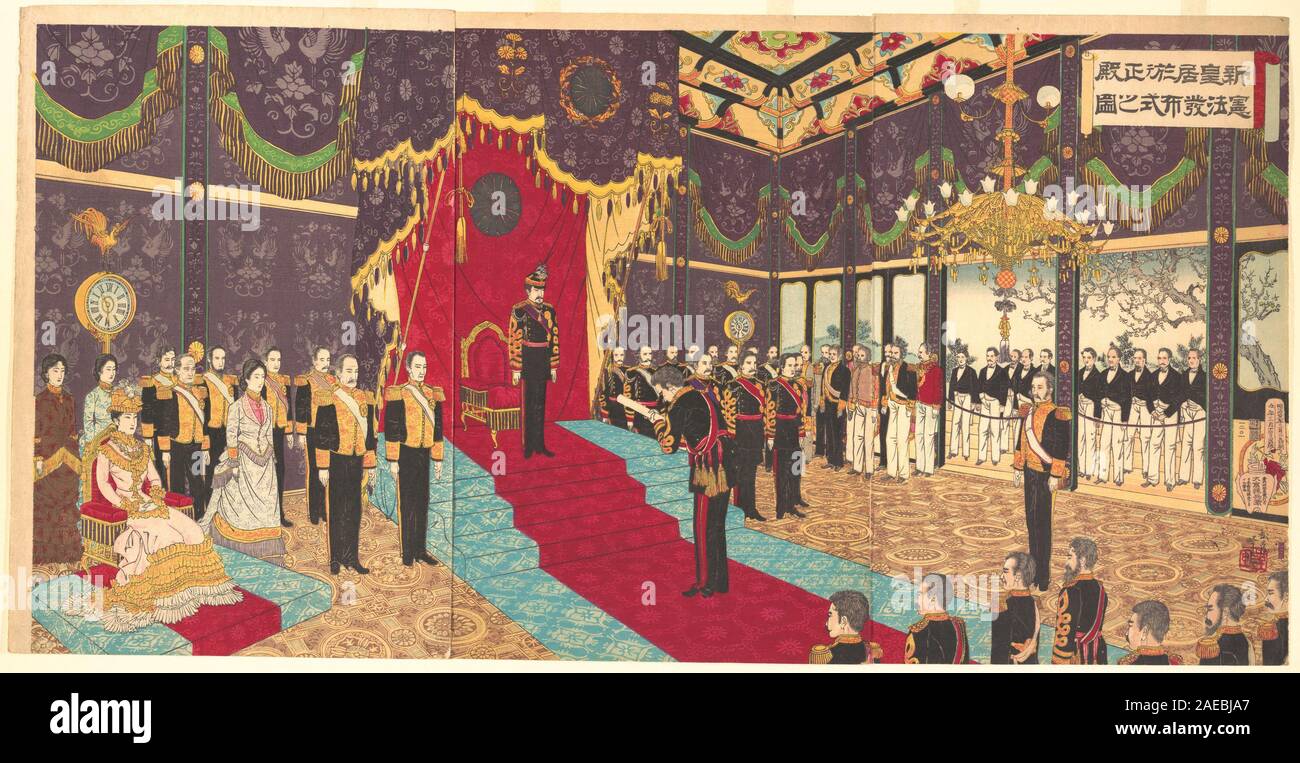 Illustration of the Issuing of the State Constitution in the State Chamber of the New Imperial Palace, by Adachi Ginko ( active 1874–97 ), Date March 14, 1889 ( Meiji Period ) Stock Photohttps://www.alamy.com/image-license-details/?v=1https://www.alamy.com/illustration-of-the-issuing-of-the-state-constitution-in-the-state-chamber-of-the-new-imperial-palace-by-adachi-ginko-active-187497-date-march-14-1889-meiji-period-image335858047.html
Illustration of the Issuing of the State Constitution in the State Chamber of the New Imperial Palace, by Adachi Ginko ( active 1874–97 ), Date March 14, 1889 ( Meiji Period ) Stock Photohttps://www.alamy.com/image-license-details/?v=1https://www.alamy.com/illustration-of-the-issuing-of-the-state-constitution-in-the-state-chamber-of-the-new-imperial-palace-by-adachi-ginko-active-187497-date-march-14-1889-meiji-period-image335858047.htmlRM2AEBJA7–Illustration of the Issuing of the State Constitution in the State Chamber of the New Imperial Palace, by Adachi Ginko ( active 1874–97 ), Date March 14, 1889 ( Meiji Period )
 Hommaru Palace, Nagoya Castle, Nagoya, Japan. Stock Photohttps://www.alamy.com/image-license-details/?v=1https://www.alamy.com/hommaru-palace-nagoya-castle-nagoya-japan-image3385137.html
Hommaru Palace, Nagoya Castle, Nagoya, Japan. Stock Photohttps://www.alamy.com/image-license-details/?v=1https://www.alamy.com/hommaru-palace-nagoya-castle-nagoya-japan-image3385137.htmlRMA20R32–Hommaru Palace, Nagoya Castle, Nagoya, Japan.
 c. 1880s Japan - gate of Imperial Palace, Tokyo Stock Photohttps://www.alamy.com/image-license-details/?v=1https://www.alamy.com/stock-photo-c-1880s-japan-gate-of-imperial-palace-tokyo-172596050.html
c. 1880s Japan - gate of Imperial Palace, Tokyo Stock Photohttps://www.alamy.com/image-license-details/?v=1https://www.alamy.com/stock-photo-c-1880s-japan-gate-of-imperial-palace-tokyo-172596050.htmlRMM0PC0J–c. 1880s Japan - gate of Imperial Palace, Tokyo
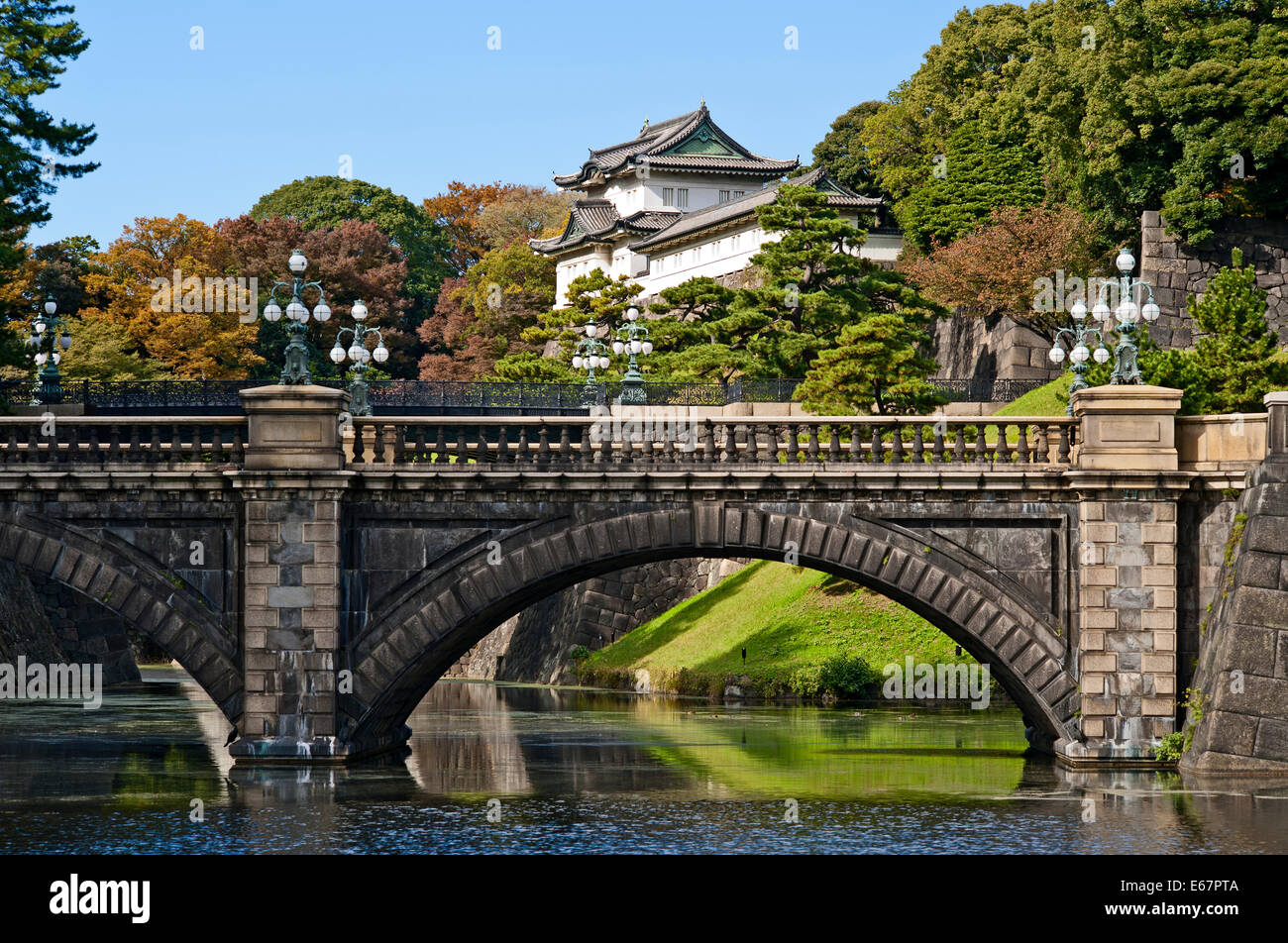 Imperial Palace Tokyo Japan Emperor Nijubashi Bridge Stock Photohttps://www.alamy.com/image-license-details/?v=1https://www.alamy.com/stock-photo-imperial-palace-tokyo-japan-emperor-nijubashi-bridge-72701002.html
Imperial Palace Tokyo Japan Emperor Nijubashi Bridge Stock Photohttps://www.alamy.com/image-license-details/?v=1https://www.alamy.com/stock-photo-imperial-palace-tokyo-japan-emperor-nijubashi-bridge-72701002.htmlRME67PTA–Imperial Palace Tokyo Japan Emperor Nijubashi Bridge
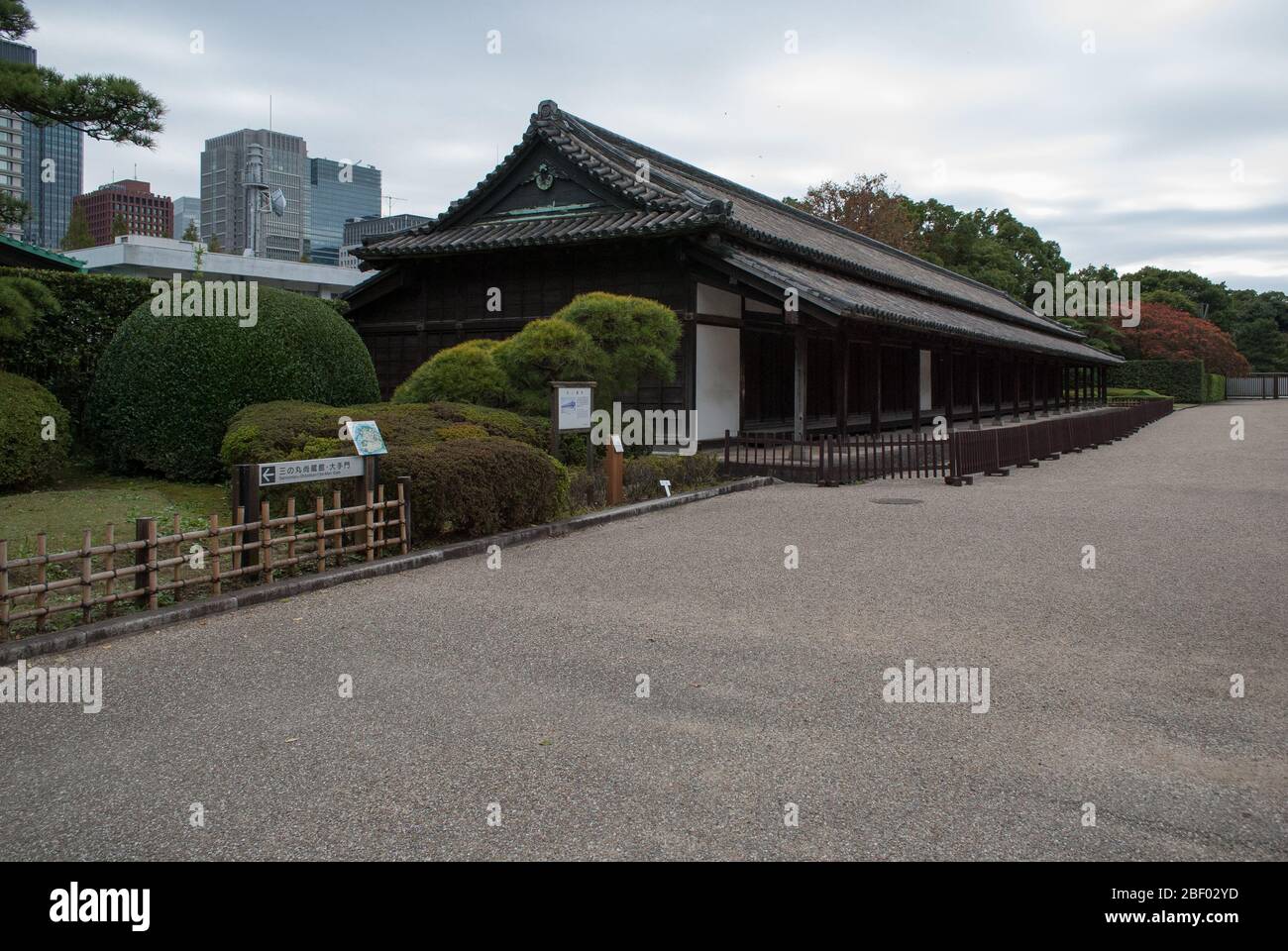 Old Edo Castle Tokyo Imperial Palace, Chiyoda Ward, Tokyo, Japan Stock Photohttps://www.alamy.com/image-license-details/?v=1https://www.alamy.com/old-edo-castle-tokyo-imperial-palace-chiyoda-ward-tokyo-japan-image353429537.html
Old Edo Castle Tokyo Imperial Palace, Chiyoda Ward, Tokyo, Japan Stock Photohttps://www.alamy.com/image-license-details/?v=1https://www.alamy.com/old-edo-castle-tokyo-imperial-palace-chiyoda-ward-tokyo-japan-image353429537.htmlRF2BF02YD–Old Edo Castle Tokyo Imperial Palace, Chiyoda Ward, Tokyo, Japan
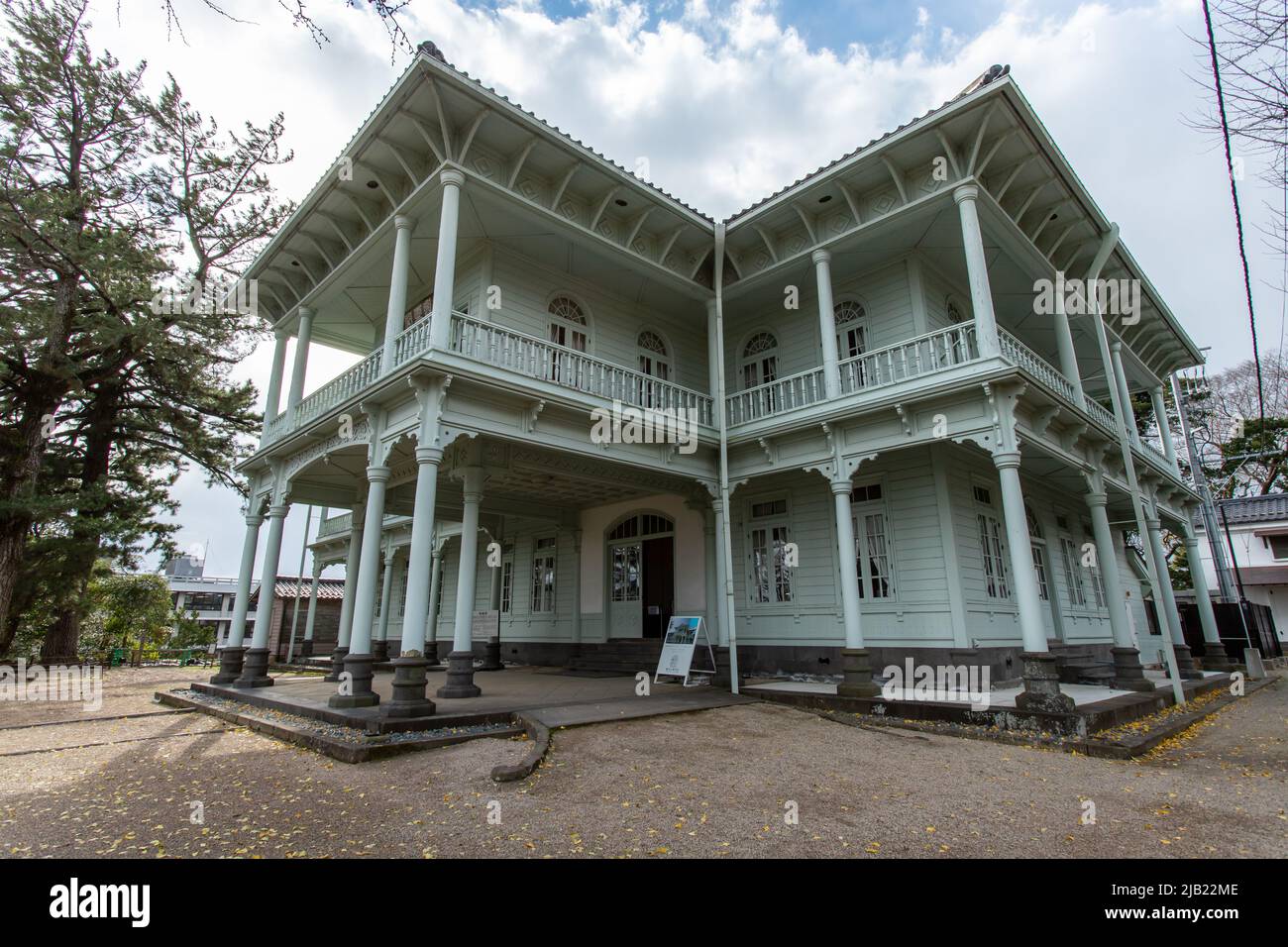 Matsue, Shimane, JAPAN - Dec 1 2021 : Kouunkaku, a guest palace to host the Meiji Emperor built in Meiji Period, at the Matsue Jo (Matsue Castle) area Stock Photohttps://www.alamy.com/image-license-details/?v=1https://www.alamy.com/matsue-shimane-japan-dec-1-2021-kouunkaku-a-guest-palace-to-host-the-meiji-emperor-built-in-meiji-period-at-the-matsue-jo-matsue-castle-area-image471487198.html
Matsue, Shimane, JAPAN - Dec 1 2021 : Kouunkaku, a guest palace to host the Meiji Emperor built in Meiji Period, at the Matsue Jo (Matsue Castle) area Stock Photohttps://www.alamy.com/image-license-details/?v=1https://www.alamy.com/matsue-shimane-japan-dec-1-2021-kouunkaku-a-guest-palace-to-host-the-meiji-emperor-built-in-meiji-period-at-the-matsue-jo-matsue-castle-area-image471487198.htmlRF2JB22ME–Matsue, Shimane, JAPAN - Dec 1 2021 : Kouunkaku, a guest palace to host the Meiji Emperor built in Meiji Period, at the Matsue Jo (Matsue Castle) area
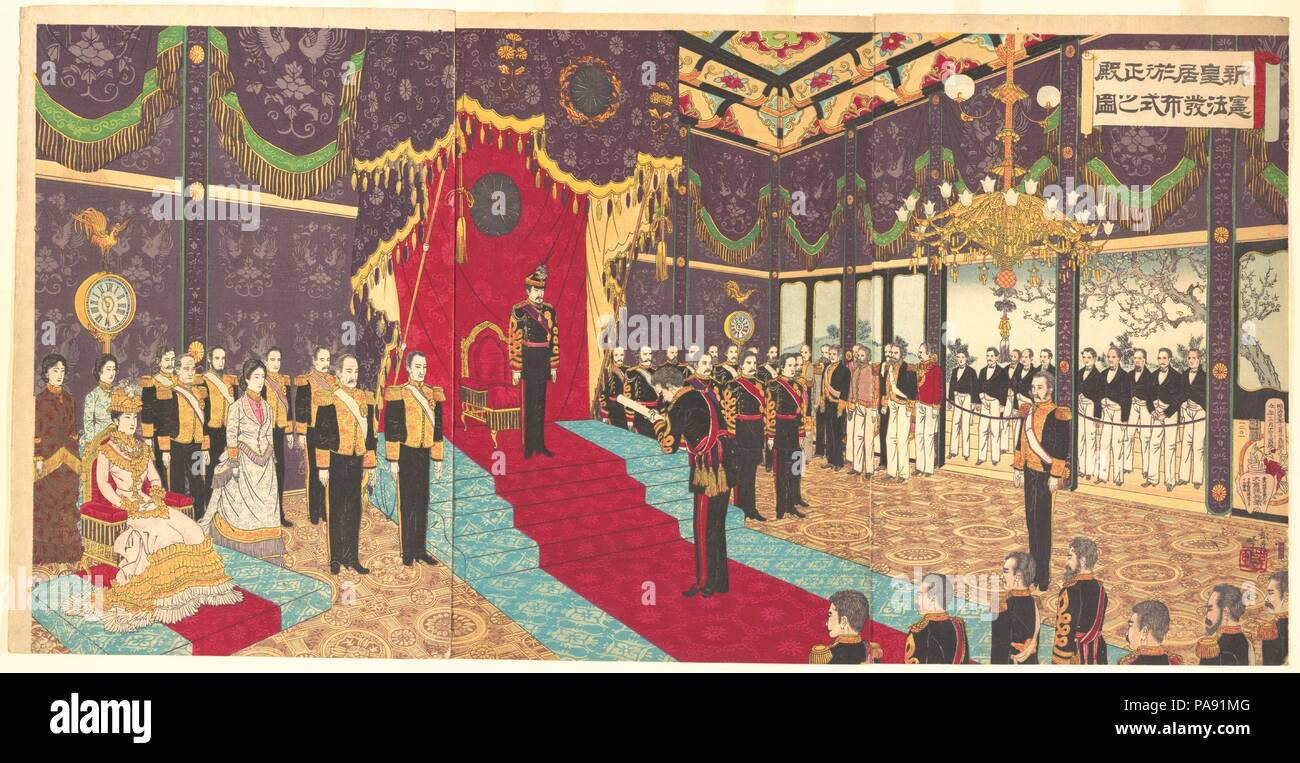 Shinkokyo Oite Seiden Kempo Happu no zu View of the Issuance of the State Constitution in the State Chamber of the New Imperial Palace. Artist: Adachi (Shosai) Ginko (Japanese, active 1874-97). Culture: Japan. Dimensions: Image: 14 3/4 × 9 1/2 in. (37.5 × 24.1 cm). Date: March 2, 1889 (Meiji 22). Museum: Metropolitan Museum of Art, New York, USA. Stock Photohttps://www.alamy.com/image-license-details/?v=1https://www.alamy.com/shinkokyo-oite-seiden-kempo-happu-no-zu-view-of-the-issuance-of-the-state-constitution-in-the-state-chamber-of-the-new-imperial-palace-artist-adachi-shosai-ginko-japanese-active-1874-97-culture-japan-dimensions-image-14-34-9-12-in-375-241-cm-date-march-2-1889-meiji-22-museum-metropolitan-museum-of-art-new-york-usa-image212869904.html
Shinkokyo Oite Seiden Kempo Happu no zu View of the Issuance of the State Constitution in the State Chamber of the New Imperial Palace. Artist: Adachi (Shosai) Ginko (Japanese, active 1874-97). Culture: Japan. Dimensions: Image: 14 3/4 × 9 1/2 in. (37.5 × 24.1 cm). Date: March 2, 1889 (Meiji 22). Museum: Metropolitan Museum of Art, New York, USA. Stock Photohttps://www.alamy.com/image-license-details/?v=1https://www.alamy.com/shinkokyo-oite-seiden-kempo-happu-no-zu-view-of-the-issuance-of-the-state-constitution-in-the-state-chamber-of-the-new-imperial-palace-artist-adachi-shosai-ginko-japanese-active-1874-97-culture-japan-dimensions-image-14-34-9-12-in-375-241-cm-date-march-2-1889-meiji-22-museum-metropolitan-museum-of-art-new-york-usa-image212869904.htmlRMPA91MG–Shinkokyo Oite Seiden Kempo Happu no zu View of the Issuance of the State Constitution in the State Chamber of the New Imperial Palace. Artist: Adachi (Shosai) Ginko (Japanese, active 1874-97). Culture: Japan. Dimensions: Image: 14 3/4 × 9 1/2 in. (37.5 × 24.1 cm). Date: March 2, 1889 (Meiji 22). Museum: Metropolitan Museum of Art, New York, USA.
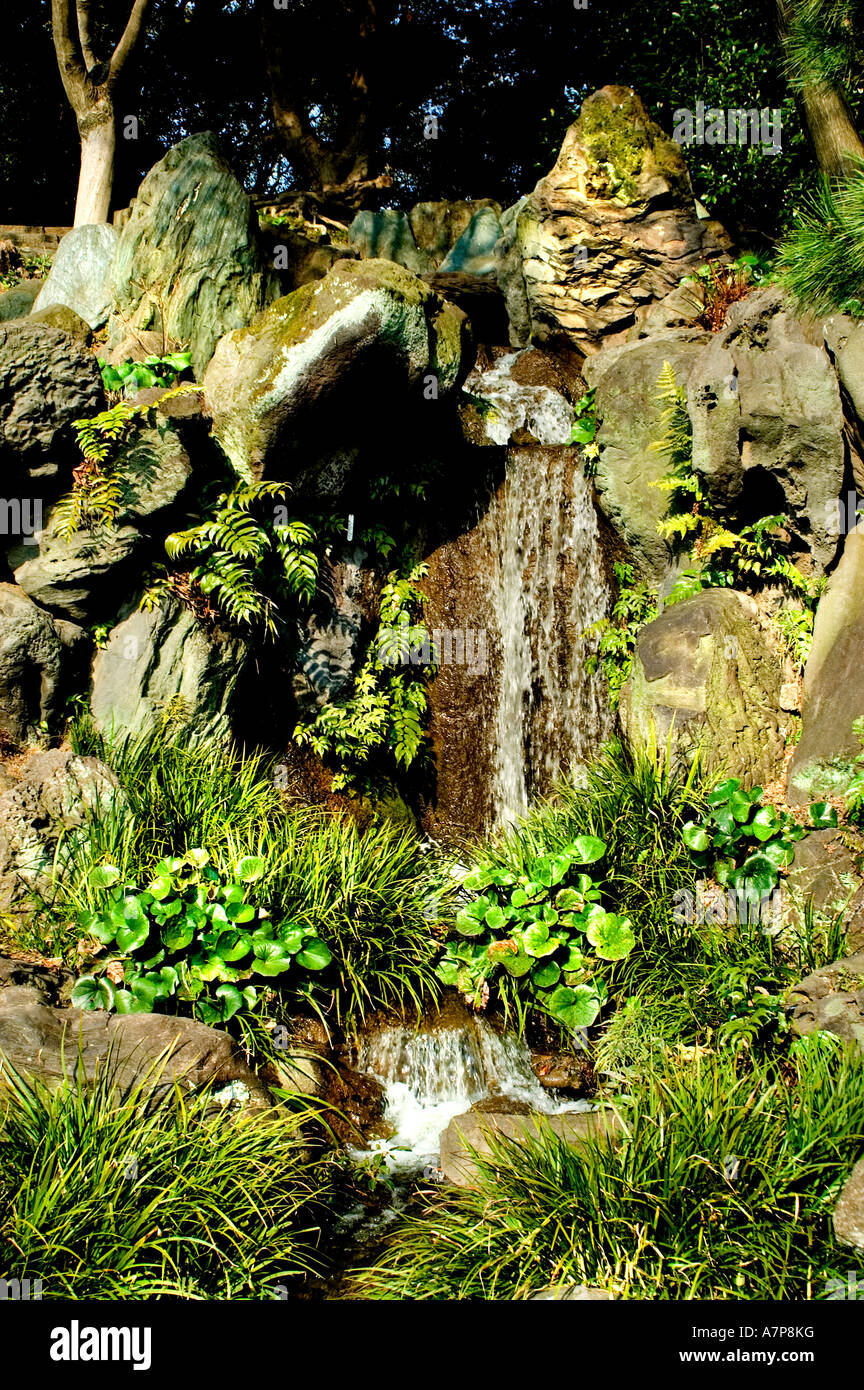 Tokyo Imperial Palace East Garden Kokyo Higashi Gyoen waterfall Stock Photohttps://www.alamy.com/image-license-details/?v=1https://www.alamy.com/stock-photo-tokyo-imperial-palace-east-garden-kokyo-higashi-gyoen-waterfall-11888355.html
Tokyo Imperial Palace East Garden Kokyo Higashi Gyoen waterfall Stock Photohttps://www.alamy.com/image-license-details/?v=1https://www.alamy.com/stock-photo-tokyo-imperial-palace-east-garden-kokyo-higashi-gyoen-waterfall-11888355.htmlRMA7P8KG–Tokyo Imperial Palace East Garden Kokyo Higashi Gyoen waterfall
 A Banquet in celebration of the New Imperial Palace , 1888. Private Collection. Stock Photohttps://www.alamy.com/image-license-details/?v=1https://www.alamy.com/a-banquet-in-celebration-of-the-new-imperial-palace-1888-private-collection-image535135159.html
A Banquet in celebration of the New Imperial Palace , 1888. Private Collection. Stock Photohttps://www.alamy.com/image-license-details/?v=1https://www.alamy.com/a-banquet-in-celebration-of-the-new-imperial-palace-1888-private-collection-image535135159.htmlRM2P2HE9Y–A Banquet in celebration of the New Imperial Palace , 1888. Private Collection.
 . English: Bird's-eye view of the Meiji palace which was completed in October 1888. 日本語: 大日本帝国御造営之図 加藤兵太郎著 翠月堂詞書 明治21(1888)刊 加藤兵太郎 請求記号:加2087 . 19th century. Ukiyo-e artist 531 Tokyo Imperial Palace pic 08 Stock Photohttps://www.alamy.com/image-license-details/?v=1https://www.alamy.com/english-birds-eye-view-of-the-meiji-palace-which-was-completed-in-october-1888-211888-2087-19th-century-ukiyo-e-artist-531-tokyo-imperial-palace-pic-08-image188763042.html
. English: Bird's-eye view of the Meiji palace which was completed in October 1888. 日本語: 大日本帝国御造営之図 加藤兵太郎著 翠月堂詞書 明治21(1888)刊 加藤兵太郎 請求記号:加2087 . 19th century. Ukiyo-e artist 531 Tokyo Imperial Palace pic 08 Stock Photohttps://www.alamy.com/image-license-details/?v=1https://www.alamy.com/english-birds-eye-view-of-the-meiji-palace-which-was-completed-in-october-1888-211888-2087-19th-century-ukiyo-e-artist-531-tokyo-imperial-palace-pic-08-image188763042.htmlRMMY2W56–. English: Bird's-eye view of the Meiji palace which was completed in October 1888. 日本語: 大日本帝国御造営之図 加藤兵太郎著 翠月堂詞書 明治21(1888)刊 加藤兵太郎 請求記号:加2087 . 19th century. Ukiyo-e artist 531 Tokyo Imperial Palace pic 08
![[ 1890s Japan - Imperial palace, Tokyo ] — Lotus pond at the Imperial palace in Tokyo. 19th century vintage albumen photograph. Stock Photo [ 1890s Japan - Imperial palace, Tokyo ] — Lotus pond at the Imperial palace in Tokyo. 19th century vintage albumen photograph. Stock Photo](https://c8.alamy.com/comp/W13NK9/1890s-japan-imperial-palace-tokyo-lotus-pond-at-the-imperial-palace-in-tokyo-19th-century-vintage-albumen-photograph-W13NK9.jpg) [ 1890s Japan - Imperial palace, Tokyo ] — Lotus pond at the Imperial palace in Tokyo. 19th century vintage albumen photograph. Stock Photohttps://www.alamy.com/image-license-details/?v=1https://www.alamy.com/1890s-japan-imperial-palace-tokyo-lotus-pond-at-the-imperial-palace-in-tokyo-19th-century-vintage-albumen-photograph-image258853037.html
[ 1890s Japan - Imperial palace, Tokyo ] — Lotus pond at the Imperial palace in Tokyo. 19th century vintage albumen photograph. Stock Photohttps://www.alamy.com/image-license-details/?v=1https://www.alamy.com/1890s-japan-imperial-palace-tokyo-lotus-pond-at-the-imperial-palace-in-tokyo-19th-century-vintage-albumen-photograph-image258853037.htmlRMW13NK9–[ 1890s Japan - Imperial palace, Tokyo ] — Lotus pond at the Imperial palace in Tokyo. 19th century vintage albumen photograph.
 The Kyoto Imperial Palace is the former ruling palace of the Emperor of Japan. Since the Meiji Restoration in 1869, the Emperors have resided at the Tokyo Imperial Palace, while the preservation of the Kyoto Imperial Palace was ordered in 1877. View of Emperor's carriages. Stock Photohttps://www.alamy.com/image-license-details/?v=1https://www.alamy.com/the-kyoto-imperial-palace-is-the-former-ruling-palace-of-the-emperor-of-japan-since-the-meiji-restoration-in-1869-the-emperors-have-resided-at-the-tokyo-imperial-palace-while-the-preservation-of-the-kyoto-imperial-palace-was-ordered-in-1877-view-of-emperors-carriages-image560798797.html
The Kyoto Imperial Palace is the former ruling palace of the Emperor of Japan. Since the Meiji Restoration in 1869, the Emperors have resided at the Tokyo Imperial Palace, while the preservation of the Kyoto Imperial Palace was ordered in 1877. View of Emperor's carriages. Stock Photohttps://www.alamy.com/image-license-details/?v=1https://www.alamy.com/the-kyoto-imperial-palace-is-the-former-ruling-palace-of-the-emperor-of-japan-since-the-meiji-restoration-in-1869-the-emperors-have-resided-at-the-tokyo-imperial-palace-while-the-preservation-of-the-kyoto-imperial-palace-was-ordered-in-1877-view-of-emperors-carriages-image560798797.htmlRM2RGAGGD–The Kyoto Imperial Palace is the former ruling palace of the Emperor of Japan. Since the Meiji Restoration in 1869, the Emperors have resided at the Tokyo Imperial Palace, while the preservation of the Kyoto Imperial Palace was ordered in 1877. View of Emperor's carriages.
 Walking in the Garden, from the series Chiyoda Inner Palace, Toyohara Chikanobu, Japanese, 1838-1912, Woodblock print, Japan, 1896, Meiji Period, R:14 x 9 3/8 in., 35.6 x 23.8 cm, animal, Calm, carp, fins, fish, Harmony, jumping, Meditative, Minimal, Nature, wisteria Stock Photohttps://www.alamy.com/image-license-details/?v=1https://www.alamy.com/walking-in-the-garden-from-the-series-chiyoda-inner-palace-toyohara-chikanobu-japanese-1838-1912-woodblock-print-japan-1896-meiji-period-r14-x-9-38-in-356-x-238-cm-animal-calm-carp-fins-fish-harmony-jumping-meditative-minimal-nature-wisteria-image454281615.html
Walking in the Garden, from the series Chiyoda Inner Palace, Toyohara Chikanobu, Japanese, 1838-1912, Woodblock print, Japan, 1896, Meiji Period, R:14 x 9 3/8 in., 35.6 x 23.8 cm, animal, Calm, carp, fins, fish, Harmony, jumping, Meditative, Minimal, Nature, wisteria Stock Photohttps://www.alamy.com/image-license-details/?v=1https://www.alamy.com/walking-in-the-garden-from-the-series-chiyoda-inner-palace-toyohara-chikanobu-japanese-1838-1912-woodblock-print-japan-1896-meiji-period-r14-x-9-38-in-356-x-238-cm-animal-calm-carp-fins-fish-harmony-jumping-meditative-minimal-nature-wisteria-image454281615.htmlRM2HB28RB–Walking in the Garden, from the series Chiyoda Inner Palace, Toyohara Chikanobu, Japanese, 1838-1912, Woodblock print, Japan, 1896, Meiji Period, R:14 x 9 3/8 in., 35.6 x 23.8 cm, animal, Calm, carp, fins, fish, Harmony, jumping, Meditative, Minimal, Nature, wisteria
 Inspired by Walking in the Garden, from the series Chiyoda Inner Palace, Toyohara Chikanobu, Japanese, 1838-1912, Woodblock print, Japan, 1896, Meiji Period, R:14 x 9 3/8 in., 35.6 x 23.8 cm, animal, Calm, carp, fins, fish, Harmony, jumping, Meditative, Minimal, Nature, wisteria, Reimagined by Artotop. Classic art reinvented with a modern twist. Design of warm cheerful glowing of brightness and light ray radiance. Photography inspired by surrealism and futurism, embracing dynamic energy of modern technology, movement, speed and revolutionize culture Stock Photohttps://www.alamy.com/image-license-details/?v=1https://www.alamy.com/inspired-by-walking-in-the-garden-from-the-series-chiyoda-inner-palace-toyohara-chikanobu-japanese-1838-1912-woodblock-print-japan-1896-meiji-period-r14-x-9-38-in-356-x-238-cm-animal-calm-carp-fins-fish-harmony-jumping-meditative-minimal-nature-wisteria-reimagined-by-artotop-classic-art-reinvented-with-a-modern-twist-design-of-warm-cheerful-glowing-of-brightness-and-light-ray-radiance-photography-inspired-by-surrealism-and-futurism-embracing-dynamic-energy-of-modern-technology-movement-speed-and-revolutionize-culture-image459262751.html
Inspired by Walking in the Garden, from the series Chiyoda Inner Palace, Toyohara Chikanobu, Japanese, 1838-1912, Woodblock print, Japan, 1896, Meiji Period, R:14 x 9 3/8 in., 35.6 x 23.8 cm, animal, Calm, carp, fins, fish, Harmony, jumping, Meditative, Minimal, Nature, wisteria, Reimagined by Artotop. Classic art reinvented with a modern twist. Design of warm cheerful glowing of brightness and light ray radiance. Photography inspired by surrealism and futurism, embracing dynamic energy of modern technology, movement, speed and revolutionize culture Stock Photohttps://www.alamy.com/image-license-details/?v=1https://www.alamy.com/inspired-by-walking-in-the-garden-from-the-series-chiyoda-inner-palace-toyohara-chikanobu-japanese-1838-1912-woodblock-print-japan-1896-meiji-period-r14-x-9-38-in-356-x-238-cm-animal-calm-carp-fins-fish-harmony-jumping-meditative-minimal-nature-wisteria-reimagined-by-artotop-classic-art-reinvented-with-a-modern-twist-design-of-warm-cheerful-glowing-of-brightness-and-light-ray-radiance-photography-inspired-by-surrealism-and-futurism-embracing-dynamic-energy-of-modern-technology-movement-speed-and-revolutionize-culture-image459262751.htmlRF2HK5693–Inspired by Walking in the Garden, from the series Chiyoda Inner Palace, Toyohara Chikanobu, Japanese, 1838-1912, Woodblock print, Japan, 1896, Meiji Period, R:14 x 9 3/8 in., 35.6 x 23.8 cm, animal, Calm, carp, fins, fish, Harmony, jumping, Meditative, Minimal, Nature, wisteria, Reimagined by Artotop. Classic art reinvented with a modern twist. Design of warm cheerful glowing of brightness and light ray radiance. Photography inspired by surrealism and futurism, embracing dynamic energy of modern technology, movement, speed and revolutionize culture
 Emperor Meiji (1852-1912) of Japan invites General Ulysses S. Grant (1822-1885) to the Imperial Palace. Grant participated in Stock Photohttps://www.alamy.com/image-license-details/?v=1https://www.alamy.com/stock-photo-emperor-meiji-1852-1912-of-japan-invites-general-ulysses-s-grant-1822-83345175.html
Emperor Meiji (1852-1912) of Japan invites General Ulysses S. Grant (1822-1885) to the Imperial Palace. Grant participated in Stock Photohttps://www.alamy.com/image-license-details/?v=1https://www.alamy.com/stock-photo-emperor-meiji-1852-1912-of-japan-invites-general-ulysses-s-grant-1822-83345175.htmlRMERGKHB–Emperor Meiji (1852-1912) of Japan invites General Ulysses S. Grant (1822-1885) to the Imperial Palace. Grant participated in
 The Kyoto Imperial Palace is the former ruling palace of the Emperor of Japan. The Emperors have since resided at the Tokyo Imperial Palace after the Meiji Restoration in 1869, and the preservation of the Kyoto Imperial Palace was ordered in 1877 Stock Photohttps://www.alamy.com/image-license-details/?v=1https://www.alamy.com/the-kyoto-imperial-palace-is-the-former-ruling-palace-of-the-emperor-of-japan-the-emperors-have-since-resided-at-the-tokyo-imperial-palace-after-the-meiji-restoration-in-1869-and-the-preservation-of-the-kyoto-imperial-palace-was-ordered-in-1877-image328353755.html
The Kyoto Imperial Palace is the former ruling palace of the Emperor of Japan. The Emperors have since resided at the Tokyo Imperial Palace after the Meiji Restoration in 1869, and the preservation of the Kyoto Imperial Palace was ordered in 1877 Stock Photohttps://www.alamy.com/image-license-details/?v=1https://www.alamy.com/the-kyoto-imperial-palace-is-the-former-ruling-palace-of-the-emperor-of-japan-the-emperors-have-since-resided-at-the-tokyo-imperial-palace-after-the-meiji-restoration-in-1869-and-the-preservation-of-the-kyoto-imperial-palace-was-ordered-in-1877-image328353755.htmlRM2A25PFR–The Kyoto Imperial Palace is the former ruling palace of the Emperor of Japan. The Emperors have since resided at the Tokyo Imperial Palace after the Meiji Restoration in 1869, and the preservation of the Kyoto Imperial Palace was ordered in 1877
 Italy Piedmont Turin - Mazzonis Palace - Mao Museum ( Museo d'Arte Orientale ) - Museum of Oriental art - Mochizuki Gyokusen ( 1834 - 1913 ) Gyokusen Shuga Cho ( Illistrated book on Gyokuse's drawings ) Meiji Period 1891 - 1900 Stock Photohttps://www.alamy.com/image-license-details/?v=1https://www.alamy.com/italy-piedmont-turin-mazzonis-palace-mao-museum-museo-darte-orientale-museum-of-oriental-art-mochizuki-gyokusen-1834-1913-gyokusen-shuga-cho-illistrated-book-on-gyokuses-drawings-meiji-period-1891-1900-image332578485.html
Italy Piedmont Turin - Mazzonis Palace - Mao Museum ( Museo d'Arte Orientale ) - Museum of Oriental art - Mochizuki Gyokusen ( 1834 - 1913 ) Gyokusen Shuga Cho ( Illistrated book on Gyokuse's drawings ) Meiji Period 1891 - 1900 Stock Photohttps://www.alamy.com/image-license-details/?v=1https://www.alamy.com/italy-piedmont-turin-mazzonis-palace-mao-museum-museo-darte-orientale-museum-of-oriental-art-mochizuki-gyokusen-1834-1913-gyokusen-shuga-cho-illistrated-book-on-gyokuses-drawings-meiji-period-1891-1900-image332578485.htmlRM2A92771–Italy Piedmont Turin - Mazzonis Palace - Mao Museum ( Museo d'Arte Orientale ) - Museum of Oriental art - Mochizuki Gyokusen ( 1834 - 1913 ) Gyokusen Shuga Cho ( Illistrated book on Gyokuse's drawings ) Meiji Period 1891 - 1900
 The Ishiyakushi Gomon Gate at the Kyoto Gosho (Imperial Palace) in the Kyoto Gyoen National Garden historic entrance, Japan. Stock Photohttps://www.alamy.com/image-license-details/?v=1https://www.alamy.com/the-ishiyakushi-gomon-gate-at-the-kyoto-gosho-imperial-palace-in-the-kyoto-gyoen-national-garden-historic-entrance-japan-image630249263.html
The Ishiyakushi Gomon Gate at the Kyoto Gosho (Imperial Palace) in the Kyoto Gyoen National Garden historic entrance, Japan. Stock Photohttps://www.alamy.com/image-license-details/?v=1https://www.alamy.com/the-ishiyakushi-gomon-gate-at-the-kyoto-gosho-imperial-palace-in-the-kyoto-gyoen-national-garden-historic-entrance-japan-image630249263.htmlRM2YHA9A7–The Ishiyakushi Gomon Gate at the Kyoto Gosho (Imperial Palace) in the Kyoto Gyoen National Garden historic entrance, Japan.
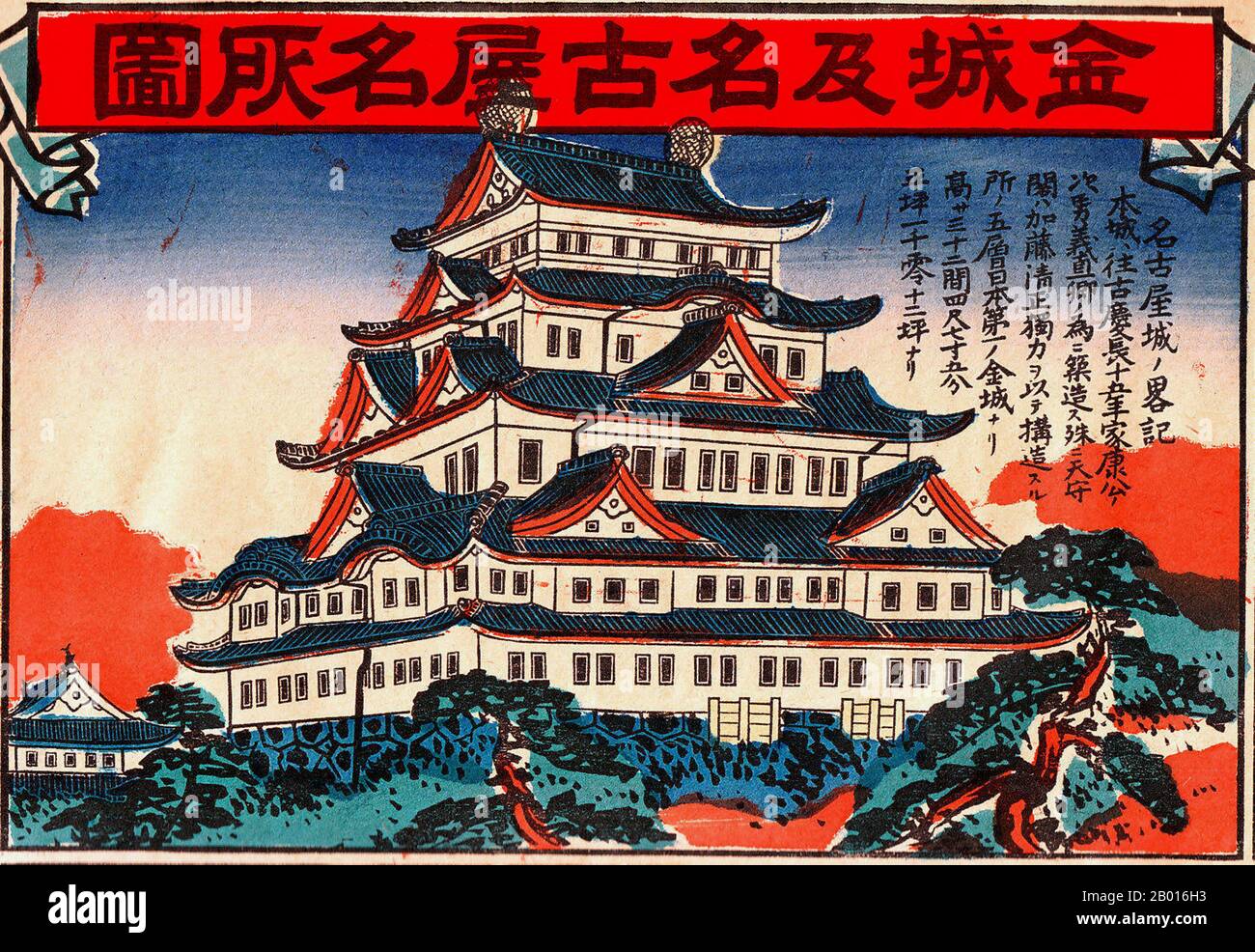 Nagoya Castle (Nagoya-jō) is a castle located in Nagoya, central Japan. During the Edo period, Nagoya Castle was the centre of one of the most powerful castle towns in Japan—Nagoya-juku— and it included the most important stops along the Minoji, which linked the Tōkaidō with the Nakasendō. Stock Photohttps://www.alamy.com/image-license-details/?v=1https://www.alamy.com/nagoya-castle-nagoya-j-is-a-castle-located-in-nagoya-central-japan-during-the-edo-period-nagoya-castle-was-the-centre-of-one-of-the-most-powerful-castle-towns-in-japannagoya-juku-and-it-included-the-most-important-stops-along-the-minoji-which-linked-the-tkaid-with-the-nakasend-image344234495.html
Nagoya Castle (Nagoya-jō) is a castle located in Nagoya, central Japan. During the Edo period, Nagoya Castle was the centre of one of the most powerful castle towns in Japan—Nagoya-juku— and it included the most important stops along the Minoji, which linked the Tōkaidō with the Nakasendō. Stock Photohttps://www.alamy.com/image-license-details/?v=1https://www.alamy.com/nagoya-castle-nagoya-j-is-a-castle-located-in-nagoya-central-japan-during-the-edo-period-nagoya-castle-was-the-centre-of-one-of-the-most-powerful-castle-towns-in-japannagoya-juku-and-it-included-the-most-important-stops-along-the-minoji-which-linked-the-tkaid-with-the-nakasend-image344234495.htmlRM2B016H3–Nagoya Castle (Nagoya-jō) is a castle located in Nagoya, central Japan. During the Edo period, Nagoya Castle was the centre of one of the most powerful castle towns in Japan—Nagoya-juku— and it included the most important stops along the Minoji, which linked the Tōkaidō with the Nakasendō.
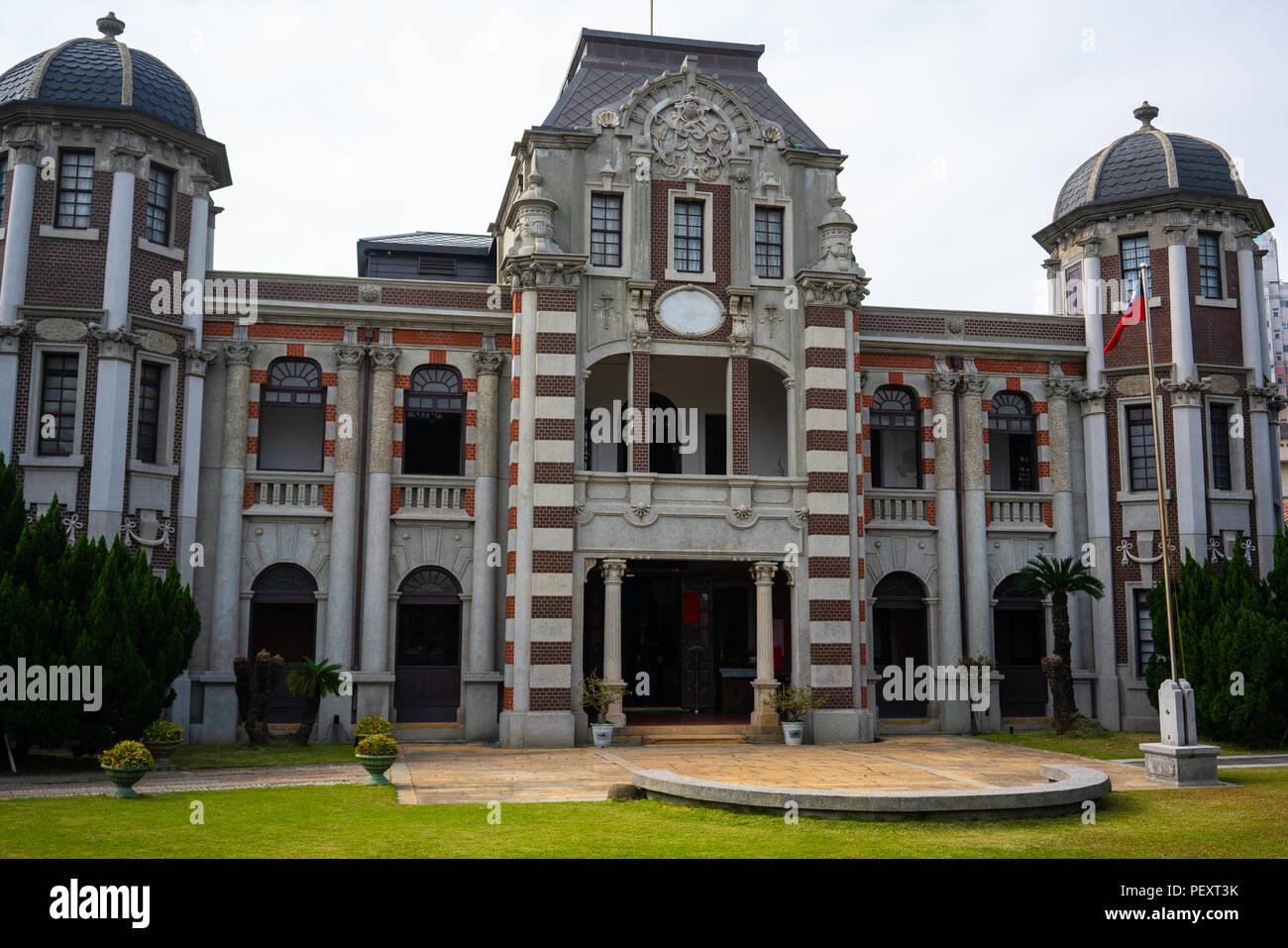 Yang Building a Meiji styled structure in Lukang Changhua county Taiwan Stock Photohttps://www.alamy.com/image-license-details/?v=1https://www.alamy.com/yang-building-a-meiji-styled-structure-in-lukang-changhua-county-taiwan-image215719271.html
Yang Building a Meiji styled structure in Lukang Changhua county Taiwan Stock Photohttps://www.alamy.com/image-license-details/?v=1https://www.alamy.com/yang-building-a-meiji-styled-structure-in-lukang-changhua-county-taiwan-image215719271.htmlRFPEXT3K–Yang Building a Meiji styled structure in Lukang Changhua county Taiwan
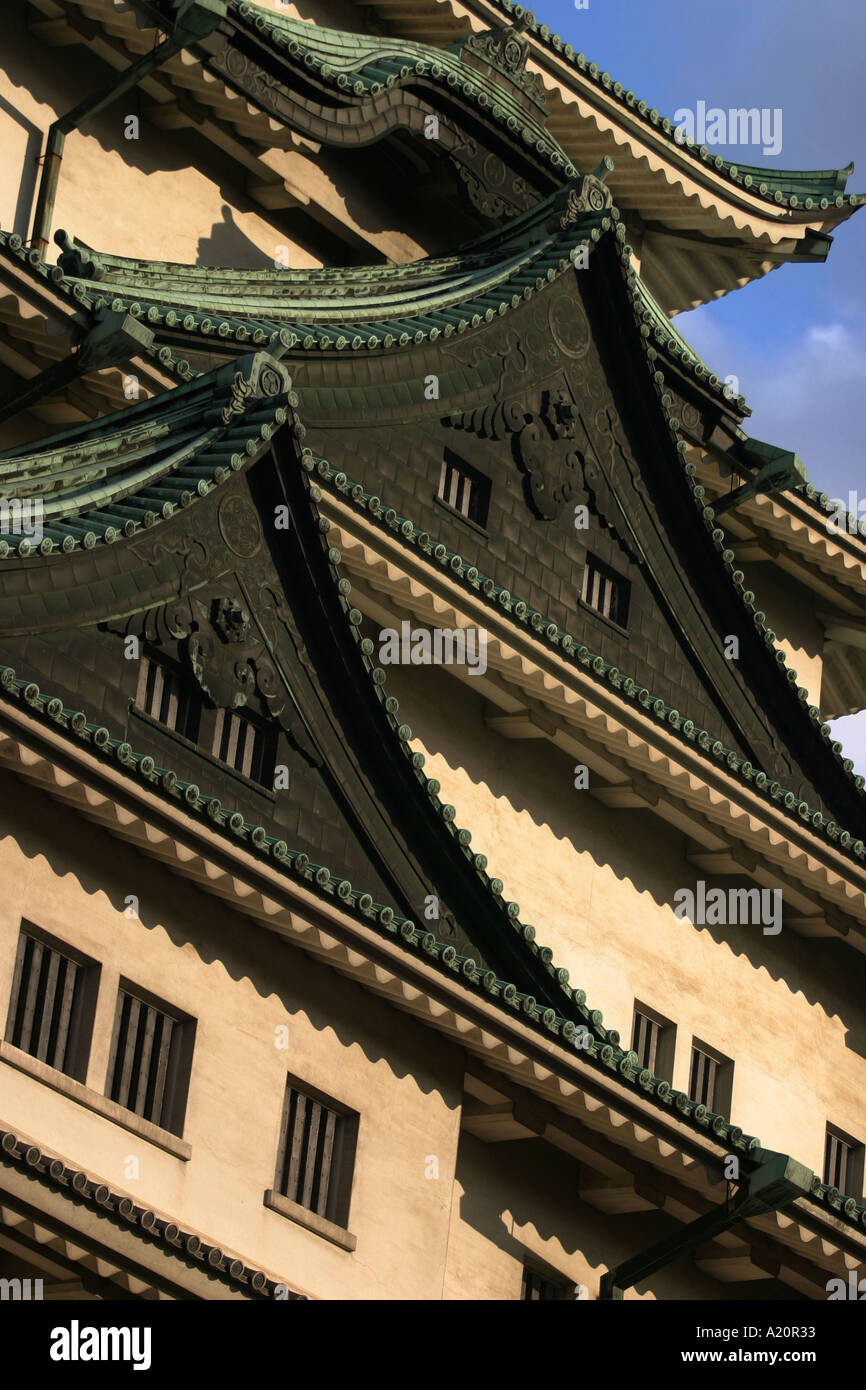 Hommaru Palace, Nagoya Castle, Nagoya, Japan Stock Photohttps://www.alamy.com/image-license-details/?v=1https://www.alamy.com/hommaru-palace-nagoya-castle-nagoya-japan-image3385138.html
Hommaru Palace, Nagoya Castle, Nagoya, Japan Stock Photohttps://www.alamy.com/image-license-details/?v=1https://www.alamy.com/hommaru-palace-nagoya-castle-nagoya-japan-image3385138.htmlRMA20R33–Hommaru Palace, Nagoya Castle, Nagoya, Japan
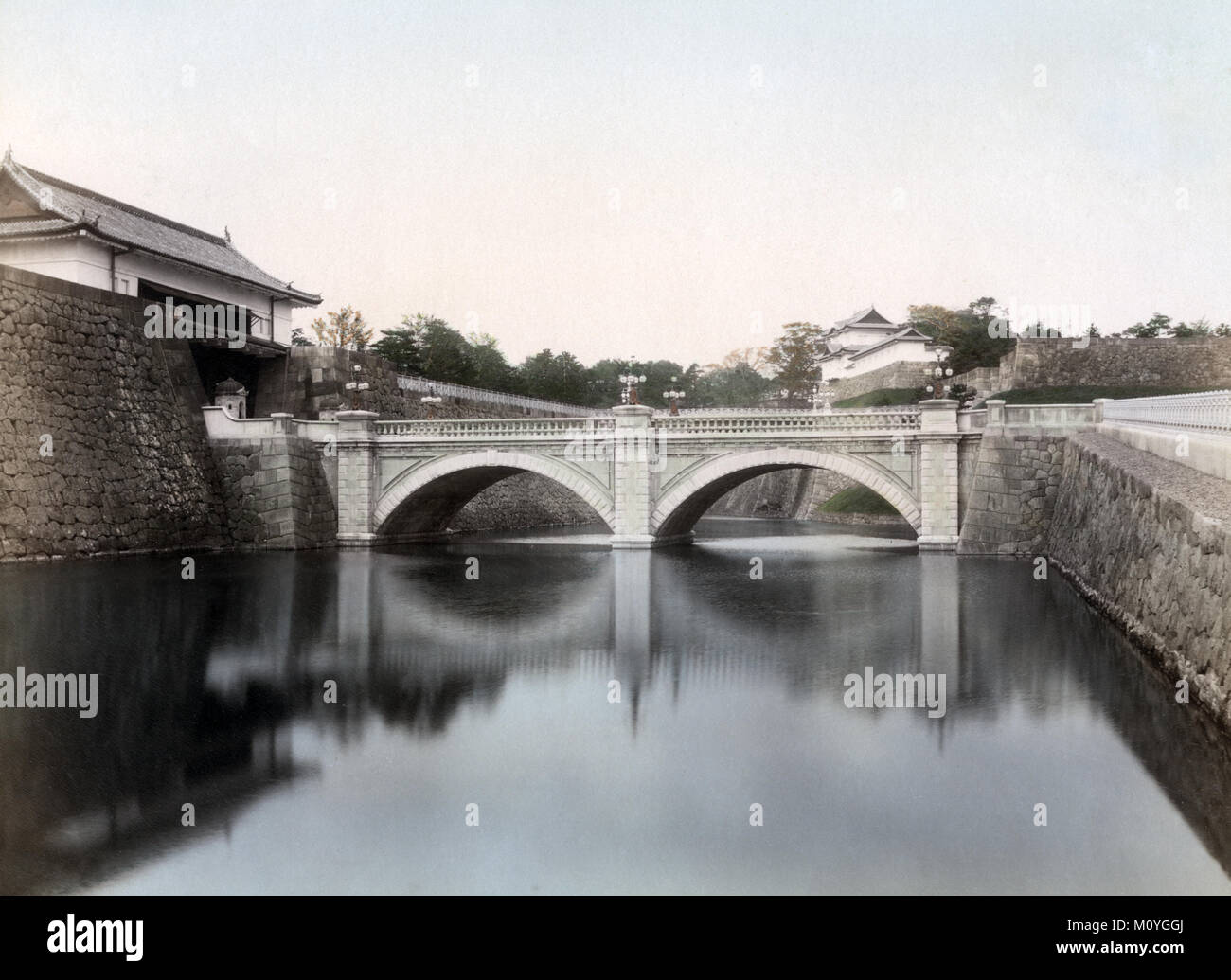 Bridge and moat, Imperial Palace, Tokyo, Japan, c.1880's Stock Photohttps://www.alamy.com/image-license-details/?v=1https://www.alamy.com/stock-photo-bridge-and-moat-imperial-palace-tokyo-japan-c1880s-172709394.html
Bridge and moat, Imperial Palace, Tokyo, Japan, c.1880's Stock Photohttps://www.alamy.com/image-license-details/?v=1https://www.alamy.com/stock-photo-bridge-and-moat-imperial-palace-tokyo-japan-c1880s-172709394.htmlRMM0YGGJ–Bridge and moat, Imperial Palace, Tokyo, Japan, c.1880's
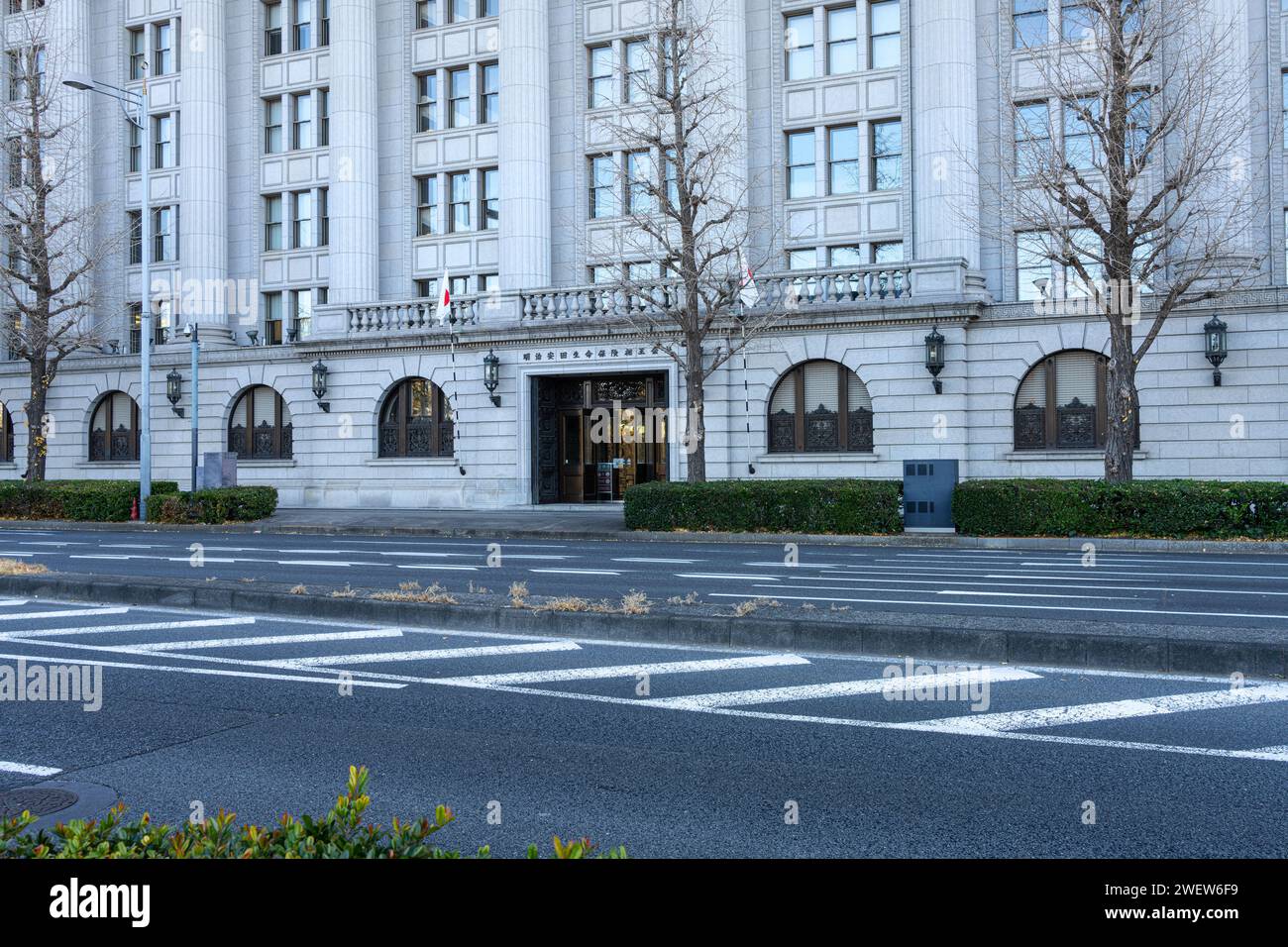 Tokyo, Japan. January 8, 2024. external view of the Meiji Seimei Kan (Meiji sense of life) building in the city center Stock Photohttps://www.alamy.com/image-license-details/?v=1https://www.alamy.com/tokyo-japan-january-8-2024-external-view-of-the-meiji-seimei-kan-meiji-sense-of-life-building-in-the-city-center-image594311629.html
Tokyo, Japan. January 8, 2024. external view of the Meiji Seimei Kan (Meiji sense of life) building in the city center Stock Photohttps://www.alamy.com/image-license-details/?v=1https://www.alamy.com/tokyo-japan-january-8-2024-external-view-of-the-meiji-seimei-kan-meiji-sense-of-life-building-in-the-city-center-image594311629.htmlRF2WEW6F9–Tokyo, Japan. January 8, 2024. external view of the Meiji Seimei Kan (Meiji sense of life) building in the city center
 Old Edo Castle Tokyo Imperial Palace, Chiyoda Ward, Tokyo, Japan Stock Photohttps://www.alamy.com/image-license-details/?v=1https://www.alamy.com/old-edo-castle-tokyo-imperial-palace-chiyoda-ward-tokyo-japan-image353430940.html
Old Edo Castle Tokyo Imperial Palace, Chiyoda Ward, Tokyo, Japan Stock Photohttps://www.alamy.com/image-license-details/?v=1https://www.alamy.com/old-edo-castle-tokyo-imperial-palace-chiyoda-ward-tokyo-japan-image353430940.htmlRF2BF04NG–Old Edo Castle Tokyo Imperial Palace, Chiyoda Ward, Tokyo, Japan
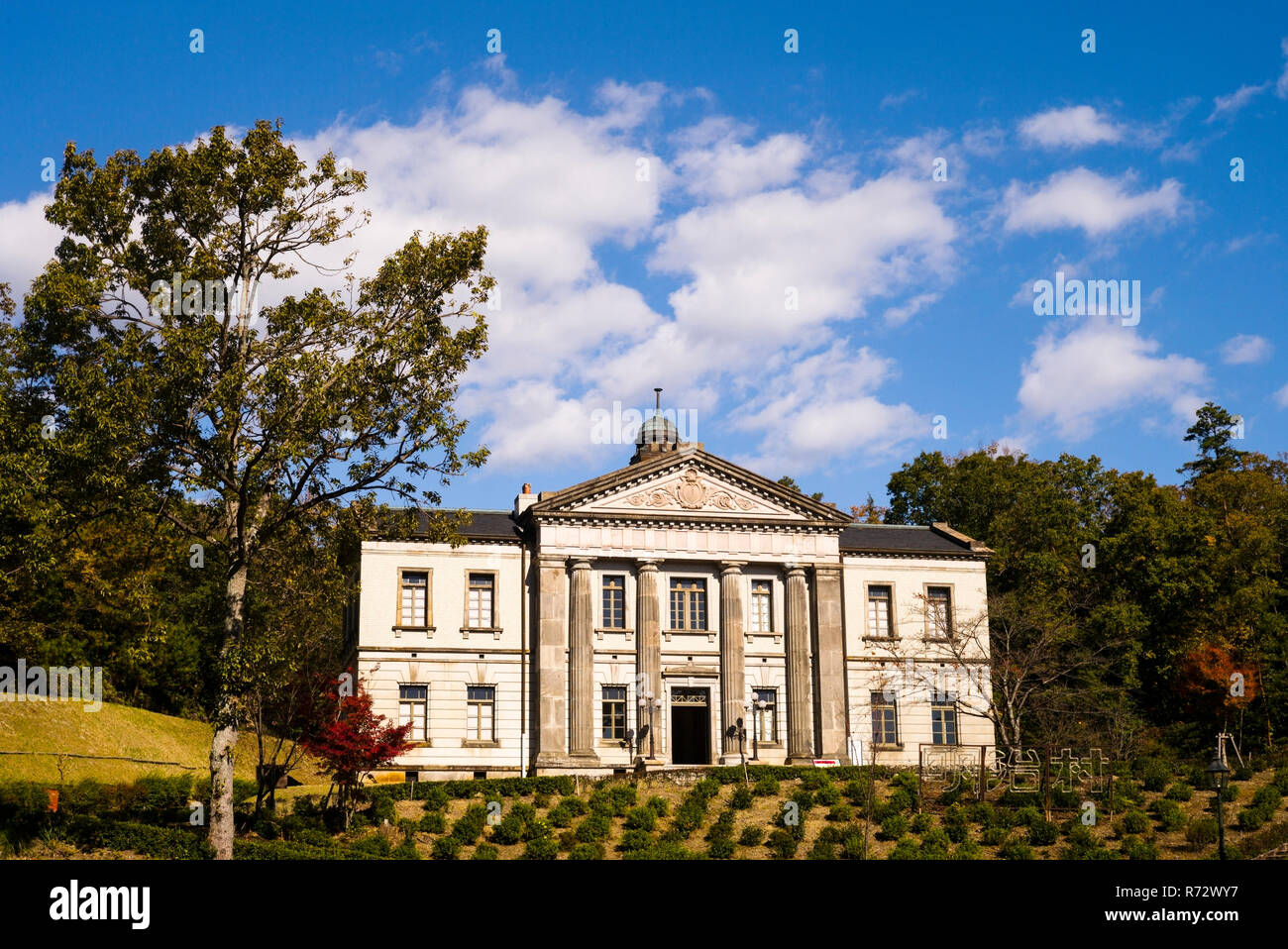 The former Cabinet Library of Tokyo Imperial Palace, exhibited inside Meiji-mura open-air architectural museum. The museum, situated in Inuyama, about Stock Photohttps://www.alamy.com/image-license-details/?v=1https://www.alamy.com/the-former-cabinet-library-of-tokyo-imperial-palace-exhibited-inside-meiji-mura-open-air-architectural-museum-the-museum-situated-in-inuyama-about-image228101643.html
The former Cabinet Library of Tokyo Imperial Palace, exhibited inside Meiji-mura open-air architectural museum. The museum, situated in Inuyama, about Stock Photohttps://www.alamy.com/image-license-details/?v=1https://www.alamy.com/the-former-cabinet-library-of-tokyo-imperial-palace-exhibited-inside-meiji-mura-open-air-architectural-museum-the-museum-situated-in-inuyama-about-image228101643.htmlRMR72WY7–The former Cabinet Library of Tokyo Imperial Palace, exhibited inside Meiji-mura open-air architectural museum. The museum, situated in Inuyama, about
 A Banquet in celebration of the New Imperial Palace. Museum: PRIVATE COLLECTION. Author: Toyohara Chikanobu (Yoshu). Stock Photohttps://www.alamy.com/image-license-details/?v=1https://www.alamy.com/a-banquet-in-celebration-of-the-new-imperial-palace-museum-private-collection-author-toyohara-chikanobu-yoshu-image515378506.html
A Banquet in celebration of the New Imperial Palace. Museum: PRIVATE COLLECTION. Author: Toyohara Chikanobu (Yoshu). Stock Photohttps://www.alamy.com/image-license-details/?v=1https://www.alamy.com/a-banquet-in-celebration-of-the-new-imperial-palace-museum-private-collection-author-toyohara-chikanobu-yoshu-image515378506.htmlRM2MXDEF6–A Banquet in celebration of the New Imperial Palace. Museum: PRIVATE COLLECTION. Author: Toyohara Chikanobu (Yoshu).
 Japanese Imperial Palace Stock Photohttps://www.alamy.com/image-license-details/?v=1https://www.alamy.com/japanese-imperial-palace-image8833990.html
Japanese Imperial Palace Stock Photohttps://www.alamy.com/image-license-details/?v=1https://www.alamy.com/japanese-imperial-palace-image8833990.htmlRFAN9WG7–Japanese Imperial Palace
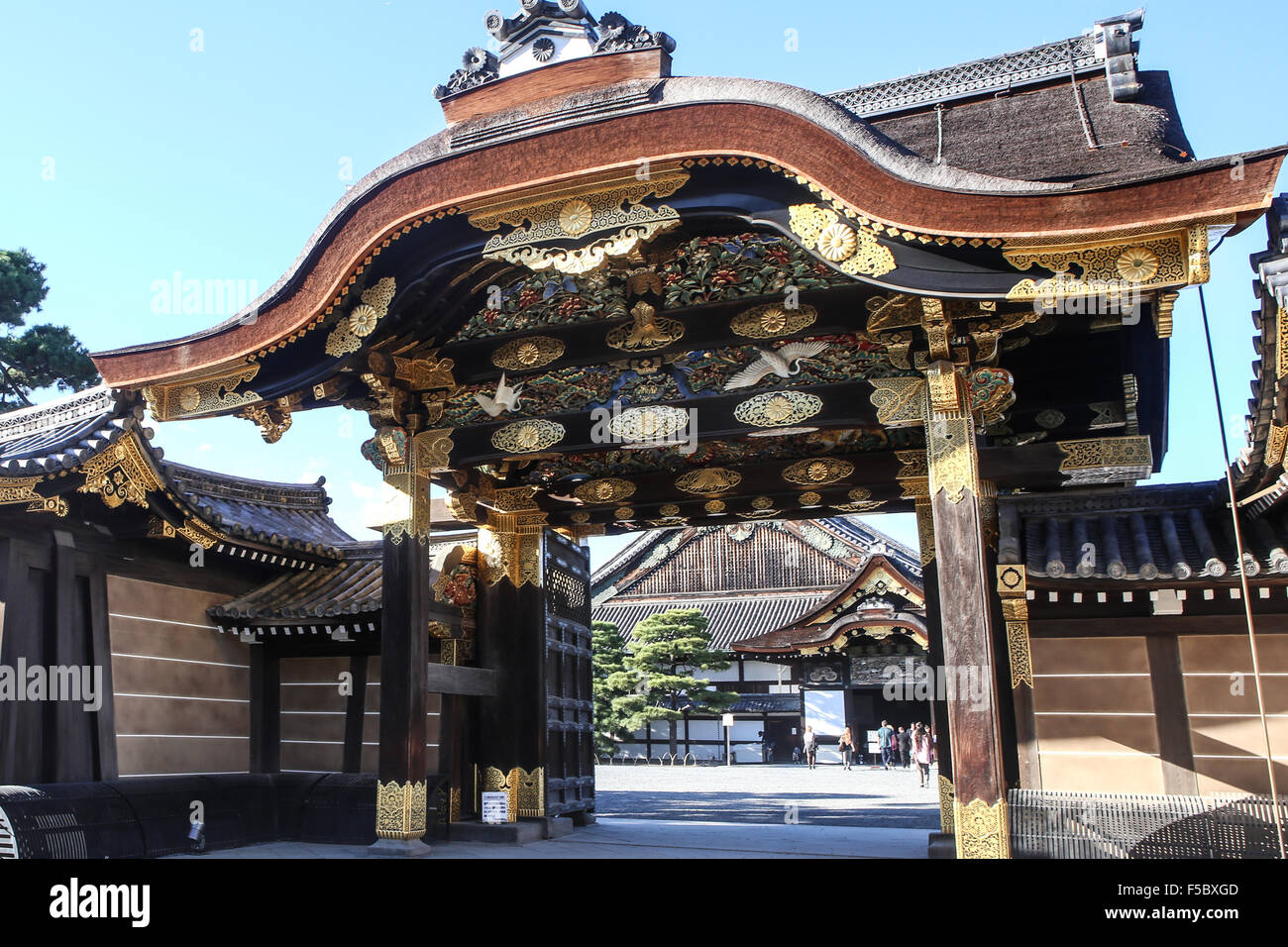 Kyoto imperial palace gate Stock Photohttps://www.alamy.com/image-license-details/?v=1https://www.alamy.com/stock-photo-kyoto-imperial-palace-gate-89387437.html
Kyoto imperial palace gate Stock Photohttps://www.alamy.com/image-license-details/?v=1https://www.alamy.com/stock-photo-kyoto-imperial-palace-gate-89387437.htmlRFF5BXGD–Kyoto imperial palace gate
 . English: Bird's-eye view of the Meiji palace which was completed in October 1888. 日本語: 大日本帝国御造営之図 加藤兵太郎著 翠月堂詞書 明治21(1888)刊 加藤兵太郎 請求記号:加2087 . 19th century. Ukiyo-e artist 610 Tokyo Imperial Palace pic 08 Stock Photohttps://www.alamy.com/image-license-details/?v=1https://www.alamy.com/english-birds-eye-view-of-the-meiji-palace-which-was-completed-in-october-1888-211888-2087-19th-century-ukiyo-e-artist-610-tokyo-imperial-palace-pic-08-image188023116.html
. English: Bird's-eye view of the Meiji palace which was completed in October 1888. 日本語: 大日本帝国御造営之図 加藤兵太郎著 翠月堂詞書 明治21(1888)刊 加藤兵太郎 請求記号:加2087 . 19th century. Ukiyo-e artist 610 Tokyo Imperial Palace pic 08 Stock Photohttps://www.alamy.com/image-license-details/?v=1https://www.alamy.com/english-birds-eye-view-of-the-meiji-palace-which-was-completed-in-october-1888-211888-2087-19th-century-ukiyo-e-artist-610-tokyo-imperial-palace-pic-08-image188023116.htmlRMMWW5B8–. English: Bird's-eye view of the Meiji palace which was completed in October 1888. 日本語: 大日本帝国御造営之図 加藤兵太郎著 翠月堂詞書 明治21(1888)刊 加藤兵太郎 請求記号:加2087 . 19th century. Ukiyo-e artist 610 Tokyo Imperial Palace pic 08
![[ 1890s Japan - Nijubashi Bridge at the Imperial Palace in Tokyo ] — Nijubashi at the Imperial Palace in Tokyo. 19th century vintage albumen photograph. Stock Photo [ 1890s Japan - Nijubashi Bridge at the Imperial Palace in Tokyo ] — Nijubashi at the Imperial Palace in Tokyo. 19th century vintage albumen photograph. Stock Photo](https://c8.alamy.com/comp/PH0F80/1890s-japan-nijubashi-bridge-at-the-imperial-palace-in-tokyo-nijubashi-at-the-imperial-palace-in-tokyo-19th-century-vintage-albumen-photograph-PH0F80.jpg) [ 1890s Japan - Nijubashi Bridge at the Imperial Palace in Tokyo ] — Nijubashi at the Imperial Palace in Tokyo. 19th century vintage albumen photograph. Stock Photohttps://www.alamy.com/image-license-details/?v=1https://www.alamy.com/1890s-japan-nijubashi-bridge-at-the-imperial-palace-in-tokyo-nijubashi-at-the-imperial-palace-in-tokyo-19th-century-vintage-albumen-photograph-image216985552.html
[ 1890s Japan - Nijubashi Bridge at the Imperial Palace in Tokyo ] — Nijubashi at the Imperial Palace in Tokyo. 19th century vintage albumen photograph. Stock Photohttps://www.alamy.com/image-license-details/?v=1https://www.alamy.com/1890s-japan-nijubashi-bridge-at-the-imperial-palace-in-tokyo-nijubashi-at-the-imperial-palace-in-tokyo-19th-century-vintage-albumen-photograph-image216985552.htmlRMPH0F80–[ 1890s Japan - Nijubashi Bridge at the Imperial Palace in Tokyo ] — Nijubashi at the Imperial Palace in Tokyo. 19th century vintage albumen photograph.
 c. 1880s Japan - gate of Imperial Palace, Tokyo Stock Photohttps://www.alamy.com/image-license-details/?v=1https://www.alamy.com/c-1880s-japan-gate-of-imperial-palace-tokyo-image485672794.html
c. 1880s Japan - gate of Imperial Palace, Tokyo Stock Photohttps://www.alamy.com/image-license-details/?v=1https://www.alamy.com/c-1880s-japan-gate-of-imperial-palace-tokyo-image485672794.htmlRM2K648GX–c. 1880s Japan - gate of Imperial Palace, Tokyo
 Banquet inside the Korean Royal Palace, Watanabe Nobukazu, Japanese, 1872–1944, Meiji period, 1868–1912, Hasegawa Sonokichi, Japanese, active late 19th–early 20th century, 1894, Triptych of color woodblock prints, Made in Japan, Asia, Prints, triptych as mounted: 14 1/2 × 28 7/16 in. (36.8 × 72.2 cm Stock Photohttps://www.alamy.com/image-license-details/?v=1https://www.alamy.com/banquet-inside-the-korean-royal-palace-watanabe-nobukazu-japanese-18721944-meiji-period-18681912-hasegawa-sonokichi-japanese-active-late-19thearly-20th-century-1894-triptych-of-color-woodblock-prints-made-in-japan-asia-prints-triptych-as-mounted-14-12-28-716-in-368-722-cm-image454292305.html
Banquet inside the Korean Royal Palace, Watanabe Nobukazu, Japanese, 1872–1944, Meiji period, 1868–1912, Hasegawa Sonokichi, Japanese, active late 19th–early 20th century, 1894, Triptych of color woodblock prints, Made in Japan, Asia, Prints, triptych as mounted: 14 1/2 × 28 7/16 in. (36.8 × 72.2 cm Stock Photohttps://www.alamy.com/image-license-details/?v=1https://www.alamy.com/banquet-inside-the-korean-royal-palace-watanabe-nobukazu-japanese-18721944-meiji-period-18681912-hasegawa-sonokichi-japanese-active-late-19thearly-20th-century-1894-triptych-of-color-woodblock-prints-made-in-japan-asia-prints-triptych-as-mounted-14-12-28-716-in-368-722-cm-image454292305.htmlRM2HB2PD5–Banquet inside the Korean Royal Palace, Watanabe Nobukazu, Japanese, 1872–1944, Meiji period, 1868–1912, Hasegawa Sonokichi, Japanese, active late 19th–early 20th century, 1894, Triptych of color woodblock prints, Made in Japan, Asia, Prints, triptych as mounted: 14 1/2 × 28 7/16 in. (36.8 × 72.2 cm
 Inspired by Banquet inside the Korean Royal Palace, Watanabe Nobukazu, Japanese, 1872–1944, Meiji period, 1868–1912, Hasegawa Sonokichi, Japanese, active late 19th–early 20th century, 1894, Triptych of color woodblock prints, Made in Japan, Asia, Prints, triptych as mounted: 14 1/2 × 28 7/16 in. (36., Reimagined by Artotop. Classic art reinvented with a modern twist. Design of warm cheerful glowing of brightness and light ray radiance. Photography inspired by surrealism and futurism, embracing dynamic energy of modern technology, movement, speed and revolutionize culture Stock Photohttps://www.alamy.com/image-license-details/?v=1https://www.alamy.com/inspired-by-banquet-inside-the-korean-royal-palace-watanabe-nobukazu-japanese-18721944-meiji-period-18681912-hasegawa-sonokichi-japanese-active-late-19thearly-20th-century-1894-triptych-of-color-woodblock-prints-made-in-japan-asia-prints-triptych-as-mounted-14-12-28-716-in-36-reimagined-by-artotop-classic-art-reinvented-with-a-modern-twist-design-of-warm-cheerful-glowing-of-brightness-and-light-ray-radiance-photography-inspired-by-surrealism-and-futurism-embracing-dynamic-energy-of-modern-technology-movement-speed-and-revolutionize-culture-image459279982.html
Inspired by Banquet inside the Korean Royal Palace, Watanabe Nobukazu, Japanese, 1872–1944, Meiji period, 1868–1912, Hasegawa Sonokichi, Japanese, active late 19th–early 20th century, 1894, Triptych of color woodblock prints, Made in Japan, Asia, Prints, triptych as mounted: 14 1/2 × 28 7/16 in. (36., Reimagined by Artotop. Classic art reinvented with a modern twist. Design of warm cheerful glowing of brightness and light ray radiance. Photography inspired by surrealism and futurism, embracing dynamic energy of modern technology, movement, speed and revolutionize culture Stock Photohttps://www.alamy.com/image-license-details/?v=1https://www.alamy.com/inspired-by-banquet-inside-the-korean-royal-palace-watanabe-nobukazu-japanese-18721944-meiji-period-18681912-hasegawa-sonokichi-japanese-active-late-19thearly-20th-century-1894-triptych-of-color-woodblock-prints-made-in-japan-asia-prints-triptych-as-mounted-14-12-28-716-in-36-reimagined-by-artotop-classic-art-reinvented-with-a-modern-twist-design-of-warm-cheerful-glowing-of-brightness-and-light-ray-radiance-photography-inspired-by-surrealism-and-futurism-embracing-dynamic-energy-of-modern-technology-movement-speed-and-revolutionize-culture-image459279982.htmlRF2HK608E–Inspired by Banquet inside the Korean Royal Palace, Watanabe Nobukazu, Japanese, 1872–1944, Meiji period, 1868–1912, Hasegawa Sonokichi, Japanese, active late 19th–early 20th century, 1894, Triptych of color woodblock prints, Made in Japan, Asia, Prints, triptych as mounted: 14 1/2 × 28 7/16 in. (36., Reimagined by Artotop. Classic art reinvented with a modern twist. Design of warm cheerful glowing of brightness and light ray radiance. Photography inspired by surrealism and futurism, embracing dynamic energy of modern technology, movement, speed and revolutionize culture
 Investiture of the Crown Prince, Artist Hashimoto Eihō (1886-1944), from old postcard of Meiji Memorial Picture Gallery Date of event November 10th, 1860 Stock Photohttps://www.alamy.com/image-license-details/?v=1https://www.alamy.com/investiture-of-the-crown-prince-artist-hashimoto-eih-1886-1944-from-old-postcard-of-meiji-memorial-picture-gallery-date-of-event-november-10th-1860-image484675199.html
Investiture of the Crown Prince, Artist Hashimoto Eihō (1886-1944), from old postcard of Meiji Memorial Picture Gallery Date of event November 10th, 1860 Stock Photohttps://www.alamy.com/image-license-details/?v=1https://www.alamy.com/investiture-of-the-crown-prince-artist-hashimoto-eih-1886-1944-from-old-postcard-of-meiji-memorial-picture-gallery-date-of-event-november-10th-1860-image484675199.htmlRM2K4ET4F–Investiture of the Crown Prince, Artist Hashimoto Eihō (1886-1944), from old postcard of Meiji Memorial Picture Gallery Date of event November 10th, 1860
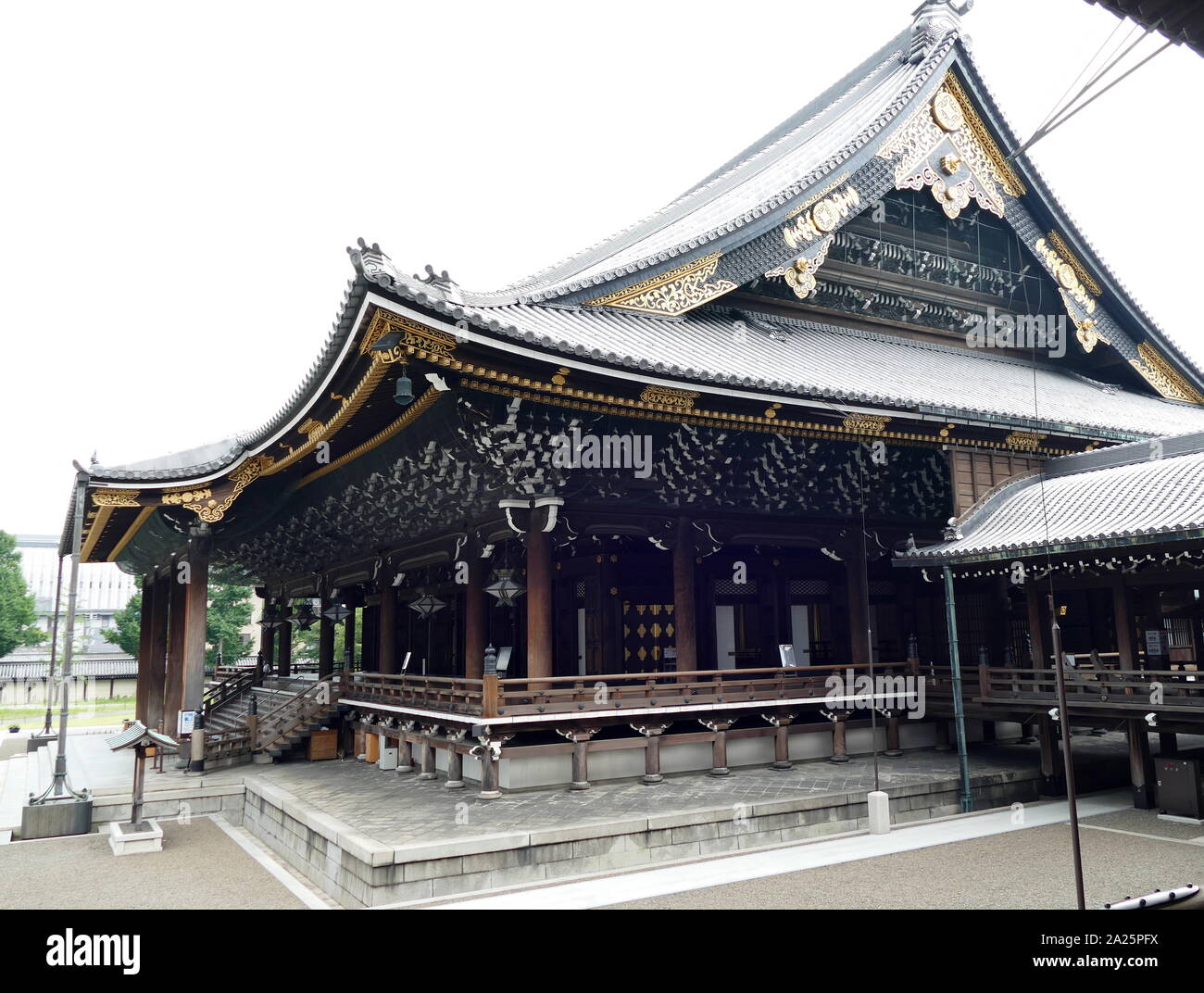 The Kyoto Imperial Palace is the former ruling palace of the Emperor of Japan. The Emperors have since resided at the Tokyo Imperial Palace after the Meiji Restoration in 1869, and the preservation of the Kyoto Imperial Palace was ordered in 1877 Stock Photohttps://www.alamy.com/image-license-details/?v=1https://www.alamy.com/the-kyoto-imperial-palace-is-the-former-ruling-palace-of-the-emperor-of-japan-the-emperors-have-since-resided-at-the-tokyo-imperial-palace-after-the-meiji-restoration-in-1869-and-the-preservation-of-the-kyoto-imperial-palace-was-ordered-in-1877-image328353758.html
The Kyoto Imperial Palace is the former ruling palace of the Emperor of Japan. The Emperors have since resided at the Tokyo Imperial Palace after the Meiji Restoration in 1869, and the preservation of the Kyoto Imperial Palace was ordered in 1877 Stock Photohttps://www.alamy.com/image-license-details/?v=1https://www.alamy.com/the-kyoto-imperial-palace-is-the-former-ruling-palace-of-the-emperor-of-japan-the-emperors-have-since-resided-at-the-tokyo-imperial-palace-after-the-meiji-restoration-in-1869-and-the-preservation-of-the-kyoto-imperial-palace-was-ordered-in-1877-image328353758.htmlRM2A25PFX–The Kyoto Imperial Palace is the former ruling palace of the Emperor of Japan. The Emperors have since resided at the Tokyo Imperial Palace after the Meiji Restoration in 1869, and the preservation of the Kyoto Imperial Palace was ordered in 1877
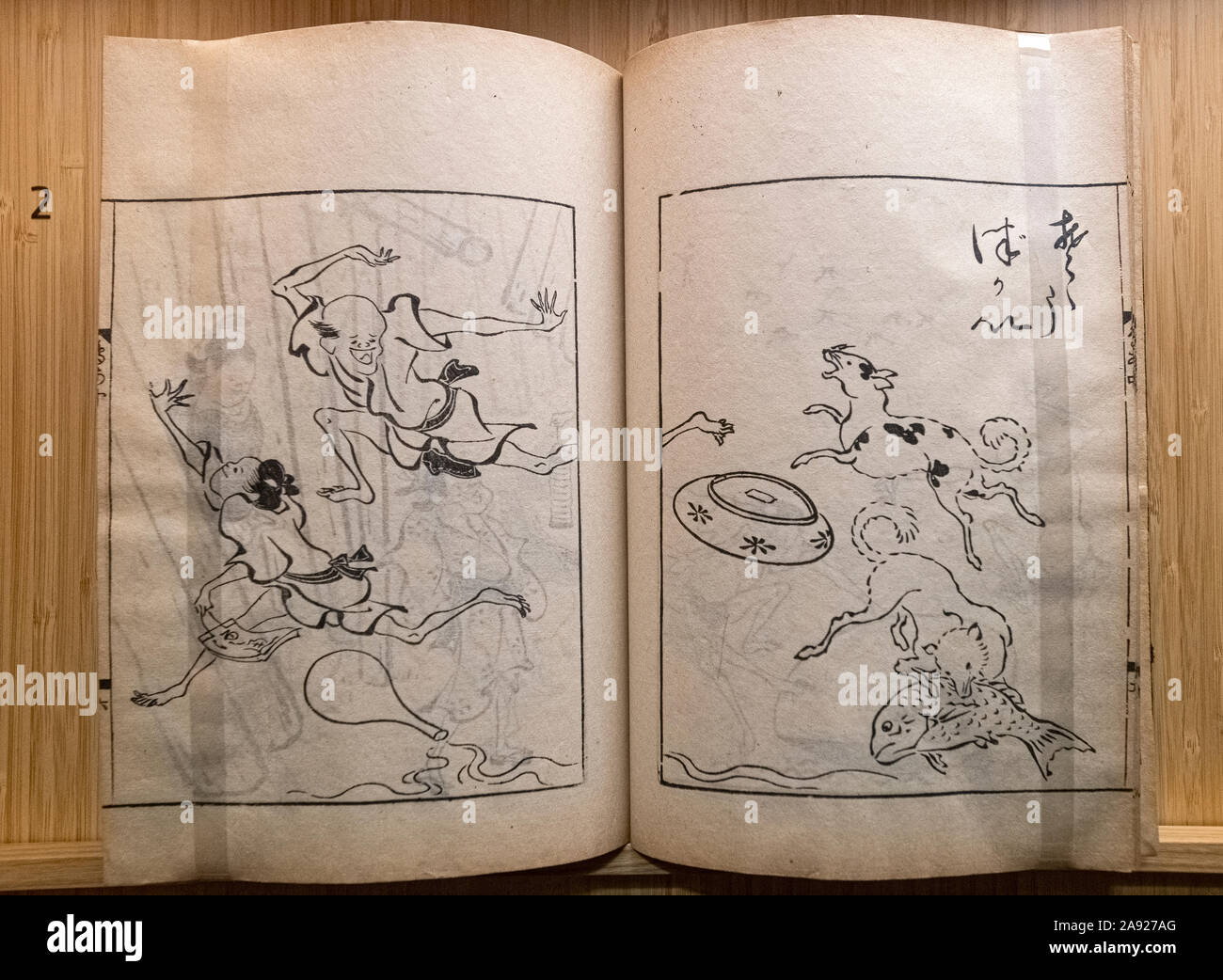 Italy Piedmont Turin - Mazzonis Palace - Mao Museum ( Museo d'Arte Orientale ) - Museum of Oriental art - Shunchosai Takehara ( ? - 1800 ) - Taba-e akubi -dome ( Toba style drawings ' to stop yawning ' ) Edo or Meiji Period Second half of the 19th century Stock Photohttps://www.alamy.com/image-license-details/?v=1https://www.alamy.com/italy-piedmont-turin-mazzonis-palace-mao-museum-museo-darte-orientale-museum-of-oriental-art-shunchosai-takehara-1800-taba-e-akubi-dome-toba-style-drawings-to-stop-yawning-edo-or-meiji-period-second-half-of-the-19th-century-image332578584.html
Italy Piedmont Turin - Mazzonis Palace - Mao Museum ( Museo d'Arte Orientale ) - Museum of Oriental art - Shunchosai Takehara ( ? - 1800 ) - Taba-e akubi -dome ( Toba style drawings ' to stop yawning ' ) Edo or Meiji Period Second half of the 19th century Stock Photohttps://www.alamy.com/image-license-details/?v=1https://www.alamy.com/italy-piedmont-turin-mazzonis-palace-mao-museum-museo-darte-orientale-museum-of-oriental-art-shunchosai-takehara-1800-taba-e-akubi-dome-toba-style-drawings-to-stop-yawning-edo-or-meiji-period-second-half-of-the-19th-century-image332578584.htmlRM2A927AG–Italy Piedmont Turin - Mazzonis Palace - Mao Museum ( Museo d'Arte Orientale ) - Museum of Oriental art - Shunchosai Takehara ( ? - 1800 ) - Taba-e akubi -dome ( Toba style drawings ' to stop yawning ' ) Edo or Meiji Period Second half of the 19th century
 Triple gable roof of the main entrance to Omima hall at the Old Imperial Palace in Kyoto also known as the Gosho Stock Photohttps://www.alamy.com/image-license-details/?v=1https://www.alamy.com/stock-photo-triple-gable-roof-of-the-main-entrance-to-omima-hall-at-the-old-imperial-19177207.html
Triple gable roof of the main entrance to Omima hall at the Old Imperial Palace in Kyoto also known as the Gosho Stock Photohttps://www.alamy.com/image-license-details/?v=1https://www.alamy.com/stock-photo-triple-gable-roof-of-the-main-entrance-to-omima-hall-at-the-old-imperial-19177207.htmlRMB35GM7–Triple gable roof of the main entrance to Omima hall at the Old Imperial Palace in Kyoto also known as the Gosho
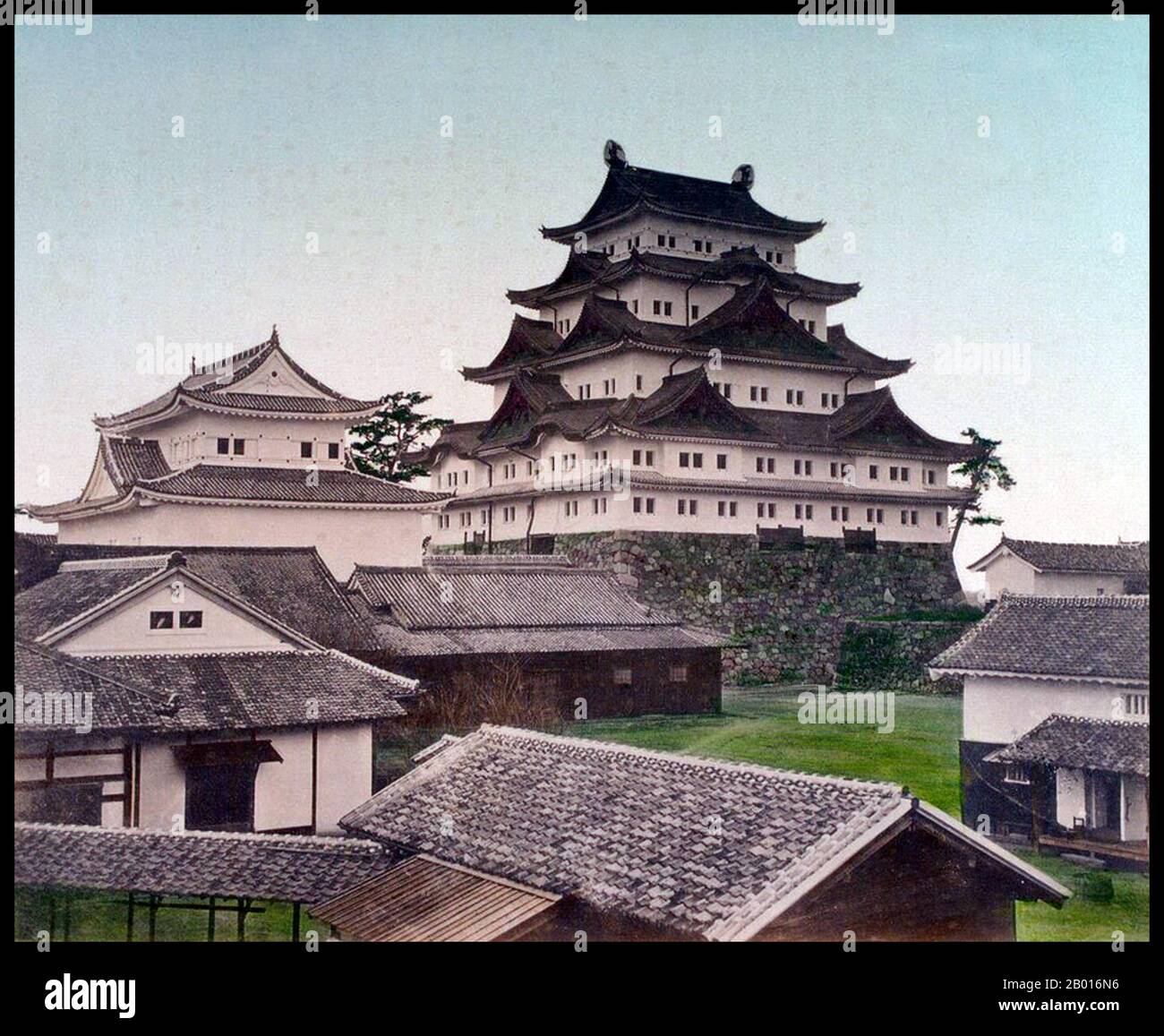 Japan: Nagoya Castle. Photograph by Tamamura Kozaburo (1856-1923), c. 1879. Nagoya Castle (Nagoya-jō) is a castle located in Nagoya, central Japan. It was built by the Owari Domain in 1612. During the Edo period, Nagoya Castle was the centre of one of the most important castle towns in Japan—Nagoya-juku— and it included the most significant stops along the Minoji, which linked the Tōkaidō with the Nakasendō (major national highways). Stock Photohttps://www.alamy.com/image-license-details/?v=1https://www.alamy.com/japan-nagoya-castle-photograph-by-tamamura-kozaburo-1856-1923-c-1879-nagoya-castle-nagoya-j-is-a-castle-located-in-nagoya-central-japan-it-was-built-by-the-owari-domain-in-1612-during-the-edo-period-nagoya-castle-was-the-centre-of-one-of-the-most-important-castle-towns-in-japannagoya-juku-and-it-included-the-most-significant-stops-along-the-minoji-which-linked-the-tkaid-with-the-nakasend-major-national-highways-image344234610.html
Japan: Nagoya Castle. Photograph by Tamamura Kozaburo (1856-1923), c. 1879. Nagoya Castle (Nagoya-jō) is a castle located in Nagoya, central Japan. It was built by the Owari Domain in 1612. During the Edo period, Nagoya Castle was the centre of one of the most important castle towns in Japan—Nagoya-juku— and it included the most significant stops along the Minoji, which linked the Tōkaidō with the Nakasendō (major national highways). Stock Photohttps://www.alamy.com/image-license-details/?v=1https://www.alamy.com/japan-nagoya-castle-photograph-by-tamamura-kozaburo-1856-1923-c-1879-nagoya-castle-nagoya-j-is-a-castle-located-in-nagoya-central-japan-it-was-built-by-the-owari-domain-in-1612-during-the-edo-period-nagoya-castle-was-the-centre-of-one-of-the-most-important-castle-towns-in-japannagoya-juku-and-it-included-the-most-significant-stops-along-the-minoji-which-linked-the-tkaid-with-the-nakasend-major-national-highways-image344234610.htmlRM2B016N6–Japan: Nagoya Castle. Photograph by Tamamura Kozaburo (1856-1923), c. 1879. Nagoya Castle (Nagoya-jō) is a castle located in Nagoya, central Japan. It was built by the Owari Domain in 1612. During the Edo period, Nagoya Castle was the centre of one of the most important castle towns in Japan—Nagoya-juku— and it included the most significant stops along the Minoji, which linked the Tōkaidō with the Nakasendō (major national highways).
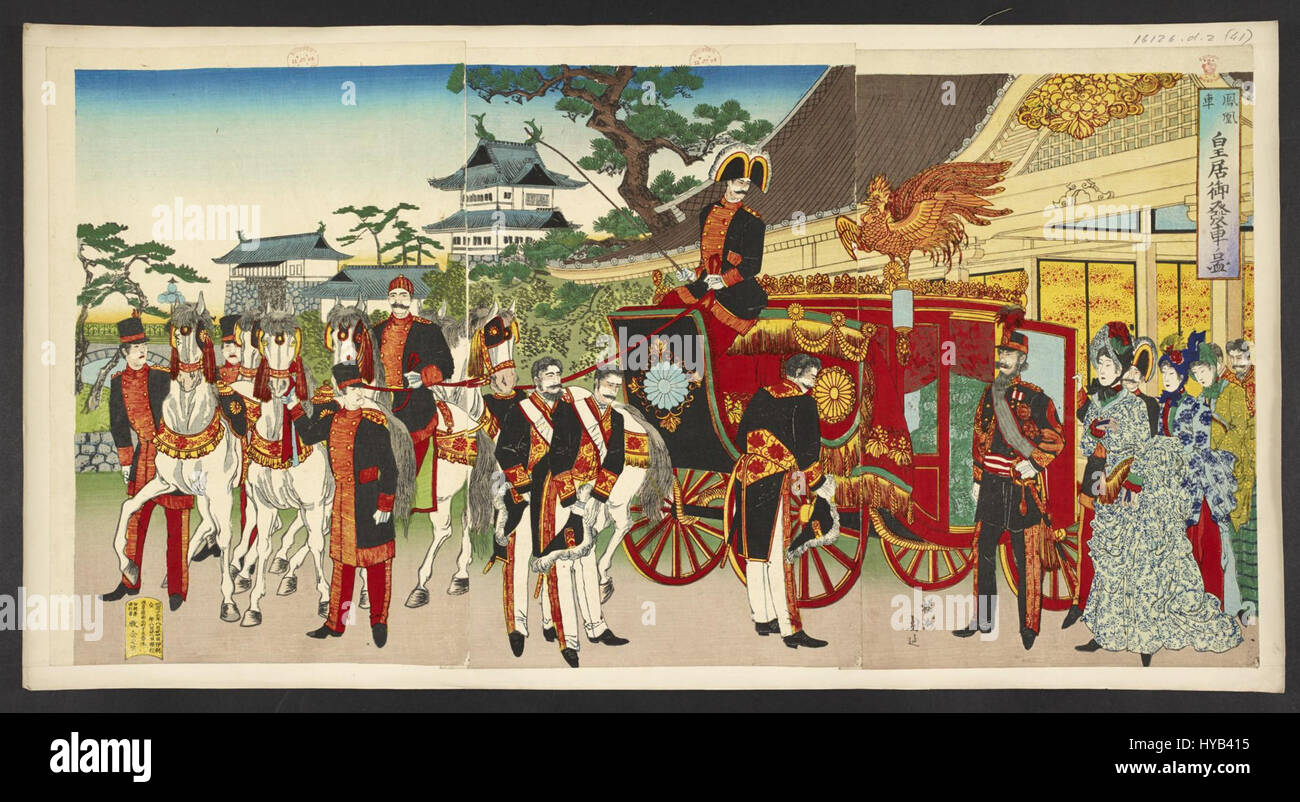 16126.d.2(41) Emperor Meiji prepares to leave the Palace in the Phoenix Carriage Stock Photohttps://www.alamy.com/image-license-details/?v=1https://www.alamy.com/stock-photo-16126d241-emperor-meiji-prepares-to-leave-the-palace-in-the-phoenix-137312929.html
16126.d.2(41) Emperor Meiji prepares to leave the Palace in the Phoenix Carriage Stock Photohttps://www.alamy.com/image-license-details/?v=1https://www.alamy.com/stock-photo-16126d241-emperor-meiji-prepares-to-leave-the-palace-in-the-phoenix-137312929.htmlRMHYB415–16126.d.2(41) Emperor Meiji prepares to leave the Palace in the Phoenix Carriage
 Tripartite Pact Sighing celebrated... After attending meeting held at several places in Tokyo today. those taking part assembled on the plaza in front of the In perial Palace and shouted three banzai for the Emperor. The meetings were held in parks at Hibiya, Ueno, Hamecho, Shiba and Korakuen and the outer garden of the Meiji shrine. October 13, 1940. Stock Photohttps://www.alamy.com/image-license-details/?v=1https://www.alamy.com/tripartite-pact-sighing-celebrated-after-attending-meeting-held-at-several-places-in-tokyo-today-those-taking-part-assembled-on-the-plaza-in-front-of-the-in-perial-palace-and-shouted-three-banzai-for-the-emperor-the-meetings-were-held-in-parks-at-hibiya-ueno-hamecho-shiba-and-korakuen-and-the-outer-garden-of-the-meiji-shrine-october-13-1940-image624685072.html
Tripartite Pact Sighing celebrated... After attending meeting held at several places in Tokyo today. those taking part assembled on the plaza in front of the In perial Palace and shouted three banzai for the Emperor. The meetings were held in parks at Hibiya, Ueno, Hamecho, Shiba and Korakuen and the outer garden of the Meiji shrine. October 13, 1940. Stock Photohttps://www.alamy.com/image-license-details/?v=1https://www.alamy.com/tripartite-pact-sighing-celebrated-after-attending-meeting-held-at-several-places-in-tokyo-today-those-taking-part-assembled-on-the-plaza-in-front-of-the-in-perial-palace-and-shouted-three-banzai-for-the-emperor-the-meetings-were-held-in-parks-at-hibiya-ueno-hamecho-shiba-and-korakuen-and-the-outer-garden-of-the-meiji-shrine-october-13-1940-image624685072.htmlRM2Y88T54–Tripartite Pact Sighing celebrated... After attending meeting held at several places in Tokyo today. those taking part assembled on the plaza in front of the In perial Palace and shouted three banzai for the Emperor. The meetings were held in parks at Hibiya, Ueno, Hamecho, Shiba and Korakuen and the outer garden of the Meiji shrine. October 13, 1940.
 c. 1880s Japan - the moat of Tokyo Castle Stock Photohttps://www.alamy.com/image-license-details/?v=1https://www.alamy.com/stock-photo-c-1880s-japan-the-moat-of-tokyo-castle-172628927.html
c. 1880s Japan - the moat of Tokyo Castle Stock Photohttps://www.alamy.com/image-license-details/?v=1https://www.alamy.com/stock-photo-c-1880s-japan-the-moat-of-tokyo-castle-172628927.htmlRMM0RWXR–c. 1880s Japan - the moat of Tokyo Castle
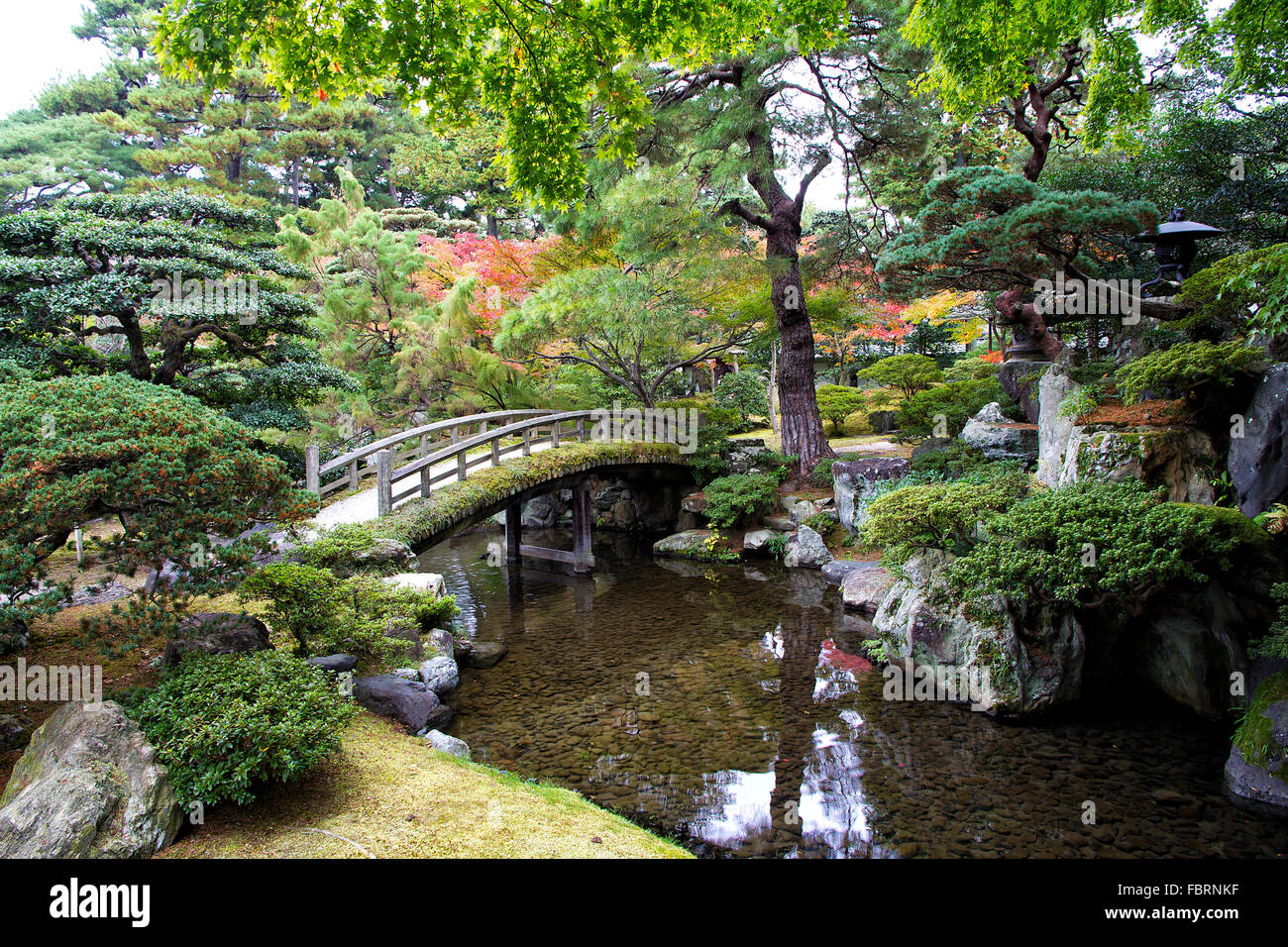 The Kyoto Imperial Palace, Kyoto, Japan Stock Photohttps://www.alamy.com/image-license-details/?v=1https://www.alamy.com/stock-photo-the-kyoto-imperial-palace-kyoto-japan-93334963.html
The Kyoto Imperial Palace, Kyoto, Japan Stock Photohttps://www.alamy.com/image-license-details/?v=1https://www.alamy.com/stock-photo-the-kyoto-imperial-palace-kyoto-japan-93334963.htmlRMFBRNKF–The Kyoto Imperial Palace, Kyoto, Japan
 Old Edo Castle Tokyo Imperial Palace, Chiyoda Ward, Tokyo, Japan Stock Photohttps://www.alamy.com/image-license-details/?v=1https://www.alamy.com/old-edo-castle-tokyo-imperial-palace-chiyoda-ward-tokyo-japan-image353430654.html
Old Edo Castle Tokyo Imperial Palace, Chiyoda Ward, Tokyo, Japan Stock Photohttps://www.alamy.com/image-license-details/?v=1https://www.alamy.com/old-edo-castle-tokyo-imperial-palace-chiyoda-ward-tokyo-japan-image353430654.htmlRF2BF04BA–Old Edo Castle Tokyo Imperial Palace, Chiyoda Ward, Tokyo, Japan
 The Nijubashi bridge at Imperial Palace, Tokyo JP Stock Photohttps://www.alamy.com/image-license-details/?v=1https://www.alamy.com/stock-photo-the-nijubashi-bridge-at-imperial-palace-tokyo-jp-13533567.html
The Nijubashi bridge at Imperial Palace, Tokyo JP Stock Photohttps://www.alamy.com/image-license-details/?v=1https://www.alamy.com/stock-photo-the-nijubashi-bridge-at-imperial-palace-tokyo-jp-13533567.htmlRMAE154G–The Nijubashi bridge at Imperial Palace, Tokyo JP
 Akasaka, Minato-ku, Tokyo Japan Sept 23 2017 Akasaka Palace (Akasaka Rikyu; the State Guest House) and its main gate in Japan. Stock Photohttps://www.alamy.com/image-license-details/?v=1https://www.alamy.com/stock-photo-akasaka-minato-ku-tokyo-japan-sept-23-2017-akasaka-palace-akasaka-172152791.html
Akasaka, Minato-ku, Tokyo Japan Sept 23 2017 Akasaka Palace (Akasaka Rikyu; the State Guest House) and its main gate in Japan. Stock Photohttps://www.alamy.com/image-license-details/?v=1https://www.alamy.com/stock-photo-akasaka-minato-ku-tokyo-japan-sept-23-2017-akasaka-palace-akasaka-172152791.htmlRFM026HY–Akasaka, Minato-ku, Tokyo Japan Sept 23 2017 Akasaka Palace (Akasaka Rikyu; the State Guest House) and its main gate in Japan.
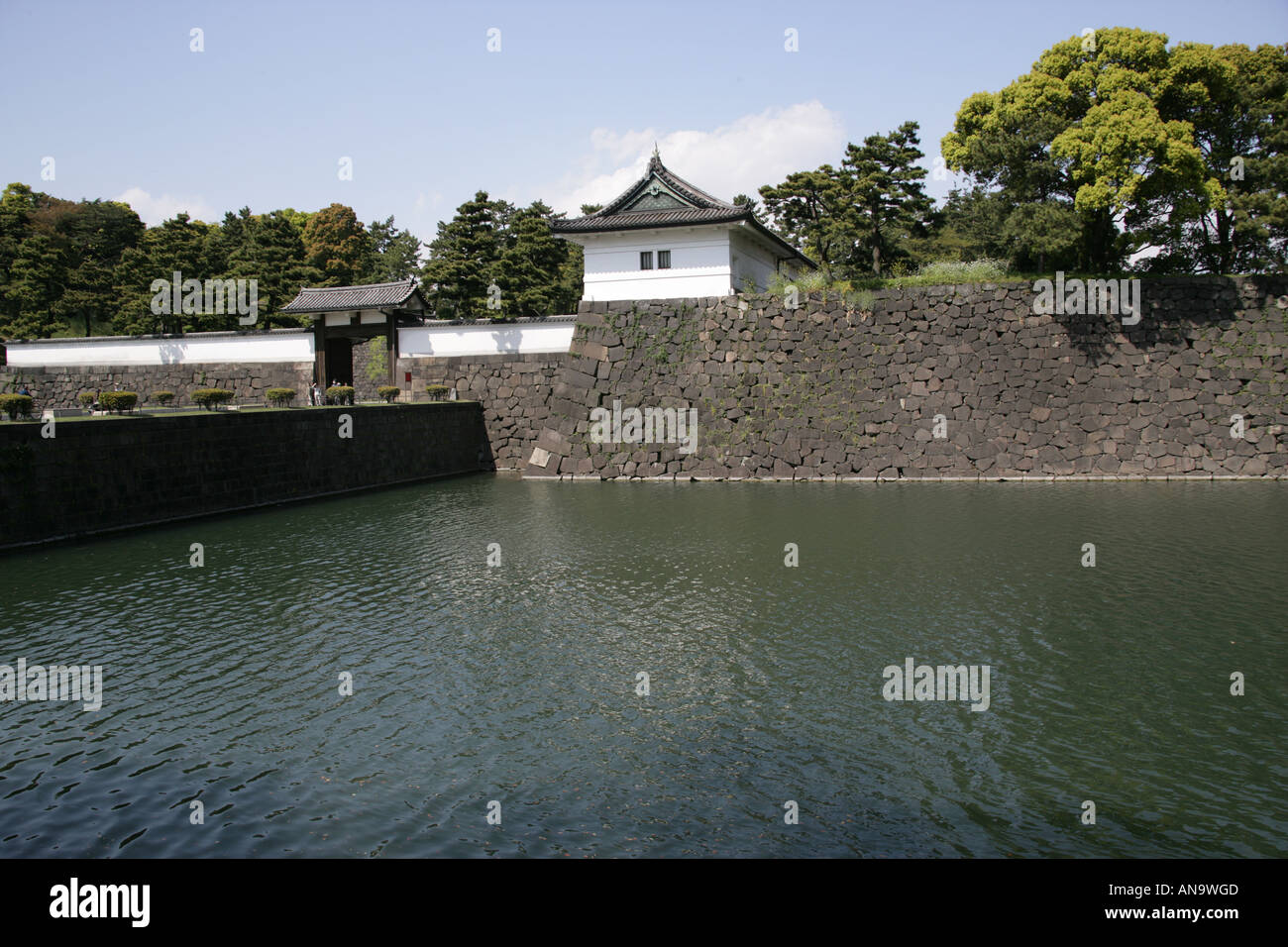 Japanese Imperial Palace Stock Photohttps://www.alamy.com/image-license-details/?v=1https://www.alamy.com/japanese-imperial-palace-image8833996.html
Japanese Imperial Palace Stock Photohttps://www.alamy.com/image-license-details/?v=1https://www.alamy.com/japanese-imperial-palace-image8833996.htmlRFAN9WGD–Japanese Imperial Palace
 facade view of Fukuyama Castle Tenshu in japan Stock Photohttps://www.alamy.com/image-license-details/?v=1https://www.alamy.com/facade-view-of-fukuyama-castle-tenshu-in-japan-image244254468.html
facade view of Fukuyama Castle Tenshu in japan Stock Photohttps://www.alamy.com/image-license-details/?v=1https://www.alamy.com/facade-view-of-fukuyama-castle-tenshu-in-japan-image244254468.htmlRFT5AN1T–facade view of Fukuyama Castle Tenshu in japan
 . English: The Imperial Palace (Meiji palace) audience hall. The audience hall was the central part of the palace. It was the largest building in where honoured guests were received and public events. The floor space was a little more than 223 tsubo (1 tsubo is 3.306 m²). In the interior, the coffered ceiling was traditional Japanese-style, while the floor was parquetry without any traditional dividing sliding doors in the western style. The roof was styled just like in the Kyoto Imperial Palace, but unlike there the roof was not covered in Japanese cypress shingles but with copper plates in o Stock Photohttps://www.alamy.com/image-license-details/?v=1https://www.alamy.com/english-the-imperial-palace-meiji-palace-audience-hall-the-audience-hall-was-the-central-part-of-the-palace-it-was-the-largest-building-in-where-honoured-guests-were-received-and-public-events-the-floor-space-was-a-little-more-than-223-tsubo-1-tsubo-is-3306m-in-the-interior-the-coffered-ceiling-was-traditional-japanese-style-while-the-floor-was-parquetry-without-any-traditional-dividing-sliding-doors-in-the-western-style-the-roof-was-styled-just-like-in-the-kyoto-imperial-palace-but-unlike-there-the-roof-was-not-covered-in-japanese-cypress-shingles-but-with-copper-plates-in-o-image188023124.html
. English: The Imperial Palace (Meiji palace) audience hall. The audience hall was the central part of the palace. It was the largest building in where honoured guests were received and public events. The floor space was a little more than 223 tsubo (1 tsubo is 3.306 m²). In the interior, the coffered ceiling was traditional Japanese-style, while the floor was parquetry without any traditional dividing sliding doors in the western style. The roof was styled just like in the Kyoto Imperial Palace, but unlike there the roof was not covered in Japanese cypress shingles but with copper plates in o Stock Photohttps://www.alamy.com/image-license-details/?v=1https://www.alamy.com/english-the-imperial-palace-meiji-palace-audience-hall-the-audience-hall-was-the-central-part-of-the-palace-it-was-the-largest-building-in-where-honoured-guests-were-received-and-public-events-the-floor-space-was-a-little-more-than-223-tsubo-1-tsubo-is-3306m-in-the-interior-the-coffered-ceiling-was-traditional-japanese-style-while-the-floor-was-parquetry-without-any-traditional-dividing-sliding-doors-in-the-western-style-the-roof-was-styled-just-like-in-the-kyoto-imperial-palace-but-unlike-there-the-roof-was-not-covered-in-japanese-cypress-shingles-but-with-copper-plates-in-o-image188023124.htmlRMMWW5BG–. English: The Imperial Palace (Meiji palace) audience hall. The audience hall was the central part of the palace. It was the largest building in where honoured guests were received and public events. The floor space was a little more than 223 tsubo (1 tsubo is 3.306 m²). In the interior, the coffered ceiling was traditional Japanese-style, while the floor was parquetry without any traditional dividing sliding doors in the western style. The roof was styled just like in the Kyoto Imperial Palace, but unlike there the roof was not covered in Japanese cypress shingles but with copper plates in o
![[ 1900s Japan - Sakurada-mon Gate at Tokyo Imperial Palace ] — The Sakurada-mon Gate at the Imperial palace in Tokyo. 20th century vintage postcard. Stock Photo [ 1900s Japan - Sakurada-mon Gate at Tokyo Imperial Palace ] — The Sakurada-mon Gate at the Imperial palace in Tokyo. 20th century vintage postcard. Stock Photo](https://c8.alamy.com/comp/WP66RY/1900s-japan-sakurada-mon-gate-at-tokyo-imperial-palace-the-sakurada-mon-gate-at-the-imperial-palace-in-tokyo-20th-century-vintage-postcard-WP66RY.jpg) [ 1900s Japan - Sakurada-mon Gate at Tokyo Imperial Palace ] — The Sakurada-mon Gate at the Imperial palace in Tokyo. 20th century vintage postcard. Stock Photohttps://www.alamy.com/image-license-details/?v=1https://www.alamy.com/1900s-japan-sakurada-mon-gate-at-tokyo-imperial-palace-the-sakurada-mon-gate-at-the-imperial-palace-in-tokyo-20th-century-vintage-postcard-image271815039.html
[ 1900s Japan - Sakurada-mon Gate at Tokyo Imperial Palace ] — The Sakurada-mon Gate at the Imperial palace in Tokyo. 20th century vintage postcard. Stock Photohttps://www.alamy.com/image-license-details/?v=1https://www.alamy.com/1900s-japan-sakurada-mon-gate-at-tokyo-imperial-palace-the-sakurada-mon-gate-at-the-imperial-palace-in-tokyo-20th-century-vintage-postcard-image271815039.htmlRMWP66RY–[ 1900s Japan - Sakurada-mon Gate at Tokyo Imperial Palace ] — The Sakurada-mon Gate at the Imperial palace in Tokyo. 20th century vintage postcard.
 Vintage 19th century photograph - Imperial Palace at Hakone, Japan Stock Photohttps://www.alamy.com/image-license-details/?v=1https://www.alamy.com/vintage-19th-century-photograph-imperial-palace-at-hakone-japan-image485668496.html
Vintage 19th century photograph - Imperial Palace at Hakone, Japan Stock Photohttps://www.alamy.com/image-license-details/?v=1https://www.alamy.com/vintage-19th-century-photograph-imperial-palace-at-hakone-japan-image485668496.htmlRM2K6433C–Vintage 19th century photograph - Imperial Palace at Hakone, Japan
 Autumn foliage at the New Imperial Palace, Unidentified Artist, 1888 (Meiji 21, 11th month Stock Photohttps://www.alamy.com/image-license-details/?v=1https://www.alamy.com/stock-image-autumn-foliage-at-the-new-imperial-palace-unidentified-artist-1888-162423149.html
Autumn foliage at the New Imperial Palace, Unidentified Artist, 1888 (Meiji 21, 11th month Stock Photohttps://www.alamy.com/image-license-details/?v=1https://www.alamy.com/stock-image-autumn-foliage-at-the-new-imperial-palace-unidentified-artist-1888-162423149.htmlRMKC70AN–Autumn foliage at the New Imperial Palace, Unidentified Artist, 1888 (Meiji 21, 11th month
 Art inspired by Snow in the Garden, from the Chiyoda Inner Palace, Chikanobu, Japanese, Woodblock print, Japan, 1897, Meiji Period, 13 7/8 x 9 1/4 in., 35.2 x 23.5 cm, kimono, ladies, Leisure, Nature, Outdoors, Season, winter, Classic works modernized by Artotop with a splash of modernity. Shapes, color and value, eye-catching visual impact on art. Emotions through freedom of artworks in a contemporary way. A timeless message pursuing a wildly creative new direction. Artists turning to the digital medium and creating the Artotop NFT Stock Photohttps://www.alamy.com/image-license-details/?v=1https://www.alamy.com/art-inspired-by-snow-in-the-garden-from-the-chiyoda-inner-palace-chikanobu-japanese-woodblock-print-japan-1897-meiji-period-13-78-x-9-14-in-352-x-235-cm-kimono-ladies-leisure-nature-outdoors-season-winter-classic-works-modernized-by-artotop-with-a-splash-of-modernity-shapes-color-and-value-eye-catching-visual-impact-on-art-emotions-through-freedom-of-artworks-in-a-contemporary-way-a-timeless-message-pursuing-a-wildly-creative-new-direction-artists-turning-to-the-digital-medium-and-creating-the-artotop-nft-image459572544.html
Art inspired by Snow in the Garden, from the Chiyoda Inner Palace, Chikanobu, Japanese, Woodblock print, Japan, 1897, Meiji Period, 13 7/8 x 9 1/4 in., 35.2 x 23.5 cm, kimono, ladies, Leisure, Nature, Outdoors, Season, winter, Classic works modernized by Artotop with a splash of modernity. Shapes, color and value, eye-catching visual impact on art. Emotions through freedom of artworks in a contemporary way. A timeless message pursuing a wildly creative new direction. Artists turning to the digital medium and creating the Artotop NFT Stock Photohttps://www.alamy.com/image-license-details/?v=1https://www.alamy.com/art-inspired-by-snow-in-the-garden-from-the-chiyoda-inner-palace-chikanobu-japanese-woodblock-print-japan-1897-meiji-period-13-78-x-9-14-in-352-x-235-cm-kimono-ladies-leisure-nature-outdoors-season-winter-classic-works-modernized-by-artotop-with-a-splash-of-modernity-shapes-color-and-value-eye-catching-visual-impact-on-art-emotions-through-freedom-of-artworks-in-a-contemporary-way-a-timeless-message-pursuing-a-wildly-creative-new-direction-artists-turning-to-the-digital-medium-and-creating-the-artotop-nft-image459572544.htmlRF2HKK9D4–Art inspired by Snow in the Garden, from the Chiyoda Inner Palace, Chikanobu, Japanese, Woodblock print, Japan, 1897, Meiji Period, 13 7/8 x 9 1/4 in., 35.2 x 23.5 cm, kimono, ladies, Leisure, Nature, Outdoors, Season, winter, Classic works modernized by Artotop with a splash of modernity. Shapes, color and value, eye-catching visual impact on art. Emotions through freedom of artworks in a contemporary way. A timeless message pursuing a wildly creative new direction. Artists turning to the digital medium and creating the Artotop NFT
 Enthronement of the Emperor, Artist Ikai Shōkoku(1881-1939), from old postcard of Meiji Memorial Picture Gallery Date of event October 12th,1868 (Meiji 1) Stock Photohttps://www.alamy.com/image-license-details/?v=1https://www.alamy.com/enthronement-of-the-emperor-artist-ikai-shkoku1881-1939-from-old-postcard-of-meiji-memorial-picture-gallery-date-of-event-october-12th1868-meiji-1-image484675674.html
Enthronement of the Emperor, Artist Ikai Shōkoku(1881-1939), from old postcard of Meiji Memorial Picture Gallery Date of event October 12th,1868 (Meiji 1) Stock Photohttps://www.alamy.com/image-license-details/?v=1https://www.alamy.com/enthronement-of-the-emperor-artist-ikai-shkoku1881-1939-from-old-postcard-of-meiji-memorial-picture-gallery-date-of-event-october-12th1868-meiji-1-image484675674.htmlRM2K4ETNE–Enthronement of the Emperor, Artist Ikai Shōkoku(1881-1939), from old postcard of Meiji Memorial Picture Gallery Date of event October 12th,1868 (Meiji 1)
 The Kyoto Imperial Palace is the former ruling palace of the Emperor of Japan. The Emperors have since resided at the Tokyo Imperial Palace after the Meiji Restoration in 1869, and the preservation of the Kyoto Imperial Palace was ordered in 1877 Stock Photohttps://www.alamy.com/image-license-details/?v=1https://www.alamy.com/the-kyoto-imperial-palace-is-the-former-ruling-palace-of-the-emperor-of-japan-the-emperors-have-since-resided-at-the-tokyo-imperial-palace-after-the-meiji-restoration-in-1869-and-the-preservation-of-the-kyoto-imperial-palace-was-ordered-in-1877-image328353748.html
The Kyoto Imperial Palace is the former ruling palace of the Emperor of Japan. The Emperors have since resided at the Tokyo Imperial Palace after the Meiji Restoration in 1869, and the preservation of the Kyoto Imperial Palace was ordered in 1877 Stock Photohttps://www.alamy.com/image-license-details/?v=1https://www.alamy.com/the-kyoto-imperial-palace-is-the-former-ruling-palace-of-the-emperor-of-japan-the-emperors-have-since-resided-at-the-tokyo-imperial-palace-after-the-meiji-restoration-in-1869-and-the-preservation-of-the-kyoto-imperial-palace-was-ordered-in-1877-image328353748.htmlRM2A25PFG–The Kyoto Imperial Palace is the former ruling palace of the Emperor of Japan. The Emperors have since resided at the Tokyo Imperial Palace after the Meiji Restoration in 1869, and the preservation of the Kyoto Imperial Palace was ordered in 1877
 View of the Issuance of the State Constitution in the State Chamber of the New Imperial Palace, March 2, 1889 (Meiji 22). Stock Photohttps://www.alamy.com/image-license-details/?v=1https://www.alamy.com/view-of-the-issuance-of-the-state-constitution-in-the-state-chamber-of-the-new-imperial-palace-march-2-1889-meiji-22-image374723709.html
View of the Issuance of the State Constitution in the State Chamber of the New Imperial Palace, March 2, 1889 (Meiji 22). Stock Photohttps://www.alamy.com/image-license-details/?v=1https://www.alamy.com/view-of-the-issuance-of-the-state-constitution-in-the-state-chamber-of-the-new-imperial-palace-march-2-1889-meiji-22-image374723709.htmlRM2CNJ3WH–View of the Issuance of the State Constitution in the State Chamber of the New Imperial Palace, March 2, 1889 (Meiji 22).
 View of Seiryoden hall through the vermilion Gekkamon gate at the old Imperial Palace or Gosho in the heart of Kyoto city Stock Photohttps://www.alamy.com/image-license-details/?v=1https://www.alamy.com/stock-photo-view-of-seiryoden-hall-through-the-vermilion-gekkamon-gate-at-the-18598097.html
View of Seiryoden hall through the vermilion Gekkamon gate at the old Imperial Palace or Gosho in the heart of Kyoto city Stock Photohttps://www.alamy.com/image-license-details/?v=1https://www.alamy.com/stock-photo-view-of-seiryoden-hall-through-the-vermilion-gekkamon-gate-at-the-18598097.htmlRMB2761N–View of Seiryoden hall through the vermilion Gekkamon gate at the old Imperial Palace or Gosho in the heart of Kyoto city
 16126.d.2(41)-Emperor Meiji prepares to leave the Palace in the Phoenix Carriage. Stock Photohttps://www.alamy.com/image-license-details/?v=1https://www.alamy.com/16126d241-emperor-meiji-prepares-to-leave-the-palace-in-the-phoenix-carriage-image209573524.html
16126.d.2(41)-Emperor Meiji prepares to leave the Palace in the Phoenix Carriage. Stock Photohttps://www.alamy.com/image-license-details/?v=1https://www.alamy.com/16126d241-emperor-meiji-prepares-to-leave-the-palace-in-the-phoenix-carriage-image209573524.htmlRMP4XW4M–16126.d.2(41)-Emperor Meiji prepares to leave the Palace in the Phoenix Carriage.
 The Inner Palace of Chiyoda (Chiyoda no Ooku). Artist: Yoshu (Hashimoto) Chikanobu (Japanese, 1838-1912). Culture: Japan. Dimensions: 9 1/4 × 13 7/8 in. (23.5 × 35.2 cm). Date: 1895. Museum: Metropolitan Museum of Art, New York, USA. Stock Photohttps://www.alamy.com/image-license-details/?v=1https://www.alamy.com/the-inner-palace-of-chiyoda-chiyoda-no-ooku-artist-yoshu-hashimoto-chikanobu-japanese-1838-1912-culture-japan-dimensions-9-14-13-78-in-235-352-cm-date-1895-museum-metropolitan-museum-of-art-new-york-usa-image213163014.html
The Inner Palace of Chiyoda (Chiyoda no Ooku). Artist: Yoshu (Hashimoto) Chikanobu (Japanese, 1838-1912). Culture: Japan. Dimensions: 9 1/4 × 13 7/8 in. (23.5 × 35.2 cm). Date: 1895. Museum: Metropolitan Museum of Art, New York, USA. Stock Photohttps://www.alamy.com/image-license-details/?v=1https://www.alamy.com/the-inner-palace-of-chiyoda-chiyoda-no-ooku-artist-yoshu-hashimoto-chikanobu-japanese-1838-1912-culture-japan-dimensions-9-14-13-78-in-235-352-cm-date-1895-museum-metropolitan-museum-of-art-new-york-usa-image213163014.htmlRMPAPBGP–The Inner Palace of Chiyoda (Chiyoda no Ooku). Artist: Yoshu (Hashimoto) Chikanobu (Japanese, 1838-1912). Culture: Japan. Dimensions: 9 1/4 × 13 7/8 in. (23.5 × 35.2 cm). Date: 1895. Museum: Metropolitan Museum of Art, New York, USA.
 Emperor Meiji prepares to leave the Palace in the Phoenix Carriage . HÅÅsha kÅkyo go-hassha no zu. August 1893. Source: 16126.d.2 (41). Language: Japanese. Author: YÅshu Chikanobu. Stock Photohttps://www.alamy.com/image-license-details/?v=1https://www.alamy.com/emperor-meiji-prepares-to-leave-the-palace-in-the-phoenix-carriage-hsha-kkyo-go-hassha-no-zu-august-1893-source-16126d2-41-language-japanese-author-yshu-chikanobu-image227126820.html
Emperor Meiji prepares to leave the Palace in the Phoenix Carriage . HÅÅsha kÅkyo go-hassha no zu. August 1893. Source: 16126.d.2 (41). Language: Japanese. Author: YÅshu Chikanobu. Stock Photohttps://www.alamy.com/image-license-details/?v=1https://www.alamy.com/emperor-meiji-prepares-to-leave-the-palace-in-the-phoenix-carriage-hsha-kkyo-go-hassha-no-zu-august-1893-source-16126d2-41-language-japanese-author-yshu-chikanobu-image227126820.htmlRMR5EEG4–Emperor Meiji prepares to leave the Palace in the Phoenix Carriage . HÅÅsha kÅkyo go-hassha no zu. August 1893. Source: 16126.d.2 (41). Language: Japanese. Author: YÅshu Chikanobu.
 The Kyoto Imperial Palace is the former ruling palace of the Emperor of Japan. Since the Meiji Restoration in 1869, the Emperors have resided at the Tokyo Imperial Palace, while the preservation of the Kyoto Imperial Palace was ordered in 1877. View of Emperor's carriages. Stock Photohttps://www.alamy.com/image-license-details/?v=1https://www.alamy.com/the-kyoto-imperial-palace-is-the-former-ruling-palace-of-the-emperor-of-japan-since-the-meiji-restoration-in-1869-the-emperors-have-resided-at-the-tokyo-imperial-palace-while-the-preservation-of-the-kyoto-imperial-palace-was-ordered-in-1877-view-of-emperors-carriages-image397964373.html
The Kyoto Imperial Palace is the former ruling palace of the Emperor of Japan. Since the Meiji Restoration in 1869, the Emperors have resided at the Tokyo Imperial Palace, while the preservation of the Kyoto Imperial Palace was ordered in 1877. View of Emperor's carriages. Stock Photohttps://www.alamy.com/image-license-details/?v=1https://www.alamy.com/the-kyoto-imperial-palace-is-the-former-ruling-palace-of-the-emperor-of-japan-since-the-meiji-restoration-in-1869-the-emperors-have-resided-at-the-tokyo-imperial-palace-while-the-preservation-of-the-kyoto-imperial-palace-was-ordered-in-1877-view-of-emperors-carriages-image397964373.htmlRM2E3CRH9–The Kyoto Imperial Palace is the former ruling palace of the Emperor of Japan. Since the Meiji Restoration in 1869, the Emperors have resided at the Tokyo Imperial Palace, while the preservation of the Kyoto Imperial Palace was ordered in 1877. View of Emperor's carriages.
 The Kyoto Imperial Palace, Kyoto, Japan Stock Photohttps://www.alamy.com/image-license-details/?v=1https://www.alamy.com/stock-photo-the-kyoto-imperial-palace-kyoto-japan-93334939.html
The Kyoto Imperial Palace, Kyoto, Japan Stock Photohttps://www.alamy.com/image-license-details/?v=1https://www.alamy.com/stock-photo-the-kyoto-imperial-palace-kyoto-japan-93334939.htmlRMFBRNJK–The Kyoto Imperial Palace, Kyoto, Japan
 Old Edo Castle Tokyo Imperial Palace, Chiyoda Ward, Tokyo, Japan Stock Photohttps://www.alamy.com/image-license-details/?v=1https://www.alamy.com/old-edo-castle-tokyo-imperial-palace-chiyoda-ward-tokyo-japan-image353428799.html
Old Edo Castle Tokyo Imperial Palace, Chiyoda Ward, Tokyo, Japan Stock Photohttps://www.alamy.com/image-license-details/?v=1https://www.alamy.com/old-edo-castle-tokyo-imperial-palace-chiyoda-ward-tokyo-japan-image353428799.htmlRF2BF0213–Old Edo Castle Tokyo Imperial Palace, Chiyoda Ward, Tokyo, Japan
 The guarded entrance to the Imperial Palace, Tokyo JP Stock Photohttps://www.alamy.com/image-license-details/?v=1https://www.alamy.com/stock-photo-the-guarded-entrance-to-the-imperial-palace-tokyo-jp-13528960.html
The guarded entrance to the Imperial Palace, Tokyo JP Stock Photohttps://www.alamy.com/image-license-details/?v=1https://www.alamy.com/stock-photo-the-guarded-entrance-to-the-imperial-palace-tokyo-jp-13528960.htmlRMAE0KCH–The guarded entrance to the Imperial Palace, Tokyo JP
 This is the entrance gate of the Imperial Nijo detached Palace of Tokyo where is the Imperial quarters of H.I.M. the Emperor Kwangte of Manchukuo in his sojourn in Kyoto, The Nijo detached Palace had been formerly the Imperial palace since 16th till the restoration of Meiji period. Now the Palace has been specially reserved as national treasury as the most typical wooden building of the imperial Palace building in Japan. March 06, 1935. (Photo by The Shimbun Rengo News Photos Service). Stock Photohttps://www.alamy.com/image-license-details/?v=1https://www.alamy.com/this-is-the-entrance-gate-of-the-imperial-nijo-detached-palace-of-tokyo-where-is-the-imperial-quarters-of-him-the-emperor-kwangte-of-manchukuo-in-his-sojourn-in-kyoto-the-nijo-detached-palace-had-been-formerly-the-imperial-palace-since-16th-till-the-restoration-of-meiji-period-now-the-palace-has-been-specially-reserved-as-national-treasury-as-the-most-typical-wooden-building-of-the-imperial-palace-building-in-japan-march-06-1935-photo-by-the-shimbun-rengo-news-photos-service-image467218829.html
This is the entrance gate of the Imperial Nijo detached Palace of Tokyo where is the Imperial quarters of H.I.M. the Emperor Kwangte of Manchukuo in his sojourn in Kyoto, The Nijo detached Palace had been formerly the Imperial palace since 16th till the restoration of Meiji period. Now the Palace has been specially reserved as national treasury as the most typical wooden building of the imperial Palace building in Japan. March 06, 1935. (Photo by The Shimbun Rengo News Photos Service). Stock Photohttps://www.alamy.com/image-license-details/?v=1https://www.alamy.com/this-is-the-entrance-gate-of-the-imperial-nijo-detached-palace-of-tokyo-where-is-the-imperial-quarters-of-him-the-emperor-kwangte-of-manchukuo-in-his-sojourn-in-kyoto-the-nijo-detached-palace-had-been-formerly-the-imperial-palace-since-16th-till-the-restoration-of-meiji-period-now-the-palace-has-been-specially-reserved-as-national-treasury-as-the-most-typical-wooden-building-of-the-imperial-palace-building-in-japan-march-06-1935-photo-by-the-shimbun-rengo-news-photos-service-image467218829.htmlRM2J43JAN–This is the entrance gate of the Imperial Nijo detached Palace of Tokyo where is the Imperial quarters of H.I.M. the Emperor Kwangte of Manchukuo in his sojourn in Kyoto, The Nijo detached Palace had been formerly the Imperial palace since 16th till the restoration of Meiji period. Now the Palace has been specially reserved as national treasury as the most typical wooden building of the imperial Palace building in Japan. March 06, 1935. (Photo by The Shimbun Rengo News Photos Service).
 Japanese Imperial Palace Stock Photohttps://www.alamy.com/image-license-details/?v=1https://www.alamy.com/japanese-imperial-palace-image8833989.html
Japanese Imperial Palace Stock Photohttps://www.alamy.com/image-license-details/?v=1https://www.alamy.com/japanese-imperial-palace-image8833989.htmlRFAN9WG6–Japanese Imperial Palace
 night view of Fukuyama Castle Tenshu in japan Stock Photohttps://www.alamy.com/image-license-details/?v=1https://www.alamy.com/night-view-of-fukuyama-castle-tenshu-in-japan-image226298357.html
night view of Fukuyama Castle Tenshu in japan Stock Photohttps://www.alamy.com/image-license-details/?v=1https://www.alamy.com/night-view-of-fukuyama-castle-tenshu-in-japan-image226298357.htmlRFR44NT5–night view of Fukuyama Castle Tenshu in japan
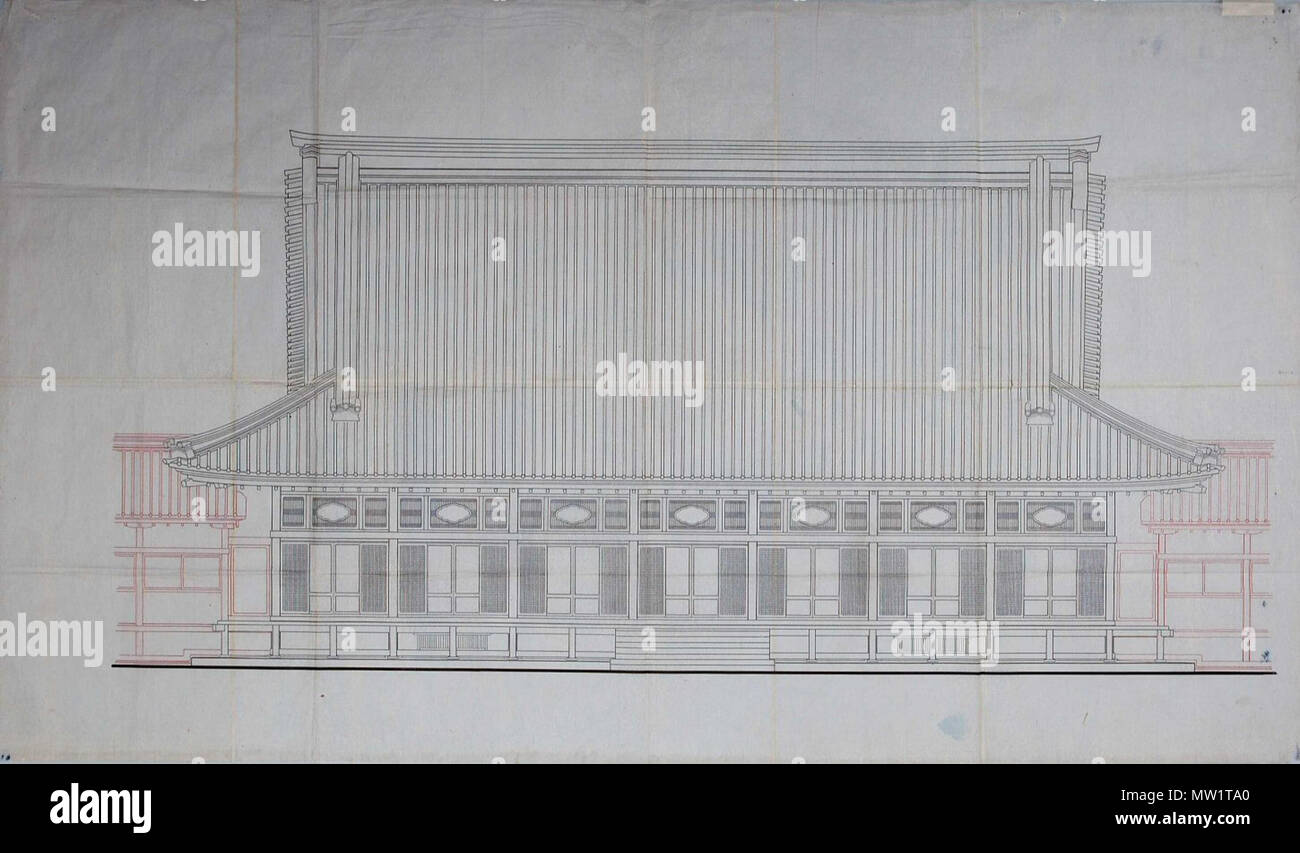 . English: The Imperial Palace (Meiji palace) audience hall. The audience hall was the central part of the palace. It was the largest building in where honoured guests were received and public events. The floor space was a little more than 223 tsubo (1 tsubo is 3.306 m²). In the interior, the coffered ceiling was traditional Japanese-style, while the floor was parquetry without any traditional dividing sliding doors in the western style. The roof was styled just like in the Kyoto Imperial Palace, but unlike there the roof was not covered in Japanese cypress shingles but with copper plates in o Stock Photohttps://www.alamy.com/image-license-details/?v=1https://www.alamy.com/english-the-imperial-palace-meiji-palace-audience-hall-the-audience-hall-was-the-central-part-of-the-palace-it-was-the-largest-building-in-where-honoured-guests-were-received-and-public-events-the-floor-space-was-a-little-more-than-223-tsubo-1-tsubo-is-3306m-in-the-interior-the-coffered-ceiling-was-traditional-japanese-style-while-the-floor-was-parquetry-without-any-traditional-dividing-sliding-doors-in-the-western-style-the-roof-was-styled-just-like-in-the-kyoto-imperial-palace-but-unlike-there-the-roof-was-not-covered-in-japanese-cypress-shingles-but-with-copper-plates-in-o-image187511128.html
. English: The Imperial Palace (Meiji palace) audience hall. The audience hall was the central part of the palace. It was the largest building in where honoured guests were received and public events. The floor space was a little more than 223 tsubo (1 tsubo is 3.306 m²). In the interior, the coffered ceiling was traditional Japanese-style, while the floor was parquetry without any traditional dividing sliding doors in the western style. The roof was styled just like in the Kyoto Imperial Palace, but unlike there the roof was not covered in Japanese cypress shingles but with copper plates in o Stock Photohttps://www.alamy.com/image-license-details/?v=1https://www.alamy.com/english-the-imperial-palace-meiji-palace-audience-hall-the-audience-hall-was-the-central-part-of-the-palace-it-was-the-largest-building-in-where-honoured-guests-were-received-and-public-events-the-floor-space-was-a-little-more-than-223-tsubo-1-tsubo-is-3306m-in-the-interior-the-coffered-ceiling-was-traditional-japanese-style-while-the-floor-was-parquetry-without-any-traditional-dividing-sliding-doors-in-the-western-style-the-roof-was-styled-just-like-in-the-kyoto-imperial-palace-but-unlike-there-the-roof-was-not-covered-in-japanese-cypress-shingles-but-with-copper-plates-in-o-image187511128.htmlRMMW1TA0–. English: The Imperial Palace (Meiji palace) audience hall. The audience hall was the central part of the palace. It was the largest building in where honoured guests were received and public events. The floor space was a little more than 223 tsubo (1 tsubo is 3.306 m²). In the interior, the coffered ceiling was traditional Japanese-style, while the floor was parquetry without any traditional dividing sliding doors in the western style. The roof was styled just like in the Kyoto Imperial Palace, but unlike there the roof was not covered in Japanese cypress shingles but with copper plates in o
![[ 1910s Japan - Prayers for Emperor Meiji ] — Women praying for the recovery of Emperor Meiji in front of Nijubashi Bridge at the Imperial Palace in Tokyo in July 1912 (Meiji 45). Interestingly, at the time this was announced as a request that the Imperial Children of the Emperor pray for his recovery. 20th century vintage postcard. Stock Photo [ 1910s Japan - Prayers for Emperor Meiji ] — Women praying for the recovery of Emperor Meiji in front of Nijubashi Bridge at the Imperial Palace in Tokyo in July 1912 (Meiji 45). Interestingly, at the time this was announced as a request that the Imperial Children of the Emperor pray for his recovery. 20th century vintage postcard. Stock Photo](https://c8.alamy.com/comp/WP5P2R/1910s-japan-prayers-for-emperor-meiji-women-praying-for-the-recovery-of-emperor-meiji-in-front-of-nijubashi-bridge-at-the-imperial-palace-in-tokyo-in-july-1912-meiji-45-interestingly-at-the-time-this-was-announced-as-a-request-that-the-imperial-children-of-the-emperor-pray-for-his-recovery-20th-century-vintage-postcard-WP5P2R.jpg) [ 1910s Japan - Prayers for Emperor Meiji ] — Women praying for the recovery of Emperor Meiji in front of Nijubashi Bridge at the Imperial Palace in Tokyo in July 1912 (Meiji 45). Interestingly, at the time this was announced as a request that the Imperial Children of the Emperor pray for his recovery. 20th century vintage postcard. Stock Photohttps://www.alamy.com/image-license-details/?v=1https://www.alamy.com/1910s-japan-prayers-for-emperor-meiji-women-praying-for-the-recovery-of-emperor-meiji-in-front-of-nijubashi-bridge-at-the-imperial-palace-in-tokyo-in-july-1912-meiji-45-interestingly-at-the-time-this-was-announced-as-a-request-that-the-imperial-children-of-the-emperor-pray-for-his-recovery-20th-century-vintage-postcard-image271805039.html
[ 1910s Japan - Prayers for Emperor Meiji ] — Women praying for the recovery of Emperor Meiji in front of Nijubashi Bridge at the Imperial Palace in Tokyo in July 1912 (Meiji 45). Interestingly, at the time this was announced as a request that the Imperial Children of the Emperor pray for his recovery. 20th century vintage postcard. Stock Photohttps://www.alamy.com/image-license-details/?v=1https://www.alamy.com/1910s-japan-prayers-for-emperor-meiji-women-praying-for-the-recovery-of-emperor-meiji-in-front-of-nijubashi-bridge-at-the-imperial-palace-in-tokyo-in-july-1912-meiji-45-interestingly-at-the-time-this-was-announced-as-a-request-that-the-imperial-children-of-the-emperor-pray-for-his-recovery-20th-century-vintage-postcard-image271805039.htmlRMWP5P2R–[ 1910s Japan - Prayers for Emperor Meiji ] — Women praying for the recovery of Emperor Meiji in front of Nijubashi Bridge at the Imperial Palace in Tokyo in July 1912 (Meiji 45). Interestingly, at the time this was announced as a request that the Imperial Children of the Emperor pray for his recovery. 20th century vintage postcard.
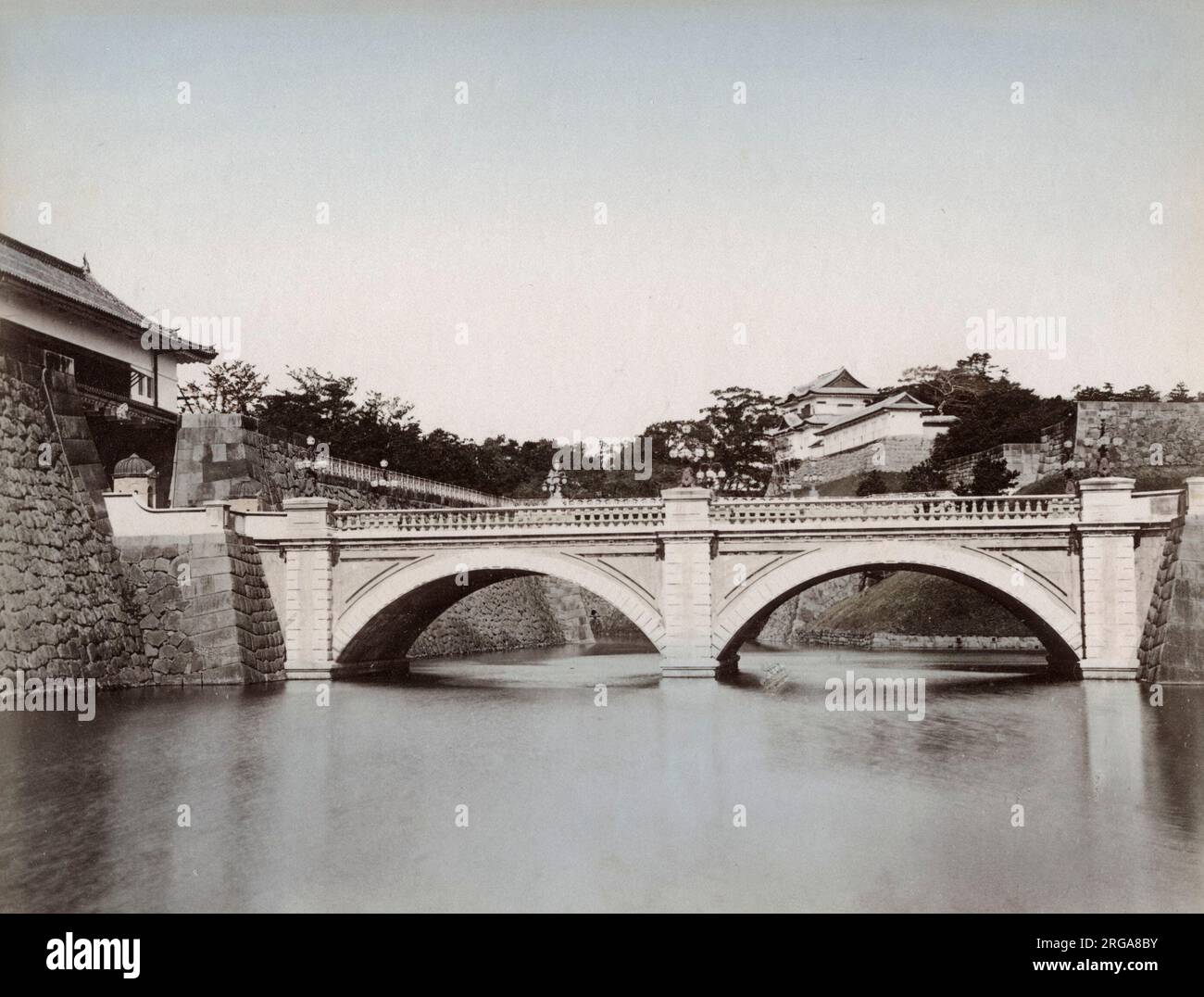 Bridge to the Imperial Palace, Tokyo. Vintage 19th century photograph. Stock Photohttps://www.alamy.com/image-license-details/?v=1https://www.alamy.com/bridge-to-the-imperial-palace-tokyo-vintage-19th-century-photograph-image560792399.html
Bridge to the Imperial Palace, Tokyo. Vintage 19th century photograph. Stock Photohttps://www.alamy.com/image-license-details/?v=1https://www.alamy.com/bridge-to-the-imperial-palace-tokyo-vintage-19th-century-photograph-image560792399.htmlRM2RGA8BY–Bridge to the Imperial Palace, Tokyo. Vintage 19th century photograph.
 千代田の大奥, The Inner Palace of Chiyoda (Chiyoda no Ōoku), Yōshū, 1895 Stock Photohttps://www.alamy.com/image-license-details/?v=1https://www.alamy.com/stock-image-the-inner-palace-of-chiyoda-chiyoda-no-oku-ysh-1895-162423598.html
千代田の大奥, The Inner Palace of Chiyoda (Chiyoda no Ōoku), Yōshū, 1895 Stock Photohttps://www.alamy.com/image-license-details/?v=1https://www.alamy.com/stock-image-the-inner-palace-of-chiyoda-chiyoda-no-oku-ysh-1895-162423598.htmlRMKC70XP–千代田の大奥, The Inner Palace of Chiyoda (Chiyoda no Ōoku), Yōshū, 1895
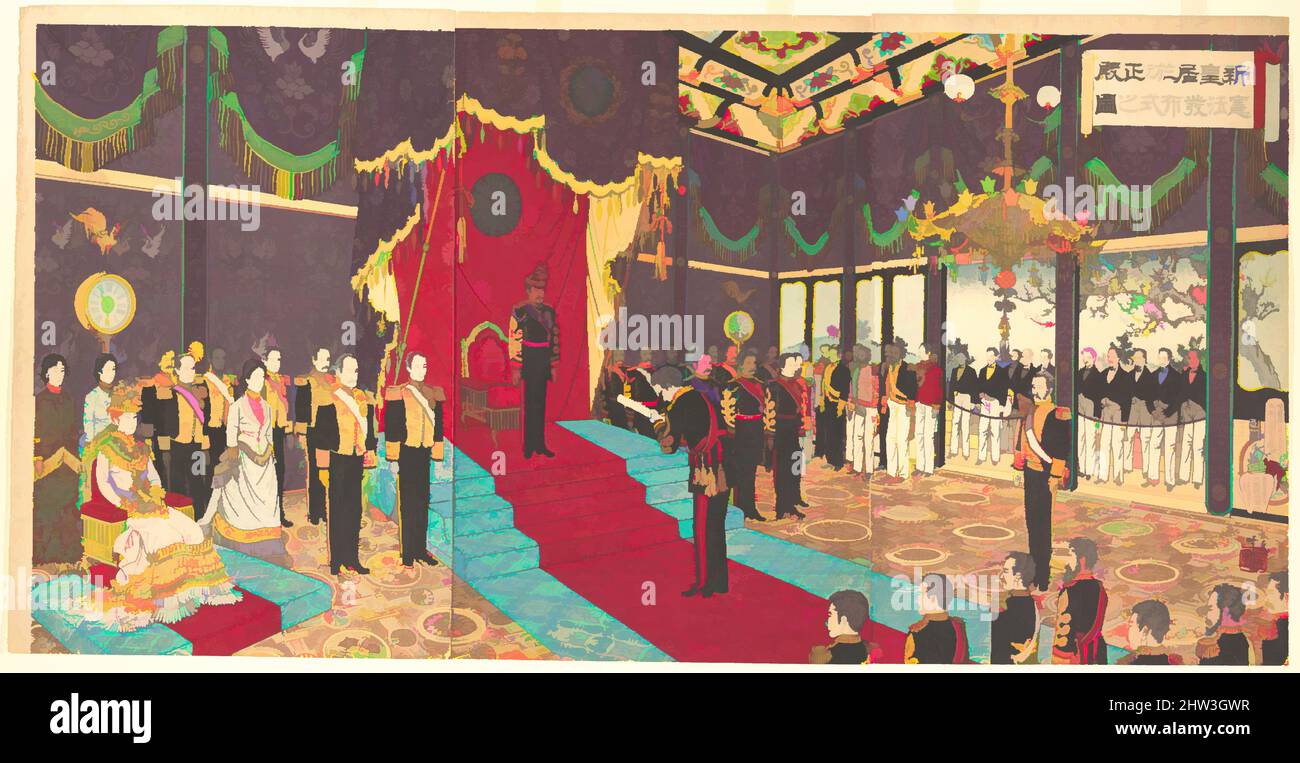 Art inspired by Shinkokyo Oite Seiden Kempo Happu no zu, View of the Issuance of the State Constitution in the State Chamber of the New Imperial Palace, Meiji period (1868–1912), March 2, 1889 (Meiji 22), Japan, One sheet of a triptych of polychrome woodblock prints; ink and color on, Classic works modernized by Artotop with a splash of modernity. Shapes, color and value, eye-catching visual impact on art. Emotions through freedom of artworks in a contemporary way. A timeless message pursuing a wildly creative new direction. Artists turning to the digital medium and creating the Artotop NFT Stock Photohttps://www.alamy.com/image-license-details/?v=1https://www.alamy.com/art-inspired-by-shinkokyo-oite-seiden-kempo-happu-no-zu-view-of-the-issuance-of-the-state-constitution-in-the-state-chamber-of-the-new-imperial-palace-meiji-period-18681912-march-2-1889-meiji-22-japan-one-sheet-of-a-triptych-of-polychrome-woodblock-prints-ink-and-color-on-classic-works-modernized-by-artotop-with-a-splash-of-modernity-shapes-color-and-value-eye-catching-visual-impact-on-art-emotions-through-freedom-of-artworks-in-a-contemporary-way-a-timeless-message-pursuing-a-wildly-creative-new-direction-artists-turning-to-the-digital-medium-and-creating-the-artotop-nft-image462915091.html
Art inspired by Shinkokyo Oite Seiden Kempo Happu no zu, View of the Issuance of the State Constitution in the State Chamber of the New Imperial Palace, Meiji period (1868–1912), March 2, 1889 (Meiji 22), Japan, One sheet of a triptych of polychrome woodblock prints; ink and color on, Classic works modernized by Artotop with a splash of modernity. Shapes, color and value, eye-catching visual impact on art. Emotions through freedom of artworks in a contemporary way. A timeless message pursuing a wildly creative new direction. Artists turning to the digital medium and creating the Artotop NFT Stock Photohttps://www.alamy.com/image-license-details/?v=1https://www.alamy.com/art-inspired-by-shinkokyo-oite-seiden-kempo-happu-no-zu-view-of-the-issuance-of-the-state-constitution-in-the-state-chamber-of-the-new-imperial-palace-meiji-period-18681912-march-2-1889-meiji-22-japan-one-sheet-of-a-triptych-of-polychrome-woodblock-prints-ink-and-color-on-classic-works-modernized-by-artotop-with-a-splash-of-modernity-shapes-color-and-value-eye-catching-visual-impact-on-art-emotions-through-freedom-of-artworks-in-a-contemporary-way-a-timeless-message-pursuing-a-wildly-creative-new-direction-artists-turning-to-the-digital-medium-and-creating-the-artotop-nft-image462915091.htmlRF2HW3GWR–Art inspired by Shinkokyo Oite Seiden Kempo Happu no zu, View of the Issuance of the State Constitution in the State Chamber of the New Imperial Palace, Meiji period (1868–1912), March 2, 1889 (Meiji 22), Japan, One sheet of a triptych of polychrome woodblock prints; ink and color on, Classic works modernized by Artotop with a splash of modernity. Shapes, color and value, eye-catching visual impact on art. Emotions through freedom of artworks in a contemporary way. A timeless message pursuing a wildly creative new direction. Artists turning to the digital medium and creating the Artotop NFT
 The Emperor Drilling Soldiers, Artist Machida Kyokukō (1879-1967), from old postcard of Meiji Memorial Picture Gallery Date of event 1874 (Meiji 7). Stock Photohttps://www.alamy.com/image-license-details/?v=1https://www.alamy.com/the-emperor-drilling-soldiers-artist-machida-kyokuk-1879-1967-from-old-postcard-of-meiji-memorial-picture-gallery-date-of-event-1874-meiji-7-image484676291.html
The Emperor Drilling Soldiers, Artist Machida Kyokukō (1879-1967), from old postcard of Meiji Memorial Picture Gallery Date of event 1874 (Meiji 7). Stock Photohttps://www.alamy.com/image-license-details/?v=1https://www.alamy.com/the-emperor-drilling-soldiers-artist-machida-kyokuk-1879-1967-from-old-postcard-of-meiji-memorial-picture-gallery-date-of-event-1874-meiji-7-image484676291.htmlRM2K4EWFF–The Emperor Drilling Soldiers, Artist Machida Kyokukō (1879-1967), from old postcard of Meiji Memorial Picture Gallery Date of event 1874 (Meiji 7).
 The Kyoto Imperial Palace is the former ruling palace of the Emperor of Japan. The Emperors have since resided at the Tokyo Imperial Palace after the Meiji Restoration in 1869, and the preservation of the Kyoto Imperial Palace was ordered in 1877 Stock Photohttps://www.alamy.com/image-license-details/?v=1https://www.alamy.com/the-kyoto-imperial-palace-is-the-former-ruling-palace-of-the-emperor-of-japan-the-emperors-have-since-resided-at-the-tokyo-imperial-palace-after-the-meiji-restoration-in-1869-and-the-preservation-of-the-kyoto-imperial-palace-was-ordered-in-1877-image328353759.html
The Kyoto Imperial Palace is the former ruling palace of the Emperor of Japan. The Emperors have since resided at the Tokyo Imperial Palace after the Meiji Restoration in 1869, and the preservation of the Kyoto Imperial Palace was ordered in 1877 Stock Photohttps://www.alamy.com/image-license-details/?v=1https://www.alamy.com/the-kyoto-imperial-palace-is-the-former-ruling-palace-of-the-emperor-of-japan-the-emperors-have-since-resided-at-the-tokyo-imperial-palace-after-the-meiji-restoration-in-1869-and-the-preservation-of-the-kyoto-imperial-palace-was-ordered-in-1877-image328353759.htmlRM2A25PFY–The Kyoto Imperial Palace is the former ruling palace of the Emperor of Japan. The Emperors have since resided at the Tokyo Imperial Palace after the Meiji Restoration in 1869, and the preservation of the Kyoto Imperial Palace was ordered in 1877
 Japan, Tokyo. circa 1890-1910 hand coloured postcard. The moat and the Sakuradamon, gate, tleading o the east Garden of the Imperial Palace. Stock Photohttps://www.alamy.com/image-license-details/?v=1https://www.alamy.com/stock-photo-japan-tokyo-circa-1890-1910-hand-coloured-postcard-the-moat-and-the-78370569.html
Japan, Tokyo. circa 1890-1910 hand coloured postcard. The moat and the Sakuradamon, gate, tleading o the east Garden of the Imperial Palace. Stock Photohttps://www.alamy.com/image-license-details/?v=1https://www.alamy.com/stock-photo-japan-tokyo-circa-1890-1910-hand-coloured-postcard-the-moat-and-the-78370569.htmlRMEFE2CW–Japan, Tokyo. circa 1890-1910 hand coloured postcard. The moat and the Sakuradamon, gate, tleading o the east Garden of the Imperial Palace.
 Akasaka State Guest House is a palace building built during the Meiji period as a residence for the future Emperor Taisho. It has been designated as a Stock Photohttps://www.alamy.com/image-license-details/?v=1https://www.alamy.com/akasaka-state-guest-house-isa-palace-building-built-during-the-meiji-period-as-a-residence-for-the-futureemperor-taisho-it-has-been-designated-as-a-image608993203.html
Akasaka State Guest House is a palace building built during the Meiji period as a residence for the future Emperor Taisho. It has been designated as a Stock Photohttps://www.alamy.com/image-license-details/?v=1https://www.alamy.com/akasaka-state-guest-house-isa-palace-building-built-during-the-meiji-period-as-a-residence-for-the-futureemperor-taisho-it-has-been-designated-as-a-image608993203.htmlRM2XAP117–Akasaka State Guest House is a palace building built during the Meiji period as a residence for the future Emperor Taisho. It has been designated as a
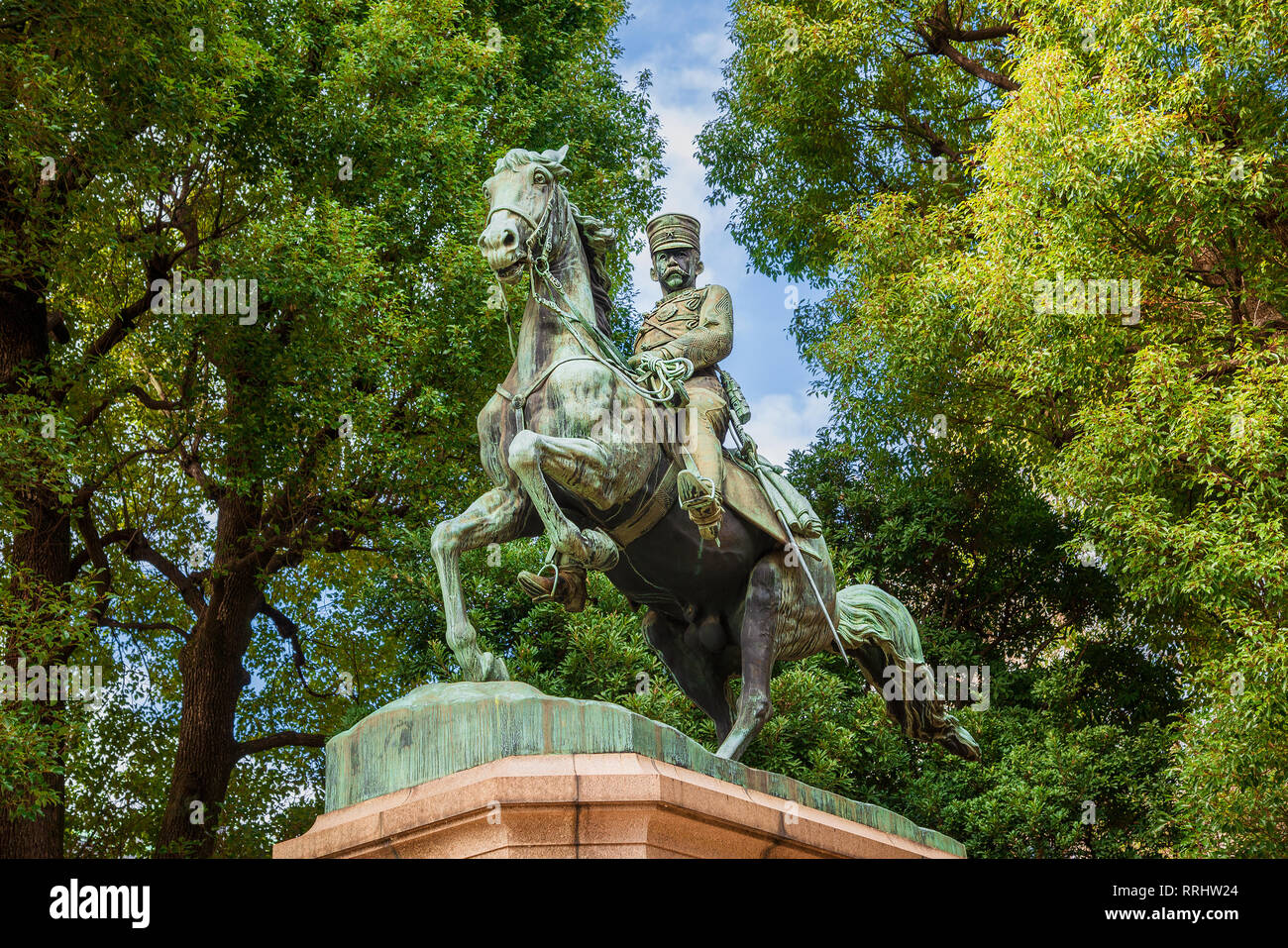 Prince Kitashirakawa Yoshihisa, Imperial Japanese Army general in Meiji Era. Bronze statue, erected in 1903 in Kitanomaru Parkm near Imperial Palace e Stock Photohttps://www.alamy.com/image-license-details/?v=1https://www.alamy.com/prince-kitashirakawa-yoshihisa-imperial-japanese-army-general-in-meiji-era-bronze-statue-erected-in-1903-in-kitanomaru-parkm-near-imperial-palace-e-image238264716.html
Prince Kitashirakawa Yoshihisa, Imperial Japanese Army general in Meiji Era. Bronze statue, erected in 1903 in Kitanomaru Parkm near Imperial Palace e Stock Photohttps://www.alamy.com/image-license-details/?v=1https://www.alamy.com/prince-kitashirakawa-yoshihisa-imperial-japanese-army-general-in-meiji-era-bronze-statue-erected-in-1903-in-kitanomaru-parkm-near-imperial-palace-e-image238264716.htmlRFRRHW24–Prince Kitashirakawa Yoshihisa, Imperial Japanese Army general in Meiji Era. Bronze statue, erected in 1903 in Kitanomaru Parkm near Imperial Palace e
 Chiyoda Inner Palace: No.20 Flower Arranging in Turn (Chiyoda no Ooku: Chanoyu mawaribana). Artist: Hashimoto Chikanobu (Japanese, 1838-1912). Culture: Japan. Dimensions: L. (page) 13 7/8 in. (35.2 cm); W. (page) 9 1/4 in. (23.4 cm). Date: August 1895. Museum: Metropolitan Museum of Art, New York, USA. Stock Photohttps://www.alamy.com/image-license-details/?v=1https://www.alamy.com/chiyoda-inner-palace-no20-flower-arranging-in-turn-chiyoda-no-ooku-chanoyu-mawaribana-artist-hashimoto-chikanobu-japanese-1838-1912-culture-japan-dimensions-l-page-13-78-in-352-cm-w-page-9-14-in-234-cm-date-august-1895-museum-metropolitan-museum-of-art-new-york-usa-image213154439.html
Chiyoda Inner Palace: No.20 Flower Arranging in Turn (Chiyoda no Ooku: Chanoyu mawaribana). Artist: Hashimoto Chikanobu (Japanese, 1838-1912). Culture: Japan. Dimensions: L. (page) 13 7/8 in. (35.2 cm); W. (page) 9 1/4 in. (23.4 cm). Date: August 1895. Museum: Metropolitan Museum of Art, New York, USA. Stock Photohttps://www.alamy.com/image-license-details/?v=1https://www.alamy.com/chiyoda-inner-palace-no20-flower-arranging-in-turn-chiyoda-no-ooku-chanoyu-mawaribana-artist-hashimoto-chikanobu-japanese-1838-1912-culture-japan-dimensions-l-page-13-78-in-352-cm-w-page-9-14-in-234-cm-date-august-1895-museum-metropolitan-museum-of-art-new-york-usa-image213154439.htmlRMPAP0JF–Chiyoda Inner Palace: No.20 Flower Arranging in Turn (Chiyoda no Ooku: Chanoyu mawaribana). Artist: Hashimoto Chikanobu (Japanese, 1838-1912). Culture: Japan. Dimensions: L. (page) 13 7/8 in. (35.2 cm); W. (page) 9 1/4 in. (23.4 cm). Date: August 1895. Museum: Metropolitan Museum of Art, New York, USA.
 A stationery box with chrysanthemum decoration and a representation of the Imperial Palace in Tokyo can be seen in the exhibition 'Pale Pink and Light Blue. Japanese Photography from the Meiji Period (1868-1912)' in the Berlin Museum for Photography in Berlin, Germany, 16 December 2015. The accompanying catalog was awarded the Photo Book Prize 2016 at the Stuttgart Book Week. It is only book in the category 'Photo History/Photo Theory' to be recognized with the distinction 'Winning title - Gold.' The exhibition can be seen until 10 January 2016. Photo: JENS KALAENE/ZB Stock Photohttps://www.alamy.com/image-license-details/?v=1https://www.alamy.com/stock-photo-a-stationery-box-with-chrysanthemum-decoration-and-a-representation-92038424.html
A stationery box with chrysanthemum decoration and a representation of the Imperial Palace in Tokyo can be seen in the exhibition 'Pale Pink and Light Blue. Japanese Photography from the Meiji Period (1868-1912)' in the Berlin Museum for Photography in Berlin, Germany, 16 December 2015. The accompanying catalog was awarded the Photo Book Prize 2016 at the Stuttgart Book Week. It is only book in the category 'Photo History/Photo Theory' to be recognized with the distinction 'Winning title - Gold.' The exhibition can be seen until 10 January 2016. Photo: JENS KALAENE/ZB Stock Photohttps://www.alamy.com/image-license-details/?v=1https://www.alamy.com/stock-photo-a-stationery-box-with-chrysanthemum-decoration-and-a-representation-92038424.htmlRMF9MKXG–A stationery box with chrysanthemum decoration and a representation of the Imperial Palace in Tokyo can be seen in the exhibition 'Pale Pink and Light Blue. Japanese Photography from the Meiji Period (1868-1912)' in the Berlin Museum for Photography in Berlin, Germany, 16 December 2015. The accompanying catalog was awarded the Photo Book Prize 2016 at the Stuttgart Book Week. It is only book in the category 'Photo History/Photo Theory' to be recognized with the distinction 'Winning title - Gold.' The exhibition can be seen until 10 January 2016. Photo: JENS KALAENE/ZB
 19th century vintage photograph: The Kyoto Imperial Palace is the former ruling palace of the Emperor of Japan. Since the Meiji Restoration in 1869, the Emperors have resided at the Tokyo Imperial Palace, while the preservation of the Kyoto Imperial Palace was ordered in 1877. Stock Photohttps://www.alamy.com/image-license-details/?v=1https://www.alamy.com/19th-century-vintage-photograph-the-kyoto-imperial-palace-is-the-former-ruling-palace-of-the-emperor-of-japan-since-the-meiji-restoration-in-1869-the-emperors-have-resided-at-the-tokyo-imperial-palace-while-the-preservation-of-the-kyoto-imperial-palace-was-ordered-in-1877-image397964364.html
19th century vintage photograph: The Kyoto Imperial Palace is the former ruling palace of the Emperor of Japan. Since the Meiji Restoration in 1869, the Emperors have resided at the Tokyo Imperial Palace, while the preservation of the Kyoto Imperial Palace was ordered in 1877. Stock Photohttps://www.alamy.com/image-license-details/?v=1https://www.alamy.com/19th-century-vintage-photograph-the-kyoto-imperial-palace-is-the-former-ruling-palace-of-the-emperor-of-japan-since-the-meiji-restoration-in-1869-the-emperors-have-resided-at-the-tokyo-imperial-palace-while-the-preservation-of-the-kyoto-imperial-palace-was-ordered-in-1877-image397964364.htmlRM2E3CRH0–19th century vintage photograph: The Kyoto Imperial Palace is the former ruling palace of the Emperor of Japan. Since the Meiji Restoration in 1869, the Emperors have resided at the Tokyo Imperial Palace, while the preservation of the Kyoto Imperial Palace was ordered in 1877.
 View of the Suwa-no-Chaya teahouse, an elegant structure ordered by Emperor Meiji and placed in Ninomaru garden at Tokyo Imperial Palace East Gardens Stock Photohttps://www.alamy.com/image-license-details/?v=1https://www.alamy.com/view-of-the-suwa-no-chaya-teahouse-an-elegant-structure-ordered-by-emperor-meiji-and-placed-in-ninomaru-garden-at-tokyo-imperial-palace-east-gardens-image230495813.html
View of the Suwa-no-Chaya teahouse, an elegant structure ordered by Emperor Meiji and placed in Ninomaru garden at Tokyo Imperial Palace East Gardens Stock Photohttps://www.alamy.com/image-license-details/?v=1https://www.alamy.com/view-of-the-suwa-no-chaya-teahouse-an-elegant-structure-ordered-by-emperor-meiji-and-placed-in-ninomaru-garden-at-tokyo-imperial-palace-east-gardens-image230495813.htmlRFRAYYN9–View of the Suwa-no-Chaya teahouse, an elegant structure ordered by Emperor Meiji and placed in Ninomaru garden at Tokyo Imperial Palace East Gardens
 Old Edo Castle Tokyo Imperial Palace, Chiyoda Ward, Tokyo, Japan Stock Photohttps://www.alamy.com/image-license-details/?v=1https://www.alamy.com/old-edo-castle-tokyo-imperial-palace-chiyoda-ward-tokyo-japan-image353429669.html
Old Edo Castle Tokyo Imperial Palace, Chiyoda Ward, Tokyo, Japan Stock Photohttps://www.alamy.com/image-license-details/?v=1https://www.alamy.com/old-edo-castle-tokyo-imperial-palace-chiyoda-ward-tokyo-japan-image353429669.htmlRF2BF0345–Old Edo Castle Tokyo Imperial Palace, Chiyoda Ward, Tokyo, Japan
 The Inner Palace of Chiyoda (Chiyoda no ?oku) 1895 Y?sh? (Hashimoto) Chikanobu Japanese. The Inner Palace of Chiyoda (Chiyoda no ?oku). Y?sh? (Hashimoto) Chikanobu (Japanese, 1838–1912). Japan. 1895. Diptych of woodblock prints; ink and color on paper. Meiji period (1868–1912). Prints Stock Photohttps://www.alamy.com/image-license-details/?v=1https://www.alamy.com/the-inner-palace-of-chiyoda-chiyoda-no-oku-1895-ysh-hashimoto-chikanobu-japanese-the-inner-palace-of-chiyoda-chiyoda-no-oku-ysh-hashimoto-chikanobu-japanese-18381912-japan-1895-diptych-of-woodblock-prints-ink-and-color-on-paper-meiji-period-18681912-prints-image458041952.html
The Inner Palace of Chiyoda (Chiyoda no ?oku) 1895 Y?sh? (Hashimoto) Chikanobu Japanese. The Inner Palace of Chiyoda (Chiyoda no ?oku). Y?sh? (Hashimoto) Chikanobu (Japanese, 1838–1912). Japan. 1895. Diptych of woodblock prints; ink and color on paper. Meiji period (1868–1912). Prints Stock Photohttps://www.alamy.com/image-license-details/?v=1https://www.alamy.com/the-inner-palace-of-chiyoda-chiyoda-no-oku-1895-ysh-hashimoto-chikanobu-japanese-the-inner-palace-of-chiyoda-chiyoda-no-oku-ysh-hashimoto-chikanobu-japanese-18381912-japan-1895-diptych-of-woodblock-prints-ink-and-color-on-paper-meiji-period-18681912-prints-image458041952.htmlRM2HH5H54–The Inner Palace of Chiyoda (Chiyoda no ?oku) 1895 Y?sh? (Hashimoto) Chikanobu Japanese. The Inner Palace of Chiyoda (Chiyoda no ?oku). Y?sh? (Hashimoto) Chikanobu (Japanese, 1838–1912). Japan. 1895. Diptych of woodblock prints; ink and color on paper. Meiji period (1868–1912). Prints
 This is the vain building of the Nijo-Castle Imperial detached Palace of Tokyo where is the Imperial ouaters of H.I.M. the Emperor Kwangte of Manchukuo during his sojourn in Kyoto. This historical wooden building was built by Hideyoshi Taiko in 16th century at first and burning several times tilt. the Meiji restoration age. This is the unique wooden Palacial building now ***** as the national treasury. March 06, 1935. (Photo by The Shimbun Rengo News Photos Service). Stock Photohttps://www.alamy.com/image-license-details/?v=1https://www.alamy.com/this-is-the-vain-building-of-the-nijo-castle-imperial-detached-palace-of-tokyo-where-is-the-imperial-ouaters-of-him-the-emperor-kwangte-of-manchukuo-during-his-sojourn-in-kyoto-this-historical-wooden-building-was-built-by-hideyoshi-taiko-in-16th-century-at-first-and-burning-several-times-tilt-the-meiji-restoration-age-this-is-the-unique-wooden-palacial-building-now-as-the-national-treasury-march-06-1935-photo-by-the-shimbun-rengo-news-photos-service-image467218852.html
This is the vain building of the Nijo-Castle Imperial detached Palace of Tokyo where is the Imperial ouaters of H.I.M. the Emperor Kwangte of Manchukuo during his sojourn in Kyoto. This historical wooden building was built by Hideyoshi Taiko in 16th century at first and burning several times tilt. the Meiji restoration age. This is the unique wooden Palacial building now ***** as the national treasury. March 06, 1935. (Photo by The Shimbun Rengo News Photos Service). Stock Photohttps://www.alamy.com/image-license-details/?v=1https://www.alamy.com/this-is-the-vain-building-of-the-nijo-castle-imperial-detached-palace-of-tokyo-where-is-the-imperial-ouaters-of-him-the-emperor-kwangte-of-manchukuo-during-his-sojourn-in-kyoto-this-historical-wooden-building-was-built-by-hideyoshi-taiko-in-16th-century-at-first-and-burning-several-times-tilt-the-meiji-restoration-age-this-is-the-unique-wooden-palacial-building-now-as-the-national-treasury-march-06-1935-photo-by-the-shimbun-rengo-news-photos-service-image467218852.htmlRM2J43JBG–This is the vain building of the Nijo-Castle Imperial detached Palace of Tokyo where is the Imperial ouaters of H.I.M. the Emperor Kwangte of Manchukuo during his sojourn in Kyoto. This historical wooden building was built by Hideyoshi Taiko in 16th century at first and burning several times tilt. the Meiji restoration age. This is the unique wooden Palacial building now ***** as the national treasury. March 06, 1935. (Photo by The Shimbun Rengo News Photos Service).
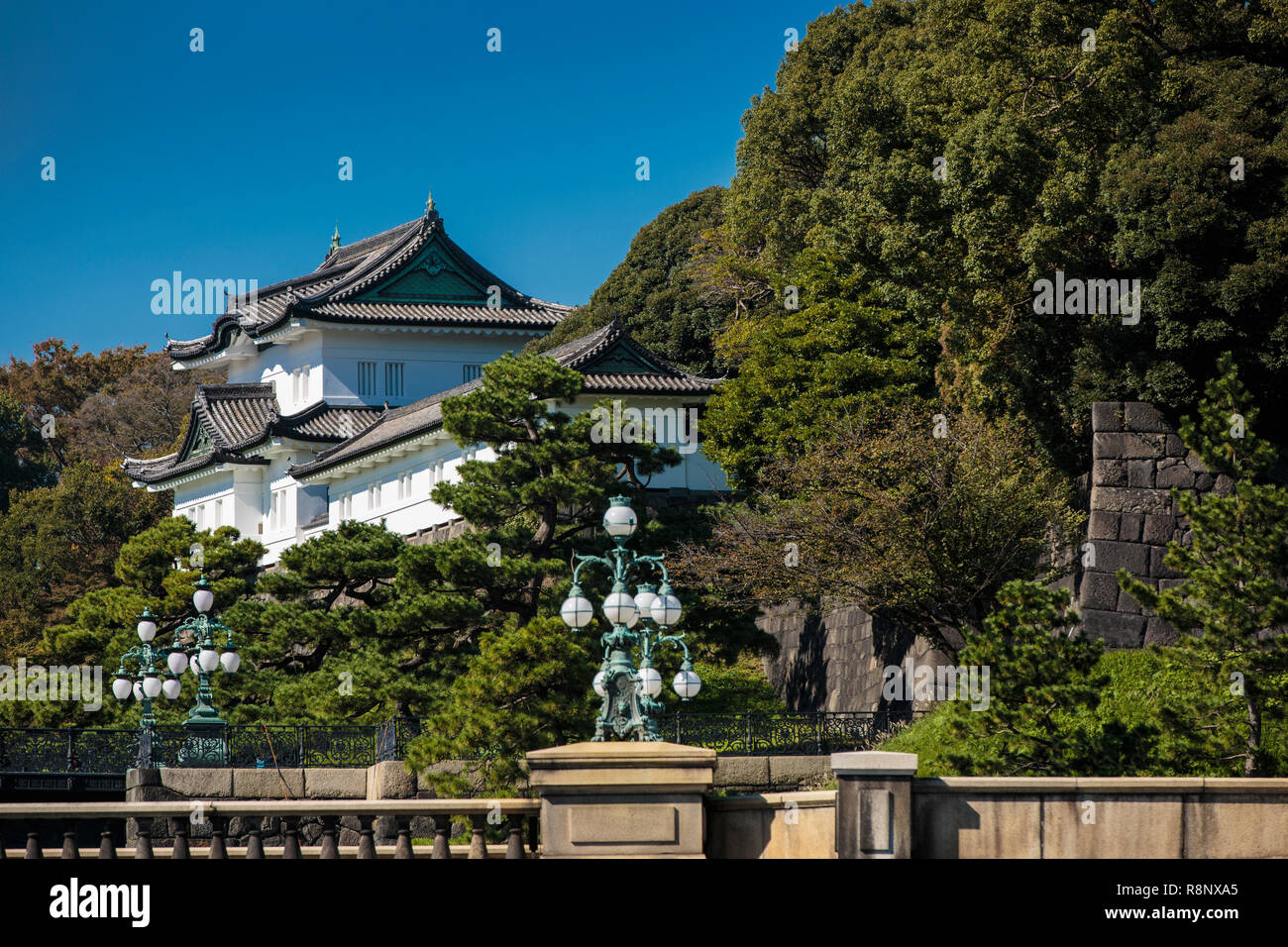 The Tokyo Imperial Palace Stock Photohttps://www.alamy.com/image-license-details/?v=1https://www.alamy.com/the-tokyo-imperial-palace-image229133693.html
The Tokyo Imperial Palace Stock Photohttps://www.alamy.com/image-license-details/?v=1https://www.alamy.com/the-tokyo-imperial-palace-image229133693.htmlRFR8NXA5–The Tokyo Imperial Palace
 facade view of Fukuyama Castle Tenshu in japan Stock Photohttps://www.alamy.com/image-license-details/?v=1https://www.alamy.com/facade-view-of-fukuyama-castle-tenshu-in-japan-image226289917.html
facade view of Fukuyama Castle Tenshu in japan Stock Photohttps://www.alamy.com/image-license-details/?v=1https://www.alamy.com/facade-view-of-fukuyama-castle-tenshu-in-japan-image226289917.htmlRFR44B2N–facade view of Fukuyama Castle Tenshu in japan
 . English: The Imperial Palace (Meiji palace) audience hall. The audience hall was the central part of the palace. It was the largest building in where honoured guests were received and public events. The floor space was a little more than 223 tsubo (1 tsubo is 3.306 m²). In the interior, the coffered ceiling was traditional Japanese-style, while the floor was parquetry without any traditional dividing sliding doors in the western style. The roof was styled just like in the Kyoto Imperial Palace, but unlike there the roof was not covered in Japanese cypress shingles but with copper plates in o Stock Photohttps://www.alamy.com/image-license-details/?v=1https://www.alamy.com/english-the-imperial-palace-meiji-palace-audience-hall-the-audience-hall-was-the-central-part-of-the-palace-it-was-the-largest-building-in-where-honoured-guests-were-received-and-public-events-the-floor-space-was-a-little-more-than-223-tsubo-1-tsubo-is-3306m-in-the-interior-the-coffered-ceiling-was-traditional-japanese-style-while-the-floor-was-parquetry-without-any-traditional-dividing-sliding-doors-in-the-western-style-the-roof-was-styled-just-like-in-the-kyoto-imperial-palace-but-unlike-there-the-roof-was-not-covered-in-japanese-cypress-shingles-but-with-copper-plates-in-o-image188763044.html
. English: The Imperial Palace (Meiji palace) audience hall. The audience hall was the central part of the palace. It was the largest building in where honoured guests were received and public events. The floor space was a little more than 223 tsubo (1 tsubo is 3.306 m²). In the interior, the coffered ceiling was traditional Japanese-style, while the floor was parquetry without any traditional dividing sliding doors in the western style. The roof was styled just like in the Kyoto Imperial Palace, but unlike there the roof was not covered in Japanese cypress shingles but with copper plates in o Stock Photohttps://www.alamy.com/image-license-details/?v=1https://www.alamy.com/english-the-imperial-palace-meiji-palace-audience-hall-the-audience-hall-was-the-central-part-of-the-palace-it-was-the-largest-building-in-where-honoured-guests-were-received-and-public-events-the-floor-space-was-a-little-more-than-223-tsubo-1-tsubo-is-3306m-in-the-interior-the-coffered-ceiling-was-traditional-japanese-style-while-the-floor-was-parquetry-without-any-traditional-dividing-sliding-doors-in-the-western-style-the-roof-was-styled-just-like-in-the-kyoto-imperial-palace-but-unlike-there-the-roof-was-not-covered-in-japanese-cypress-shingles-but-with-copper-plates-in-o-image188763044.htmlRMMY2W58–. English: The Imperial Palace (Meiji palace) audience hall. The audience hall was the central part of the palace. It was the largest building in where honoured guests were received and public events. The floor space was a little more than 223 tsubo (1 tsubo is 3.306 m²). In the interior, the coffered ceiling was traditional Japanese-style, while the floor was parquetry without any traditional dividing sliding doors in the western style. The roof was styled just like in the Kyoto Imperial Palace, but unlike there the roof was not covered in Japanese cypress shingles but with copper plates in o
![[ 1910s Japan - Western-style Buildings in Marunouchi, Tokyo ] — View on Marunouchi “Londontown” and Babasakimon from the Imperial Palace in Tokyo. The building on the left is the Bankers’ Club, on the right the Metropolitan Police Board. The first buildings were built in this former swampland in 1894 (Meiji 27). When Tokyo Station was opened in 1914 (Taisho 3), it became Tokyo’s premier business address. 20th century vintage postcard. Stock Photo [ 1910s Japan - Western-style Buildings in Marunouchi, Tokyo ] — View on Marunouchi “Londontown” and Babasakimon from the Imperial Palace in Tokyo. The building on the left is the Bankers’ Club, on the right the Metropolitan Police Board. The first buildings were built in this former swampland in 1894 (Meiji 27). When Tokyo Station was opened in 1914 (Taisho 3), it became Tokyo’s premier business address. 20th century vintage postcard. Stock Photo](https://c8.alamy.com/comp/2BKT1F4/1910s-japan-western-style-buildings-in-marunouchi-tokyo-view-on-marunouchi-londontown-and-babasakimon-from-the-imperial-palace-in-tokyo-the-building-on-the-left-is-the-bankers-club-on-the-right-the-metropolitan-police-board-the-first-buildings-were-built-in-this-former-swampland-in-1894-meiji-27-when-tokyo-station-was-opened-in-1914-taisho-3-it-became-tokyos-premier-business-address-20th-century-vintage-postcard-2BKT1F4.jpg) [ 1910s Japan - Western-style Buildings in Marunouchi, Tokyo ] — View on Marunouchi “Londontown” and Babasakimon from the Imperial Palace in Tokyo. The building on the left is the Bankers’ Club, on the right the Metropolitan Police Board. The first buildings were built in this former swampland in 1894 (Meiji 27). When Tokyo Station was opened in 1914 (Taisho 3), it became Tokyo’s premier business address. 20th century vintage postcard. Stock Photohttps://www.alamy.com/image-license-details/?v=1https://www.alamy.com/1910s-japan-western-style-buildings-in-marunouchi-tokyo-view-on-marunouchi-londontown-and-babasakimon-from-the-imperial-palace-in-tokyo-the-building-on-the-left-is-the-bankers-club-on-the-right-the-metropolitan-police-board-the-first-buildings-were-built-in-this-former-swampland-in-1894-meiji-27-when-tokyo-station-was-opened-in-1914-taisho-3-it-became-tokyos-premier-business-address-20th-century-vintage-postcard-image356413880.html
[ 1910s Japan - Western-style Buildings in Marunouchi, Tokyo ] — View on Marunouchi “Londontown” and Babasakimon from the Imperial Palace in Tokyo. The building on the left is the Bankers’ Club, on the right the Metropolitan Police Board. The first buildings were built in this former swampland in 1894 (Meiji 27). When Tokyo Station was opened in 1914 (Taisho 3), it became Tokyo’s premier business address. 20th century vintage postcard. Stock Photohttps://www.alamy.com/image-license-details/?v=1https://www.alamy.com/1910s-japan-western-style-buildings-in-marunouchi-tokyo-view-on-marunouchi-londontown-and-babasakimon-from-the-imperial-palace-in-tokyo-the-building-on-the-left-is-the-bankers-club-on-the-right-the-metropolitan-police-board-the-first-buildings-were-built-in-this-former-swampland-in-1894-meiji-27-when-tokyo-station-was-opened-in-1914-taisho-3-it-became-tokyos-premier-business-address-20th-century-vintage-postcard-image356413880.htmlRM2BKT1F4–[ 1910s Japan - Western-style Buildings in Marunouchi, Tokyo ] — View on Marunouchi “Londontown” and Babasakimon from the Imperial Palace in Tokyo. The building on the left is the Bankers’ Club, on the right the Metropolitan Police Board. The first buildings were built in this former swampland in 1894 (Meiji 27). When Tokyo Station was opened in 1914 (Taisho 3), it became Tokyo’s premier business address. 20th century vintage postcard.
 Vintage 19th century photograph - Imperial Palace beside Lake Hakone, Japan Stock Photohttps://www.alamy.com/image-license-details/?v=1https://www.alamy.com/vintage-19th-century-photograph-imperial-palace-beside-lake-hakone-japan-image560793327.html
Vintage 19th century photograph - Imperial Palace beside Lake Hakone, Japan Stock Photohttps://www.alamy.com/image-license-details/?v=1https://www.alamy.com/vintage-19th-century-photograph-imperial-palace-beside-lake-hakone-japan-image560793327.htmlRM2RGA9H3–Vintage 19th century photograph - Imperial Palace beside Lake Hakone, Japan
 Takiyasha the Witch and the Skeleton Spectre is a woodblock print by the Japanese artist Utagawa Kuniyoshi (1798-1861), who was especially renowned for his depictions of historical and mythical scenes. This print portrays tenth-century princess Takiyasha summoning a skeleton spectre to frighten Mitsukuni. The princess is reciting a spell written on a handscroll. She summons up a giant skeleton which comes rearing out of a terrifying black void, crashing its way through the tattered palace blinds with its bony fingers to menace Mitsukuni and his companion. Princess Takiyasha was the daughter o Stock Photohttps://www.alamy.com/image-license-details/?v=1https://www.alamy.com/takiyasha-the-witch-and-the-skeleton-spectre-is-a-woodblock-print-by-the-japanese-artist-utagawa-kuniyoshi-1798-1861-who-was-especially-renowned-for-his-depictions-of-historical-and-mythical-scenes-this-print-portrays-tenth-century-princess-takiyasha-summoning-a-skeleton-spectre-to-frighten-mitsukuni-the-princess-is-reciting-a-spell-written-on-a-handscroll-she-summons-up-a-giant-skeleton-which-comes-rearing-out-of-a-terrifying-black-void-crashing-its-way-through-the-tattered-palace-blinds-with-its-bony-fingers-to-menace-mitsukuni-and-his-companion-princess-takiyasha-was-the-daughter-o-image344278544.html
Takiyasha the Witch and the Skeleton Spectre is a woodblock print by the Japanese artist Utagawa Kuniyoshi (1798-1861), who was especially renowned for his depictions of historical and mythical scenes. This print portrays tenth-century princess Takiyasha summoning a skeleton spectre to frighten Mitsukuni. The princess is reciting a spell written on a handscroll. She summons up a giant skeleton which comes rearing out of a terrifying black void, crashing its way through the tattered palace blinds with its bony fingers to menace Mitsukuni and his companion. Princess Takiyasha was the daughter o Stock Photohttps://www.alamy.com/image-license-details/?v=1https://www.alamy.com/takiyasha-the-witch-and-the-skeleton-spectre-is-a-woodblock-print-by-the-japanese-artist-utagawa-kuniyoshi-1798-1861-who-was-especially-renowned-for-his-depictions-of-historical-and-mythical-scenes-this-print-portrays-tenth-century-princess-takiyasha-summoning-a-skeleton-spectre-to-frighten-mitsukuni-the-princess-is-reciting-a-spell-written-on-a-handscroll-she-summons-up-a-giant-skeleton-which-comes-rearing-out-of-a-terrifying-black-void-crashing-its-way-through-the-tattered-palace-blinds-with-its-bony-fingers-to-menace-mitsukuni-and-his-companion-princess-takiyasha-was-the-daughter-o-image344278544.htmlRM2B036P8–Takiyasha the Witch and the Skeleton Spectre is a woodblock print by the Japanese artist Utagawa Kuniyoshi (1798-1861), who was especially renowned for his depictions of historical and mythical scenes. This print portrays tenth-century princess Takiyasha summoning a skeleton spectre to frighten Mitsukuni. The princess is reciting a spell written on a handscroll. She summons up a giant skeleton which comes rearing out of a terrifying black void, crashing its way through the tattered palace blinds with its bony fingers to menace Mitsukuni and his companion. Princess Takiyasha was the daughter o
 Art inspired by Autumn foliage at the New Imperial Palace, Meiji period (1868–1912), 1888 (Meiji 21, 11th month), Japan, Triptych of polychrome woodblock prints; ink and color on paper, Oban; 14 1/2 x 28 1/4 in. (36.8 x 71.8 cm), Prints, Unidentified Artist, Classic works modernized by Artotop with a splash of modernity. Shapes, color and value, eye-catching visual impact on art. Emotions through freedom of artworks in a contemporary way. A timeless message pursuing a wildly creative new direction. Artists turning to the digital medium and creating the Artotop NFT Stock Photohttps://www.alamy.com/image-license-details/?v=1https://www.alamy.com/art-inspired-by-autumn-foliage-at-the-new-imperial-palace-meiji-period-18681912-1888-meiji-21-11th-month-japan-triptych-of-polychrome-woodblock-prints-ink-and-color-on-paper-oban-14-12-x-28-14-in-368-x-718-cm-prints-unidentified-artist-classic-works-modernized-by-artotop-with-a-splash-of-modernity-shapes-color-and-value-eye-catching-visual-impact-on-art-emotions-through-freedom-of-artworks-in-a-contemporary-way-a-timeless-message-pursuing-a-wildly-creative-new-direction-artists-turning-to-the-digital-medium-and-creating-the-artotop-nft-image462916165.html
Art inspired by Autumn foliage at the New Imperial Palace, Meiji period (1868–1912), 1888 (Meiji 21, 11th month), Japan, Triptych of polychrome woodblock prints; ink and color on paper, Oban; 14 1/2 x 28 1/4 in. (36.8 x 71.8 cm), Prints, Unidentified Artist, Classic works modernized by Artotop with a splash of modernity. Shapes, color and value, eye-catching visual impact on art. Emotions through freedom of artworks in a contemporary way. A timeless message pursuing a wildly creative new direction. Artists turning to the digital medium and creating the Artotop NFT Stock Photohttps://www.alamy.com/image-license-details/?v=1https://www.alamy.com/art-inspired-by-autumn-foliage-at-the-new-imperial-palace-meiji-period-18681912-1888-meiji-21-11th-month-japan-triptych-of-polychrome-woodblock-prints-ink-and-color-on-paper-oban-14-12-x-28-14-in-368-x-718-cm-prints-unidentified-artist-classic-works-modernized-by-artotop-with-a-splash-of-modernity-shapes-color-and-value-eye-catching-visual-impact-on-art-emotions-through-freedom-of-artworks-in-a-contemporary-way-a-timeless-message-pursuing-a-wildly-creative-new-direction-artists-turning-to-the-digital-medium-and-creating-the-artotop-nft-image462916165.htmlRF2HW3J85–Art inspired by Autumn foliage at the New Imperial Palace, Meiji period (1868–1912), 1888 (Meiji 21, 11th month), Japan, Triptych of polychrome woodblock prints; ink and color on paper, Oban; 14 1/2 x 28 1/4 in. (36.8 x 71.8 cm), Prints, Unidentified Artist, Classic works modernized by Artotop with a splash of modernity. Shapes, color and value, eye-catching visual impact on art. Emotions through freedom of artworks in a contemporary way. A timeless message pursuing a wildly creative new direction. Artists turning to the digital medium and creating the Artotop NFT